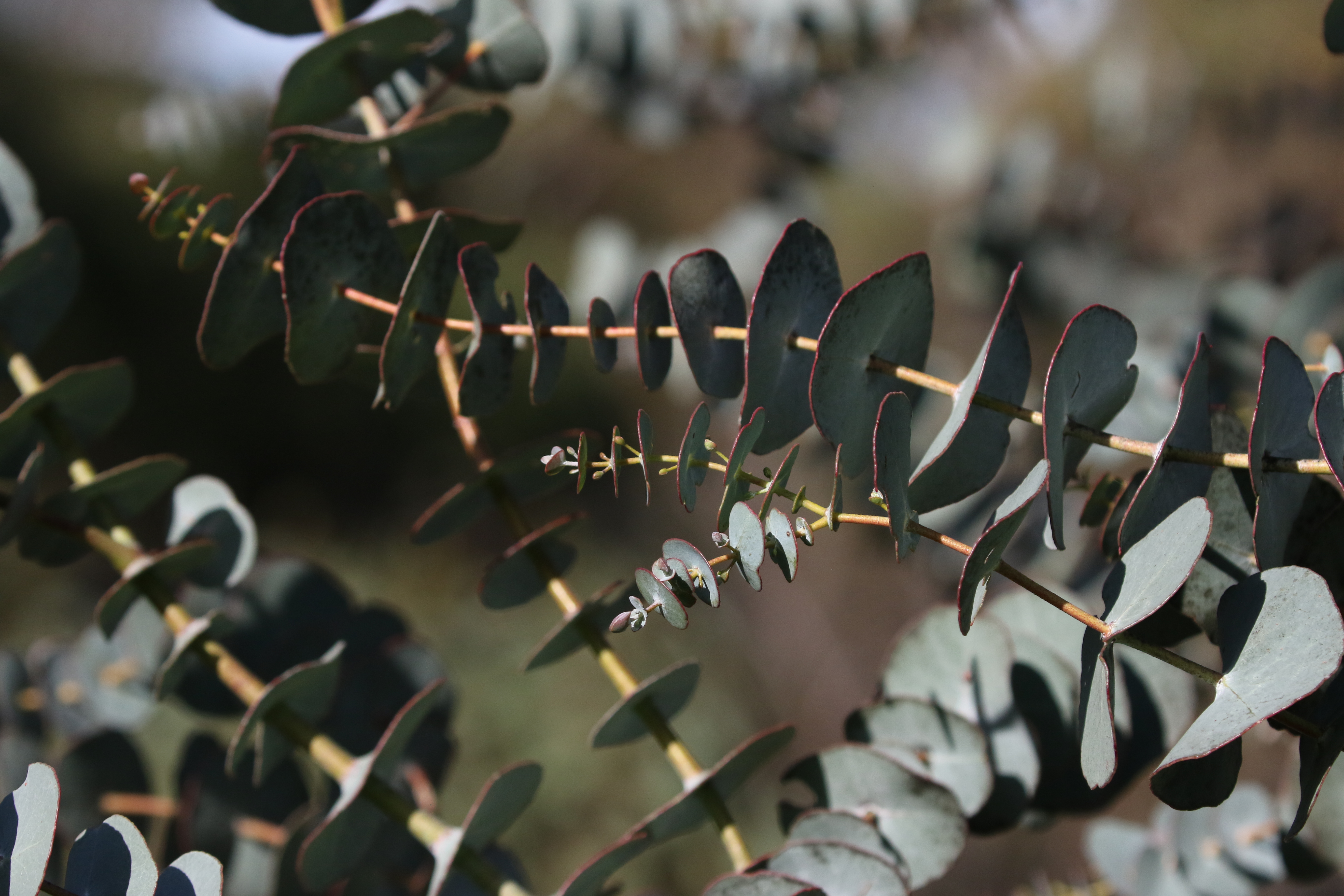inbox and environment news: Issue 574
March 5 - 11 2023: Issue 574
Avalon Dunes Bushcare Returns Sunday March 5th
Next will be on March 5, meeting at 8.30 in the parking area off Tasman Rd south.
We work until 11.30 but any time you can spare is wonderful.
We always find interesting insects and other wildlife. We can see the progress happening as we work in this corner of the 4.5ha dunes.
Call in to say hello or phone 0420 817 574 if you can't see us there.
New helpers very welcome, and there's always something yummy for morning tea.
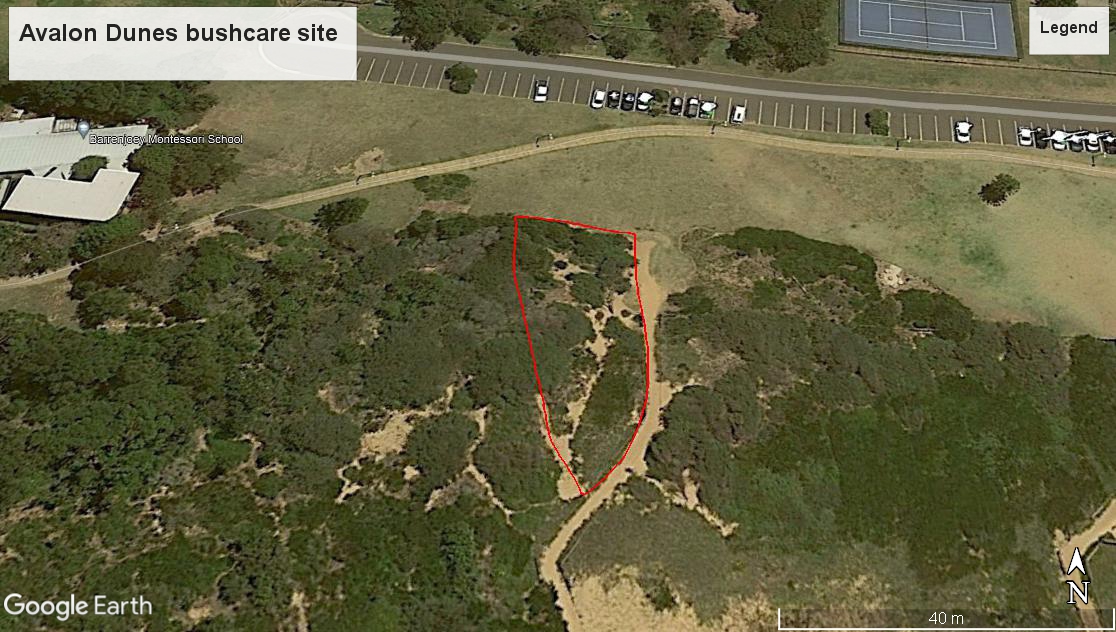
Our bushcare area is within the red lines. We can work in the shade in summer, or in sun in winter. Barrenjoey High school is to the north.
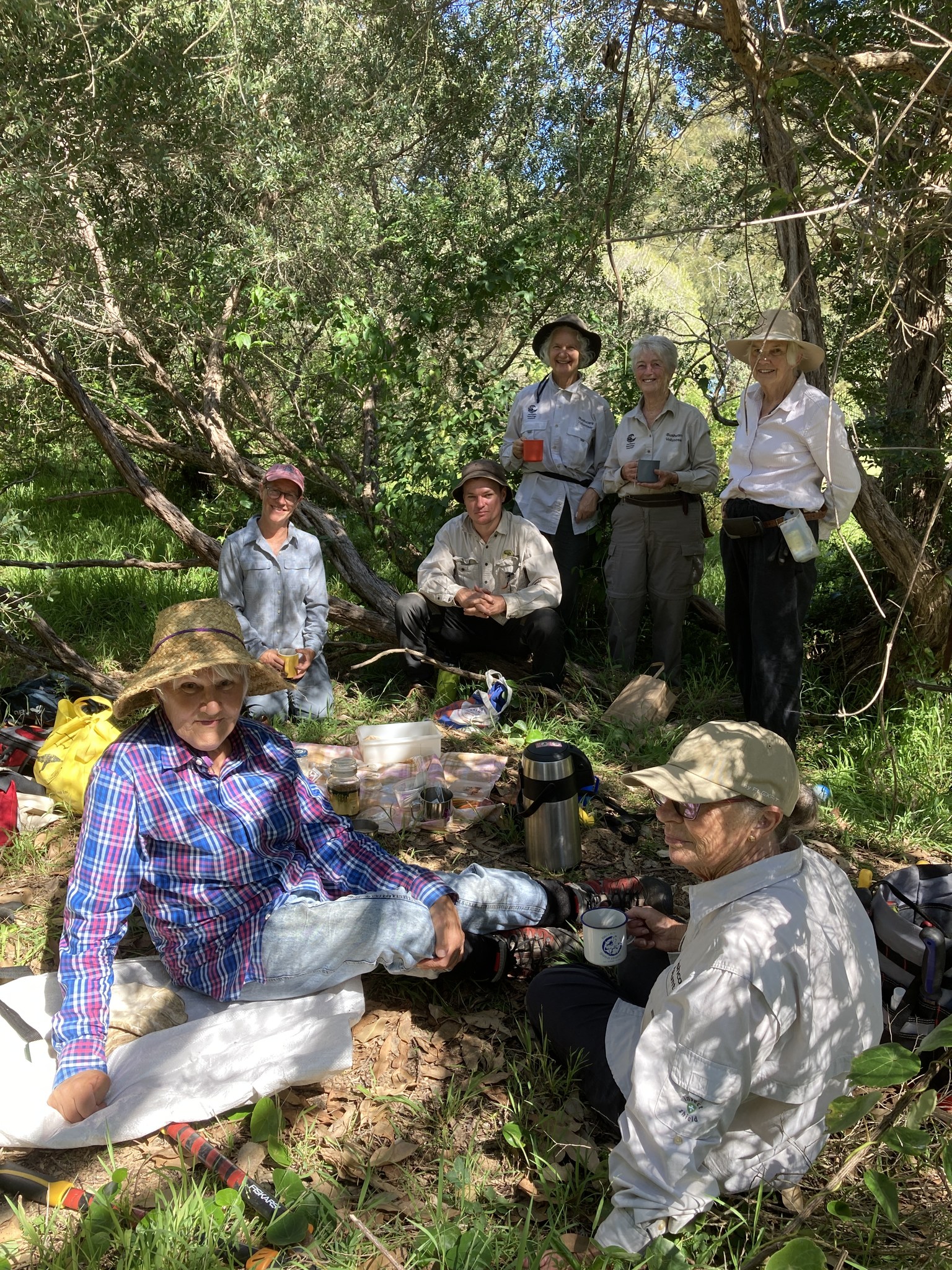
Morning tea with good company and cake.
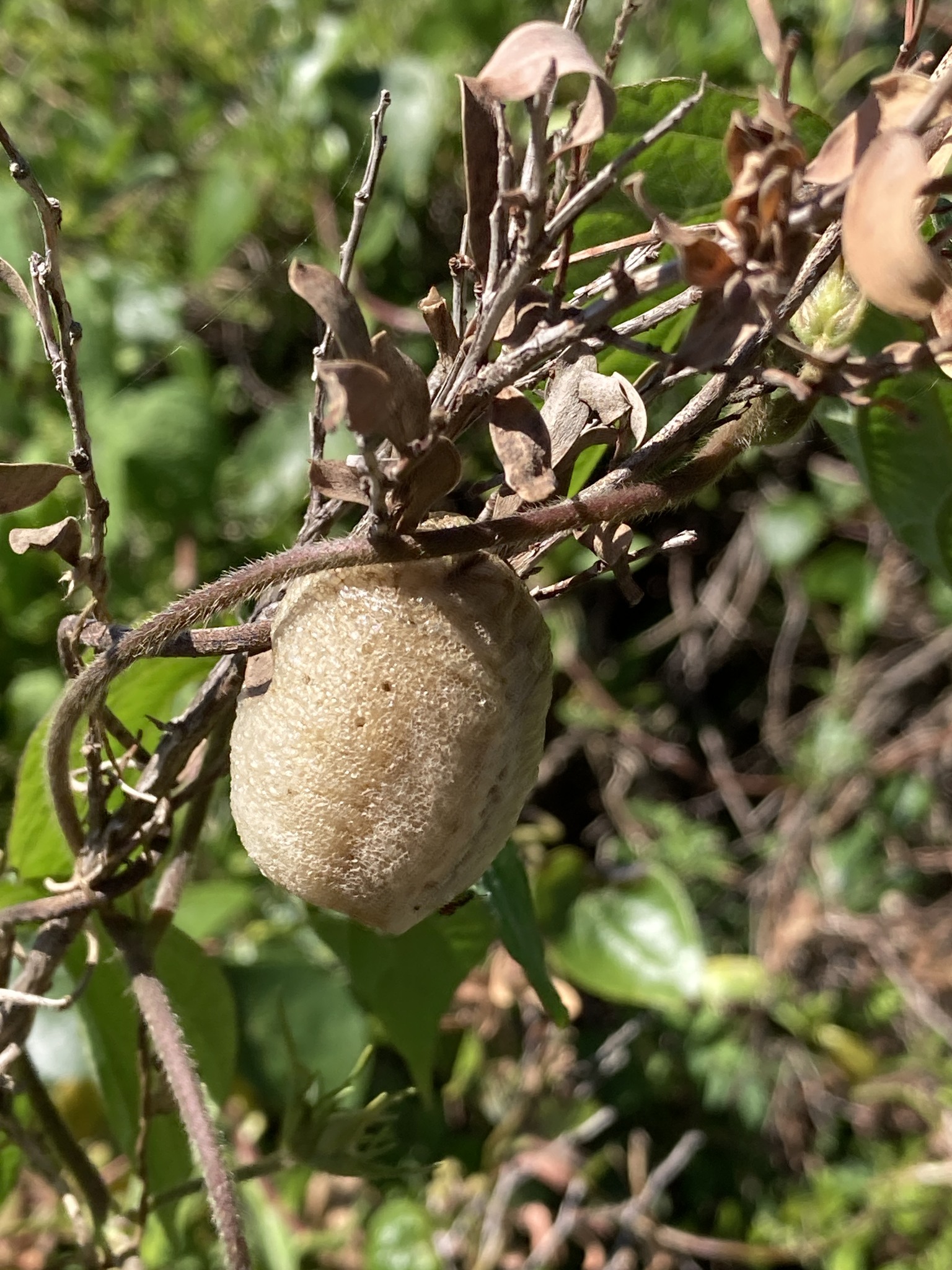
The egg case or ootheca of a Praying Mantis. Each ootheca contains a number of eggs, up to 200 with some species. Mantis eggs can take anywhere from 40 days to around five months to hatch. On hatching, the baby mantises are about as big as a large ant. The tiny holes on this one suggest the eggs have hatched.
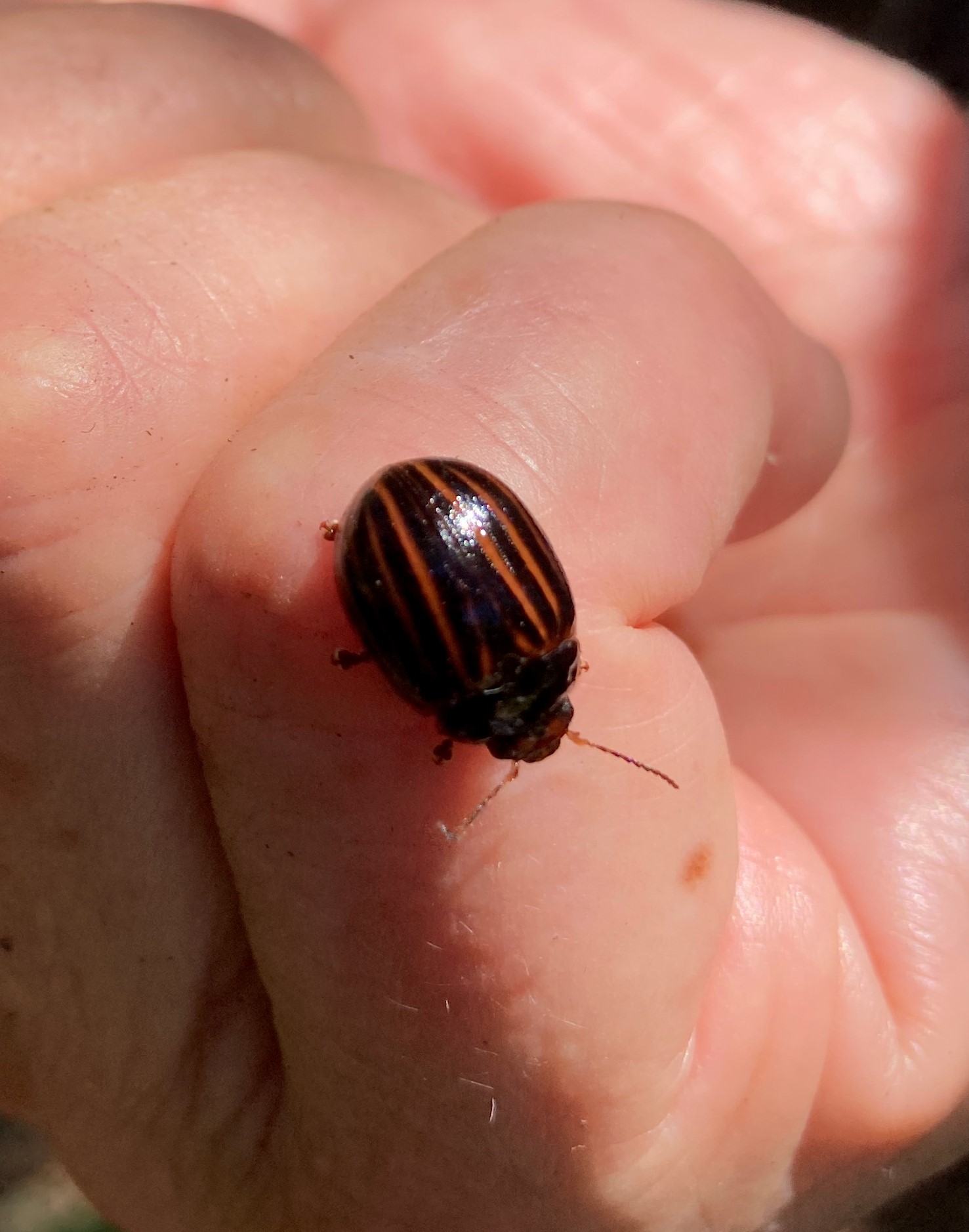
This Leaf Beetle in the genus Paropsisterna. It has been feeding on Eucalypt or Acacia foliage. It is one of Australia's many beetles. The total species number is estimated to be in the range of 80,000 to 100,000.
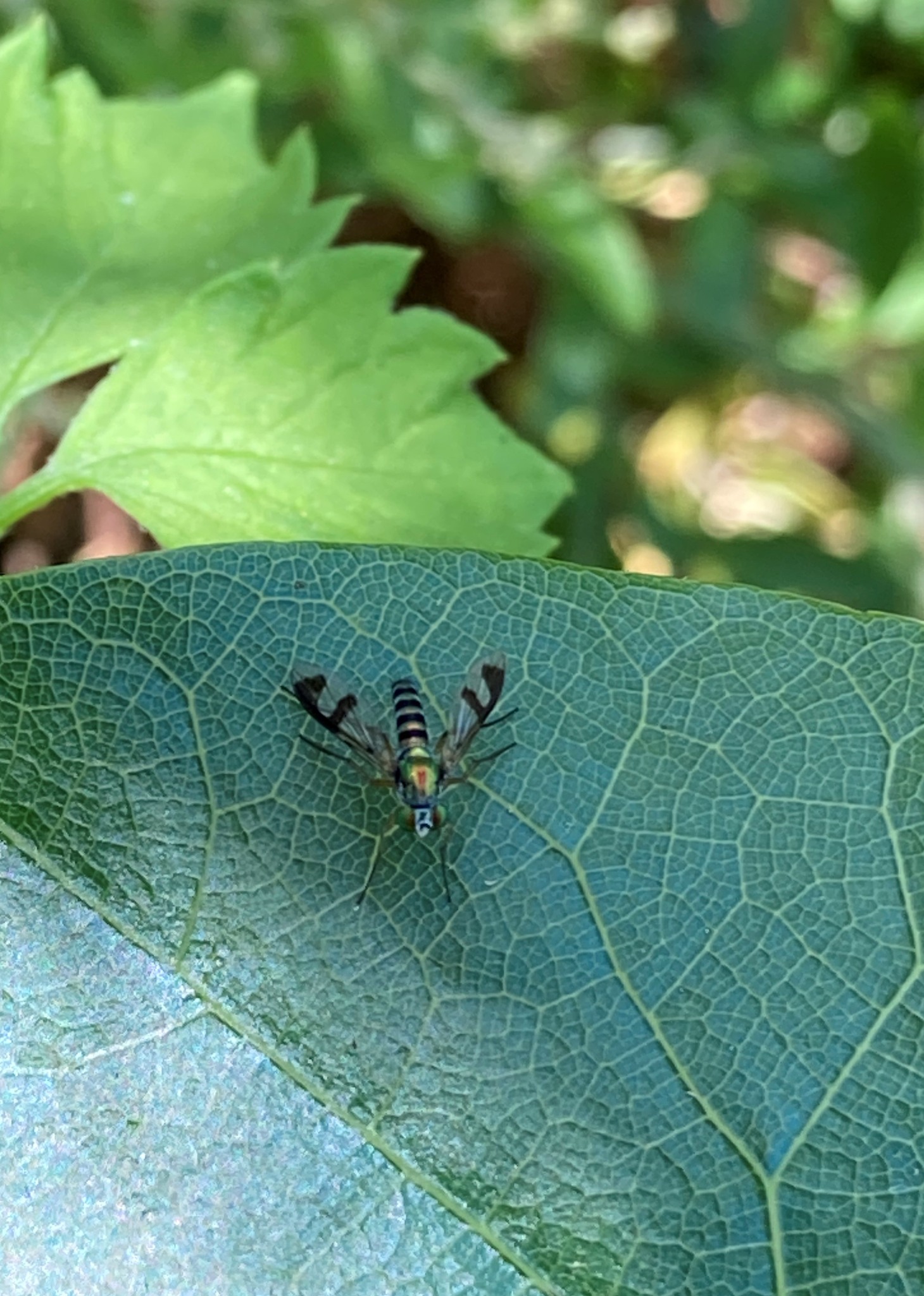
A long-legged Dancing Fly pauses on a leaf of Snake Vine.
Photos; PNHA
Priorities? The Wildlife Exclusion Fences On The Wakehurst Parkway Are In A Terrible State Of Repair
Since 2007, the Department of Transport and the then Warringah Council have funded wildlife exclusion fences along the Wakehurst Parkway.
Initially these fences were in perfect condition. A new tender has been awarded recently for the maintenance of the wildlife exclusion fences.
Subsequent floods down Middle Creek have flattened the fences multiple times.
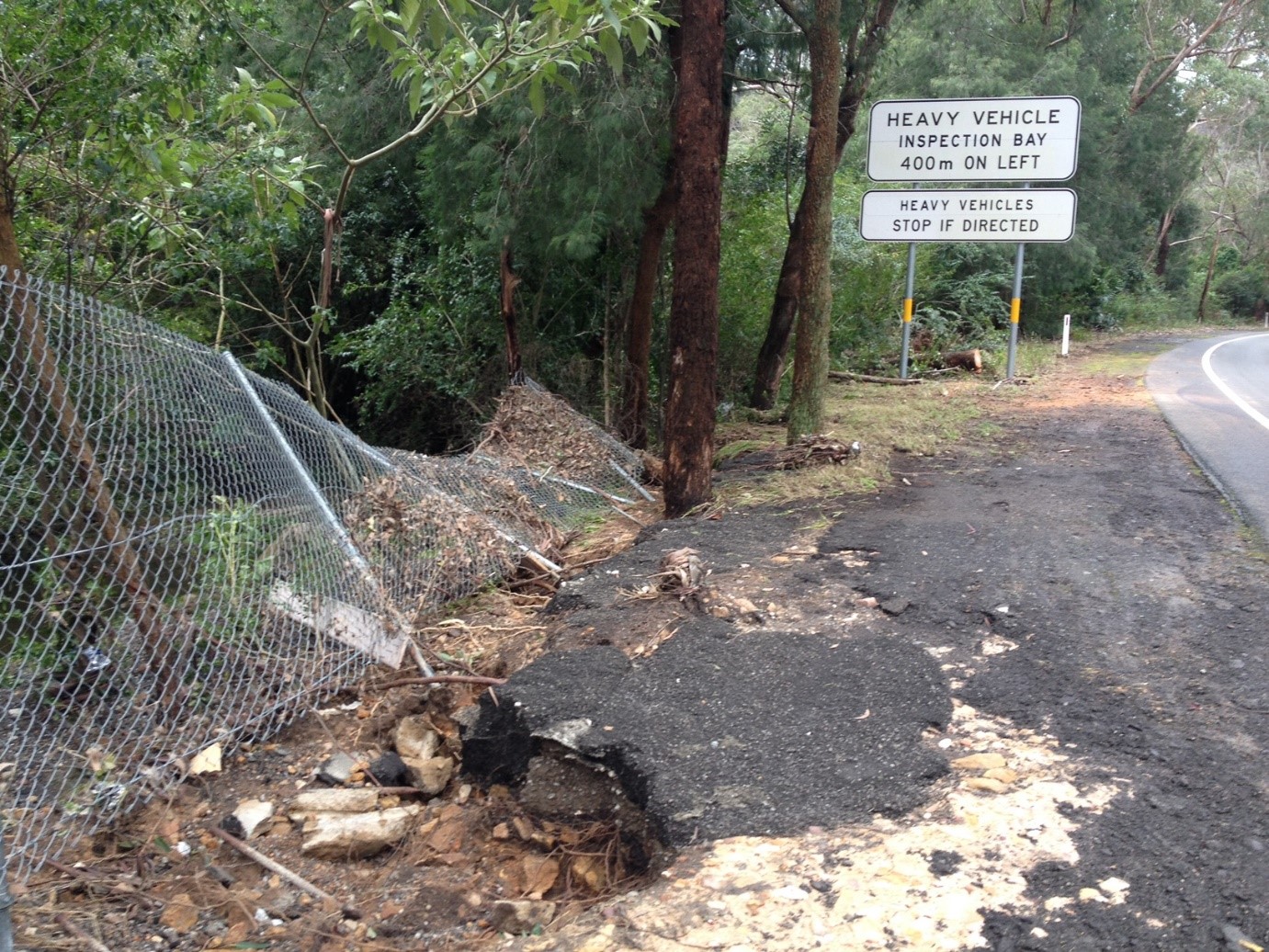
Trees have fallen on them. Cars have driven through them. The wildlife exclusion fences are in a terrible state of disrepair.
Every time the fences are damaged, wildlife can get onto the road where the wildlife may be injured or killed.
These fences are important. This map marks the swamp wallaby roadkill on the Wakehurst Parkway for 2021 to 2023.
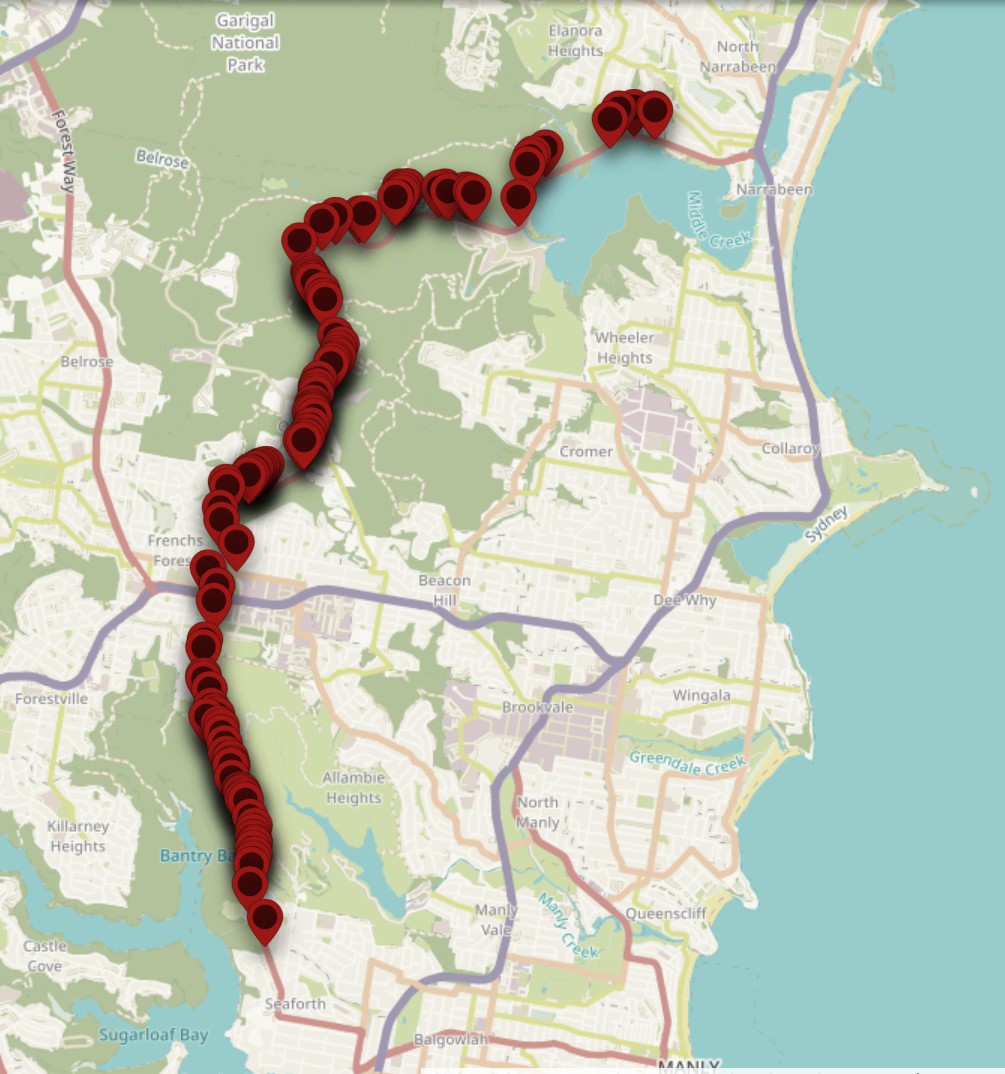
Many other animals such as owls, echidnas, and possums have also been killed.
Wallabies are unpredictable animals and dash out onto the road unexpectedly. Are we prepared to risk a human life from a head-on collision swerving to avoid an animal?
The Wakehurst Parkway wildlife exclusion fences need to be maintained regularly by the road contractors. There needs to be a plan for the temporary repair of fences when they are breached.
The exclusion fence has been flattened near Middle Creek Bridge where a car ran off the road in early February. The earliest the road contractors can repair the fence is 19 May 2023.
The Roadkill Prevention Group have temporarily repaired the fence at personal expense.
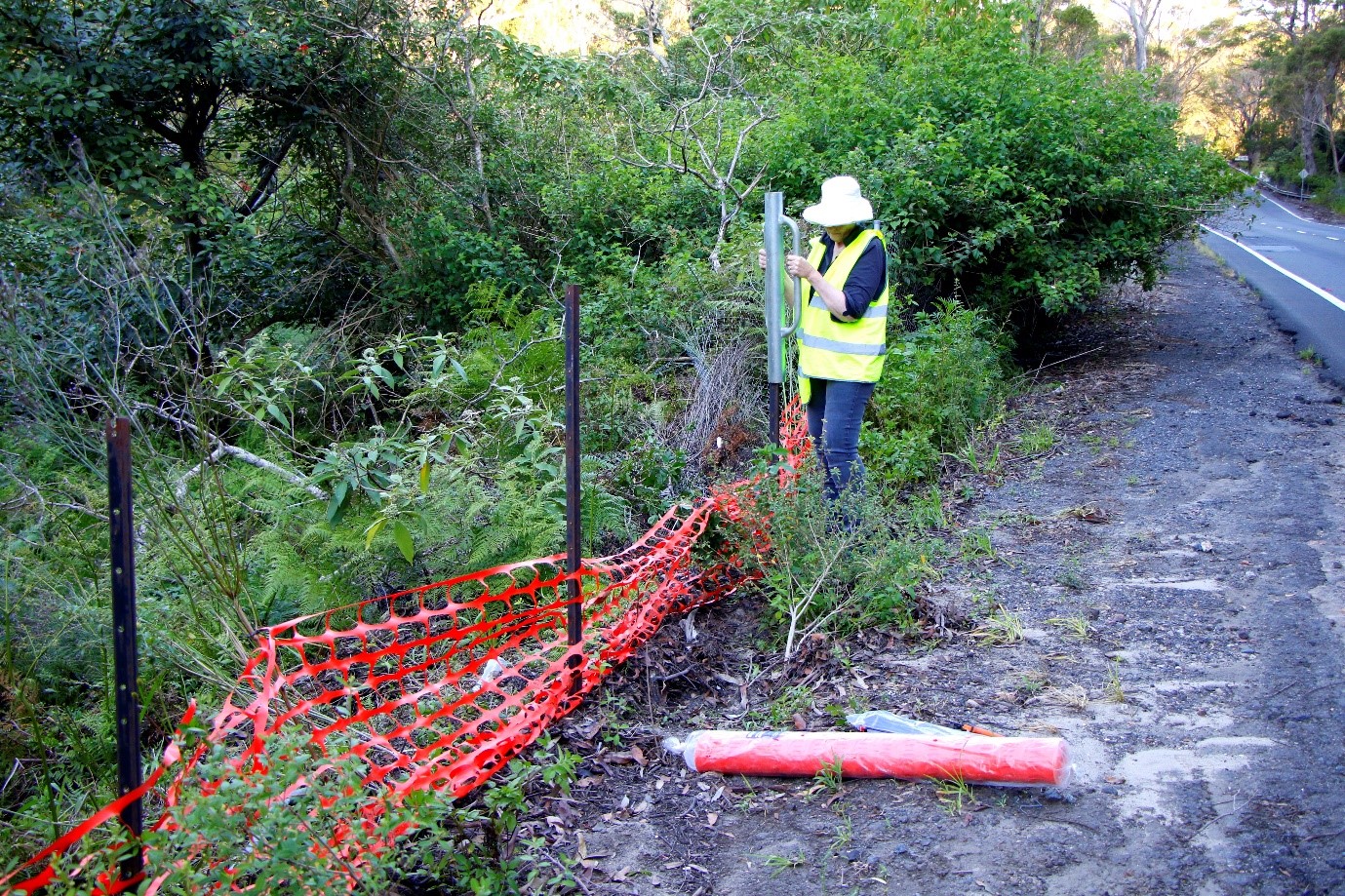
When will we see a resolution with the road maintenance contractors for a quick response to repair and maintain the roadkill exclusion fences?
Jacqui Marlow
Northern Beaches Roadkill Prevention Committee
The Northern Beaches Roadkill Prevention Committee aims to reduce roadkill of native animals on the Northern Beaches of Sydney, Australia. In 2005, the association was formed to address wildlife roadkill and raise awareness of broader conservation issues on Sydney's Northern Beaches.
Jacqueline Marlow
Jacqui has been working on preserving bushland, increasing connectivity and preventing roadkill on the major arterial roads of the Northern Beaches of Sydney since 2001. In 2005 she set up an effective community group that records roadkill on a purpose designed phone app. The resulting long-term records of roadkill on the Northern Beaches of Sydney have been used by the RMS in planning roadkill mitigation for the future upgrade of Mona Vale Road. She holds a Batchelor of Science from Sydney University and is a member of numerous scientific organisations such as the Mammal Society of Australia and is also the author of peer-reviewed articles on roadkill.
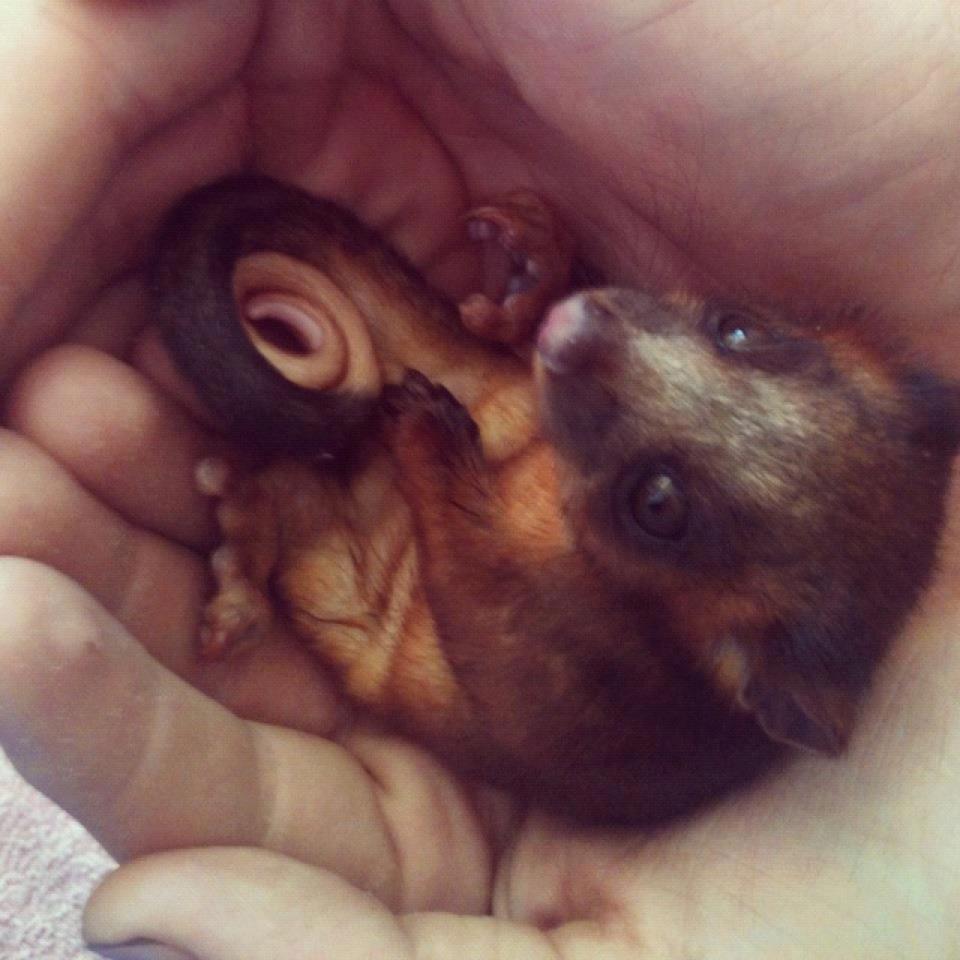
This beautiful little baby ringtail is now without mother due to road kill on the Northern Beaches. This has to stop!
Photo: Roadkill Prevention Committee
Swamp Wallaby At Palm Beach
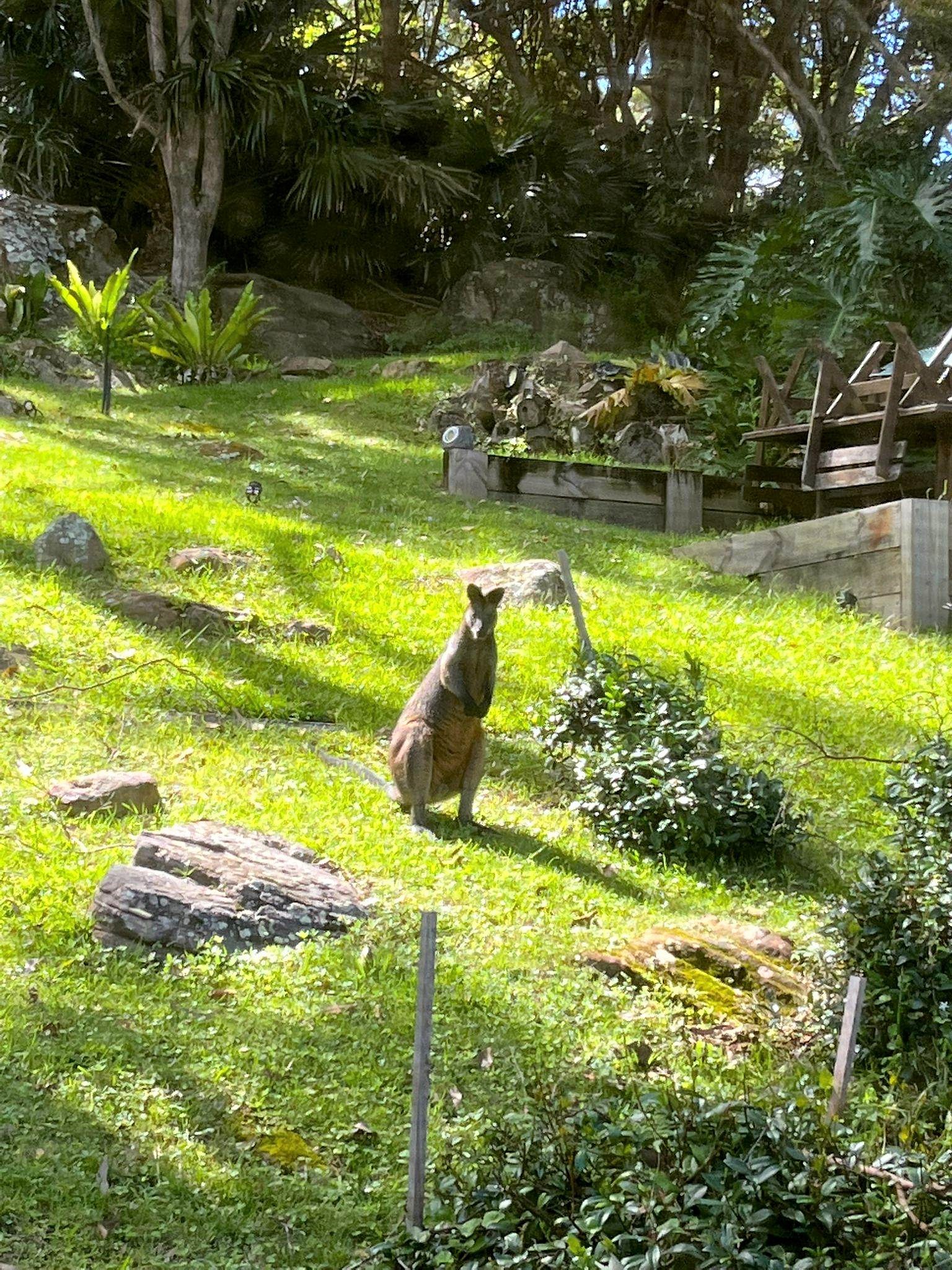
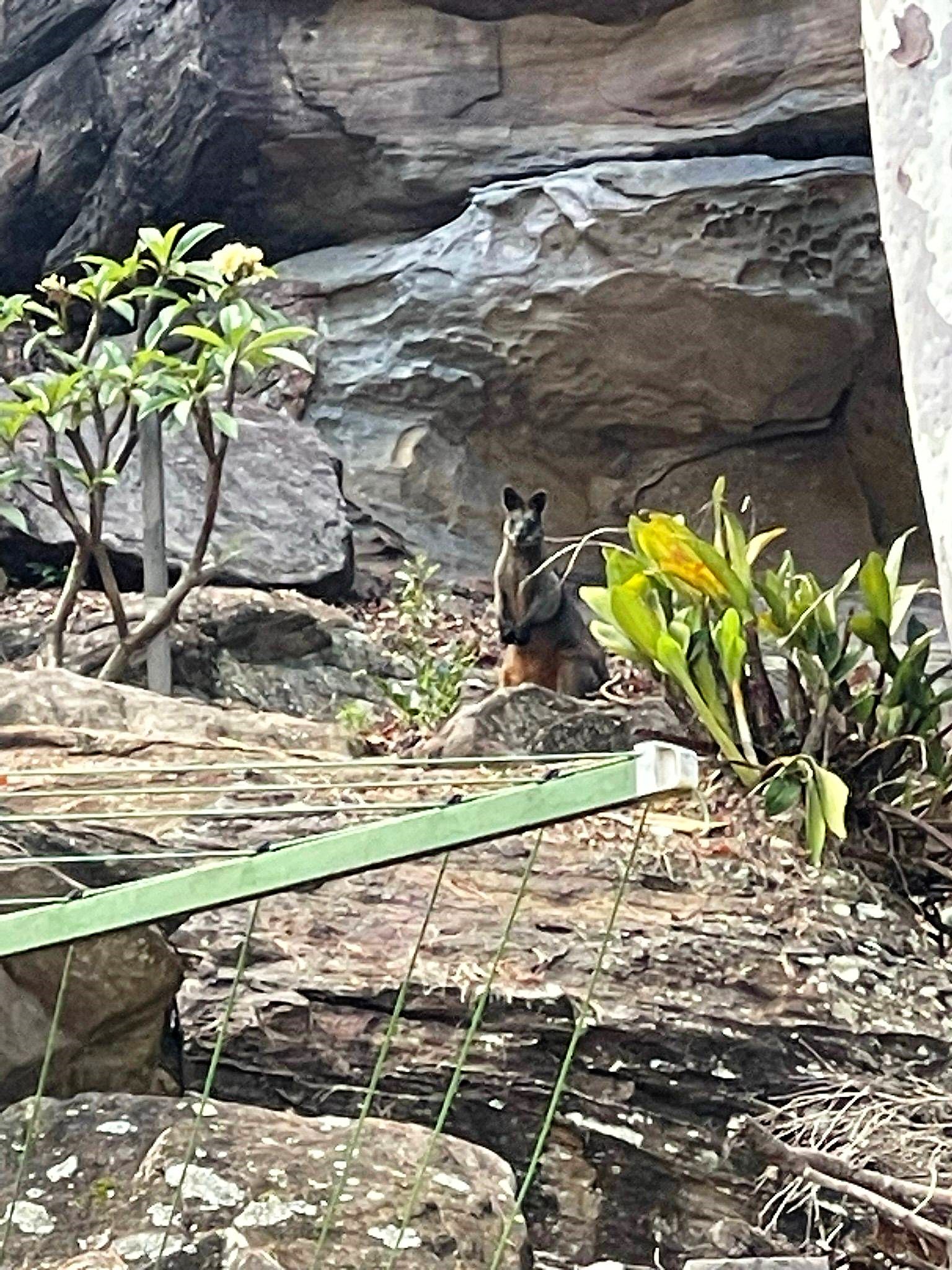
Cat Owners Encouraged To Keep Their Pets Safe At Home
Wednesday, 1 March 2023
Northern Beaches residents are being encouraged to keep their pets safe at home as part of a new animal protection campaign.
According to RSPCA NSW, two out of three cat owners have lost a cat to a roaming-related accident, and one in three to a car accident. Northern Beaches Council is proud to be one of 11 councils partnering with RSPCA NSW as part of the Keeping Cats Safe at Home project.
Promoting responsible ownership, the new campaign goes beyond desexing and micro chipping of beloved cats and asks owners to consider keeping their cats at home.
Northern Beaches CEO Ray Brownlee said there’s a dual benefit to cats and local wildlife that flows directly from promoting responsible ownership of domesticated cats.
“Northern Beaches residents love their pets, but they’re also passionate about protecting the local environment,” Mr Brownlee said.
“Because pet cats occupy a special place in our hearts we need to educate the community on how have them microchip and desexed to keep them safe. This initiative has an educational focus. It aims to protect tiny native species like lizards, mammals, baby birds and frogs, while also preventing domesticated cats from falling prey to road accidents.”
In 2021, the NSW Government awarded a $2.5 million grant from the NSW Environmental Trust to RSPCA NSW to deliver the project.
To help promote the campaign, Council is asking cat-lovers living on the Northern Beaches to submit a photo of their cat or kitten living their best life at home and go in the draw to win one of 10 $1000 vouchers for a deluxe outdoor cat enclosure from Catnets. The competition opens on March 1st and closes on Sunday April 9th 2023. Finalists will be published in an online gallery.
For competition details visit www.northernbeaches.nsw.gov.au/environment/non-native-animals/cats/competition-keeping-cats-safe-home
Learn more about keeping cats safe at www.rspcansw.org.au/keeping-cats-safe
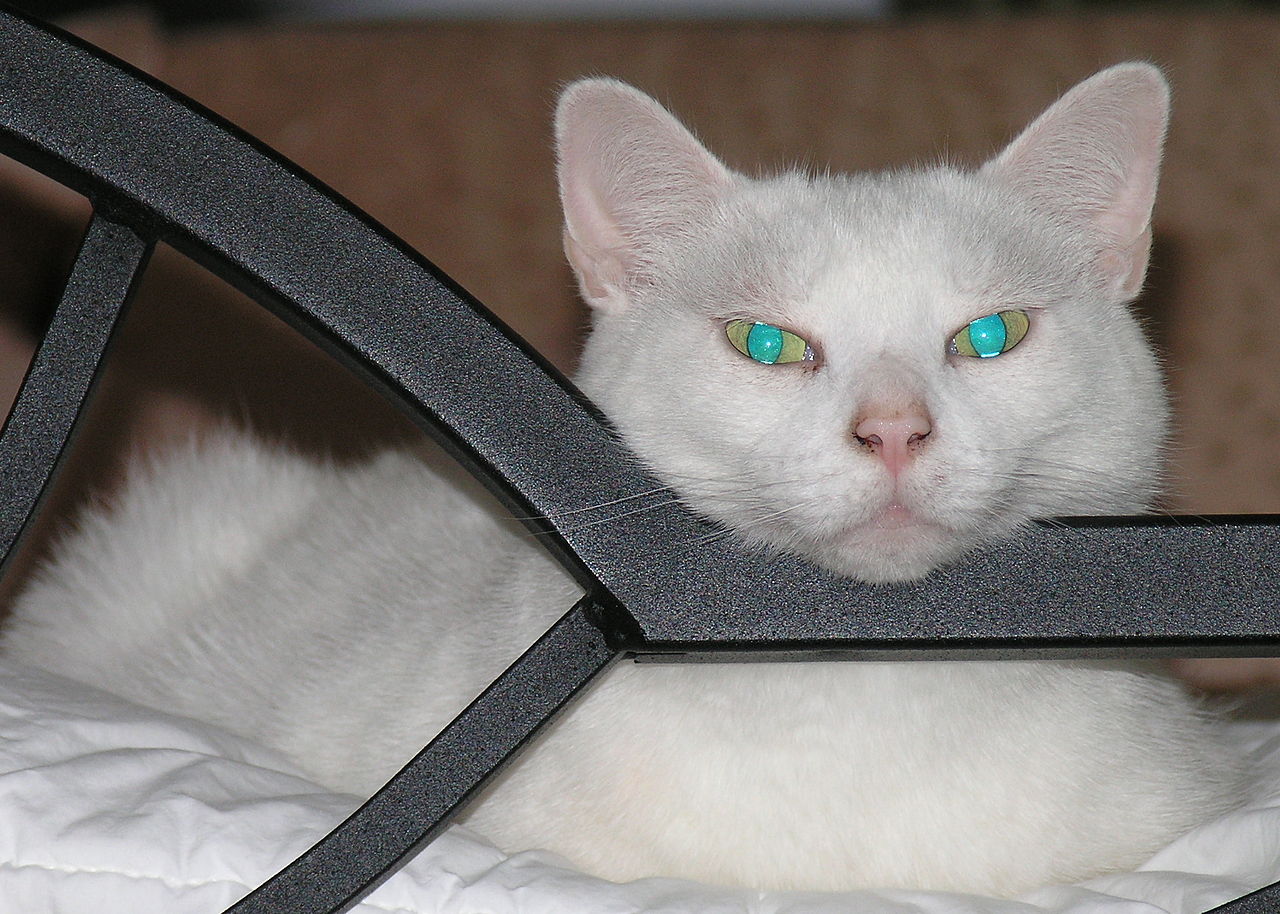
Photo: Greg Hume
Baby Water Dragon At Warriewood Wetlands
Photo: Joe Mills
Joe tells us 'I love this picture of the baby Australian Water Dragon peering over the edge of the wooden walk. He scrambled off the walk as I got close, but was also inquisitive, and just poked his head above the edge of the wooden walk barrier to keep his eye on me. He did not run away & was still there as I walked past.'
More in this Issue's Pictorial by Joe Mills - A Stroll Through Warriewood Wetlands
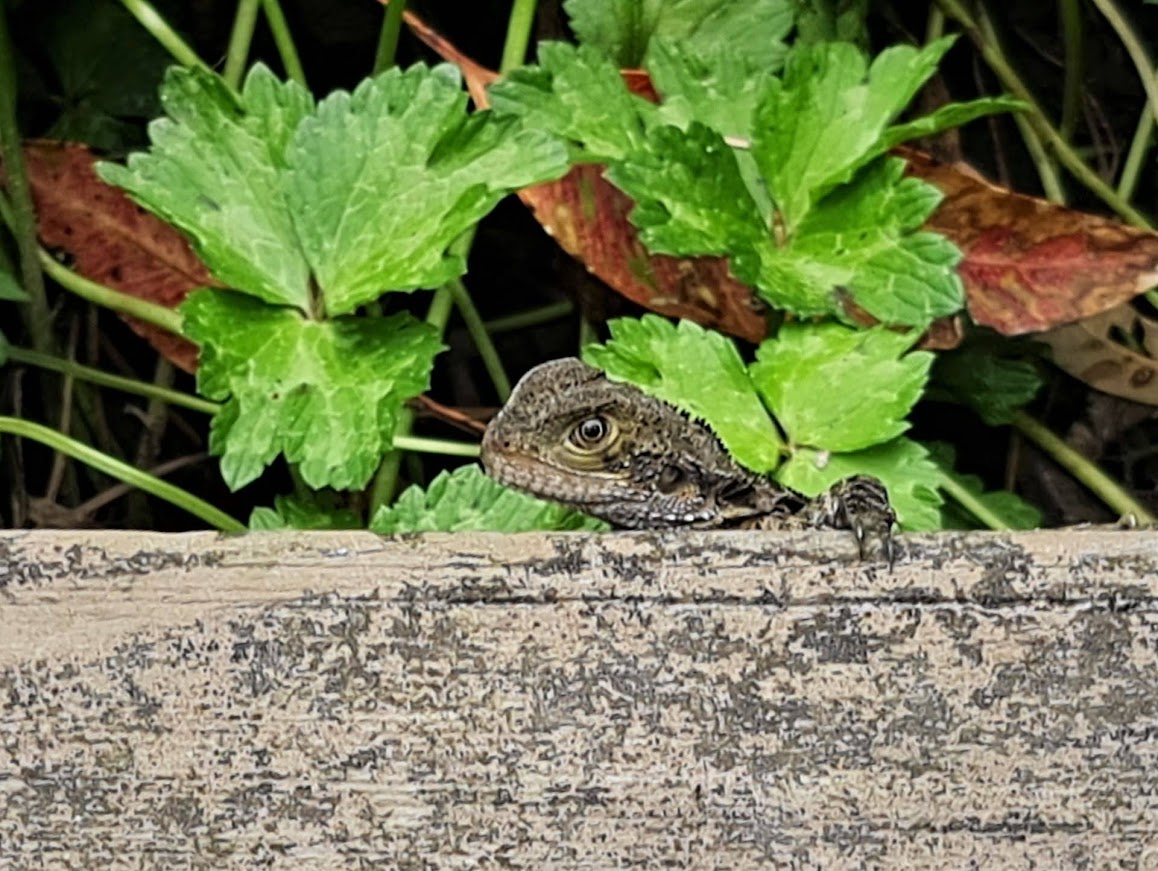
Council Set To Trial Soft Plastics Recycling Program
Wednesday, March 1st, 2023
Council will soon start a trial to make it easier for Northern Beaches residents to recycle plastic wrapping, bread bags and other soft plastics.
'Soft plastics' or 'scrunchable plastics' are commonly used in for consumer product packing. Since the suspension of the national REDcycle program that ran out of popular supermarkets, our residents have had nowhere to drop off these plastics for recycling.
At its meeting on February 28th, Council resolved to pursue a soft plastics collection and processing trial for the Northern Beaches at dropoff locations.
Council is currently negotiating with recycling suppliers and will release trial details shortly.
Council will also continue to monitor the market and look at opportunities for larger-scale collections and recycling, should funding and markets for recycled soft plastics be available.
Mayor Regan said that although soft plastics recycling is a national challenge that needs a whole of supply chain solution, we can act locally to help.
"The best thing anyone can do to help solve our soft plastics problem is to avoid them, but avoiding them altogether is almost impossible," he said.
'We have spent years investigating the collection and recycling of soft plastics and exploring possible options for schemes and programs that will help facilitate recycling within our community. There are real challenges facing soft plastics recycling, but we want to help find long-term solutions and alternatives.
"This trial is an excellent step in the right direction, and we're hoping it leads to keeping soft plastics out of landfill as much as possible".
Council will continue to work with the community to promote and educate residents around living sustainably, avoiding waste and recycling.
Leopold Slug
Following on from last week's Red Triangle Slug we've been keeping an eye on what's in the garden and this week want to tell you about this slug we found there. This is the largest of the introduced slugs found in Sydney. The word 'introduced' means someone brought it here as, unlike the Red Triangle Slug, it is not a native slug of Australia. Scientists tell us it was introduced during the 1800s.
.jpg?timestamp=1677867743918)
The name Leopard Slug is derived from the slug's dark spots on its light brown body and it's usually found in urban areas, and you will find it elsewhere in the south and east of Australia.
Its Scientific Name Limax maximus, literally means "biggest slug", and it is known by the common names great grey slug and leopard slug, is a species of slug in the family Limacidae, the keeled slugs. It is among the largest keeled slugs, Limax cinereoniger being the largest.
It can grow to up to 20 centimetres!
The Leopard Slug feeds on dead animal tissue, cat food and pet faeces.
Mating Leopard Slugs become entwined and lower themselves from their branch on a thread of mucus. Then they return to the branch via the mucous thread, eating it as they go. Like all slugs and snails, they are hermaphrodites – they have both male and female reproductive organs.
The eggs of this slug are deposited in a cluster, slightly attached to each other. Eggs are transparent, elastic and slightly yellowish in colour. The size of the egg is 6×4.5 mm, and like the Moth Eggs, so tiny you have to look closely to spot them. They hatch in about a month. The tiny slugs which emerge from the eggs need at least two years to reach maturity.
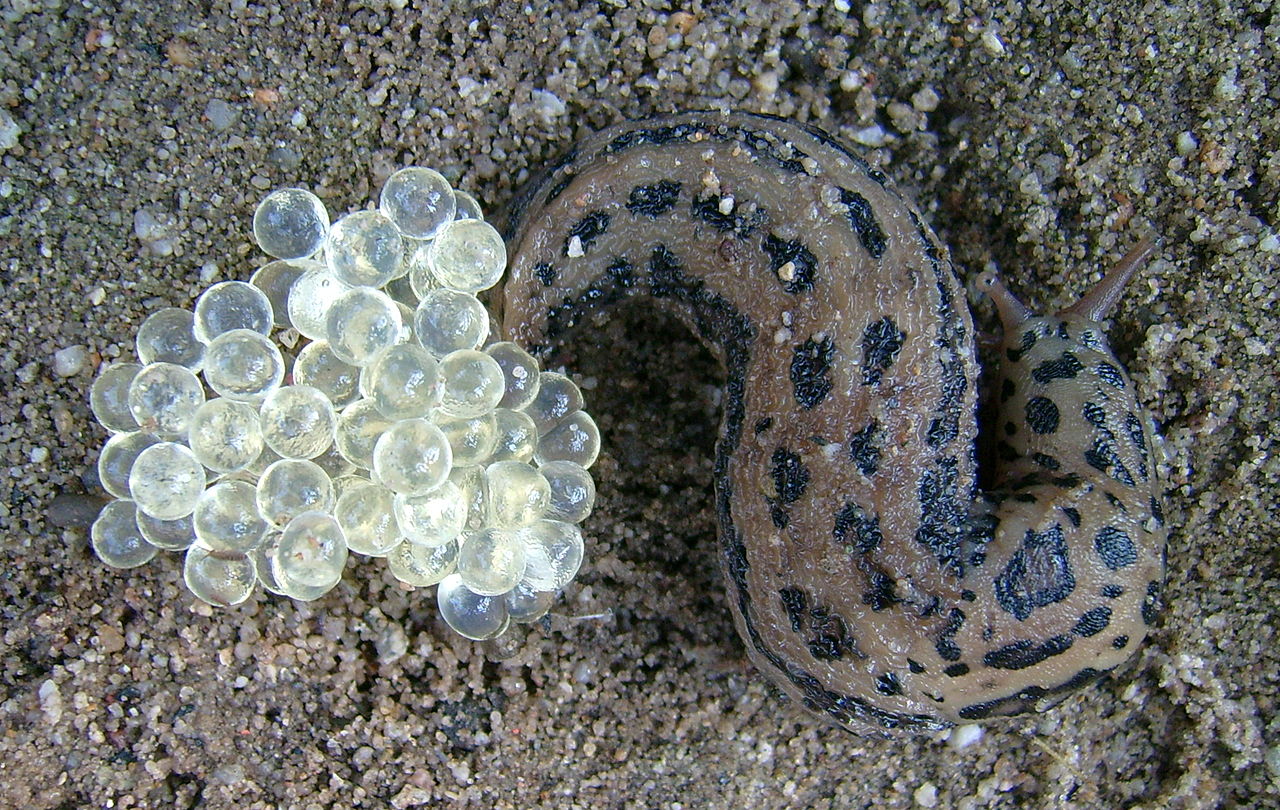
Leopold Slug with egg cluster. Photo: Lokilech
The greater part of the body is rounded, but there is a short keel on its tail, with about 48 longitudinal rows of elongate, detached tubercles. The shell of Limax maximus is reduced and internal, under the shield. The occurrence of this internal shell was known to Pliny the Elder as the shell was used by the ancient physicians for the sake of its carbonate of lime. The calcitic shell is situated beneath the hinder part of the shield, and is perceptible through the skin. The colour of the shell is whitish. The shape of the shell is oblong-oval and thin, slightly convex above, and correspondingly concave beneath, with a membranous margin.
Gaius Plinius Secundus (AD 23/24 – 79), called Pliny the Elder, was a Roman author, naturalist and natural philosopher, and naval and army commander of the early Roman Empire, and a friend of the emperor Vespasian. He wrote the encyclopaedic Naturalis Historia (Natural History), which became a model for all encyclopaedias.
He spent most of his spare time studying, writing, and investigating natural and geographic phenomena in the field - a bit like all of us when we get outdoors and look around; what's at our feet, what's up in that tree, what's slithering up the glass door over there?
Leopard Slugs dry out in the heat so are only active in damp weather, when you may suddenly find hordes of them all over your backyard and even in your house. It's a Leopold Slug party - hide the cat food!
Limax maximus is nocturnal, feeding at night - which is how we got this week's photo for you. It is not very active or prolific, and like a snail, when alarmed, or at rest, this slug merely draws its head within the shield, but does not otherwise contract its body. When irritated, it is said to expand its shield.
Here's last week's picture so you can compare the two:
.jpg?timestamp=1677299455686)
The Red Triangle Slug (Triboniophorus graeffei) feeds on microscopic algae on smooth bark eucalypts, and algae on other smooth surfaces, leaving a narrow wiggly track.
The Red Triangle Slug is Australia's largest native land slug and can grow to be up to 15 centimetres. The distinctive red triangle on its back contains the breathing pore. This one was photographed in the Pittwater Online backyard last week after the downpours we had. They are found on Eastern Australia.
Australia’s Hotly Contested Eucalypt Of The Year Voting Now Open
Australia’s much loved - and hotly contested - Eucalypt of the Year voting is now open. Passionate gumtree lovers across the country are invited to vote for their favourite gum, now in its sixth consecutive year. There are ~850 species of eucalypt across the continent and they are an unmistakable feature of living where we do.
“After running for five years, there are still hundreds of eucalypts that haven’t had their time in the sun as Eucalypt of the Year. We’ve whittled down the species to a shortlist of 25 that represent a diverse range of ecological features and geographical spread to make it easier for you to vote. Last year’s winner - the mighty Mountain Ash (Eucalyptus regnans) is not eligible. Now is the time to cast your vote for your personal favourite,” says Linda Baird, CEO of Eucalypt Australia.
People can vote for their favourite eucalypt until 19th March at www.eucalyptaustralia.org.au
The winning eucalypt will be announced on National Eucalypt Day, Thursday March 23. National Eucalypt Day is Australia’s biggest annual celebration of eucalypts held every year to celebrate and promote Australia’s eucalypts and what they mean to our lives and hearts.
Tell the organisers how you voted on social media by tagging @EucalyptAus using the hashtag #EucalyptoftheYear. The 25 shortlisted species are:
- Angophora costata (Sydney Red Gum)
- Angophora hispida (Dwarf Apple)
- Corymbia aparrerinja (Ghost Gum)
- Corymbia citriodora (Lemon-scented Gum)
- Corymbia ficifolia (Red-flowering Gum)
- Corymbia opaca (Desert Bloodwood)
- Corymbia ptychocarpa (Swamp Bloodwood)
- Eucalyptus caesia (Silver Princess)
- Eucalyptus cinerea (Argyle Apple)
- Eucalyptus cneorifolia (Kangaroo Island Narrow-leaved Mallee)
- Eucalyptus lansdowneana (Crimson mallee)
- Eucalyptus platyphylla - (Poplar Gum)
- Eucalyptus leucoxylon - (Yellow Gum or South Australian Blue Gum)
- Eucalyptus macrandra (River Yate)
- Eucalyptus marginata (Jarrah)
- Eucalyptus miniata (Darwin Woollybutt)
- Eucalyptus perriniana (Tasmanian Spinning Gum)
- Eucalyptus radiata (Narrow-leaved Peppermint)
- Eucalyptus rhodantha (Rose Mallee)
- Eucalyptus rubida (Candlebark)
- Eucalyptus salmonophloia (Salmon Gum)
- Eucalyptus oleosa (Giant Mallee)
- Eucalyptus synandra (Jingymia Mallee)
- Eucalyptus tetraptera (Square-fruited Mallee or Four-winged Mallee)
- Eucalyptus vernicosa (Varnished Gum)
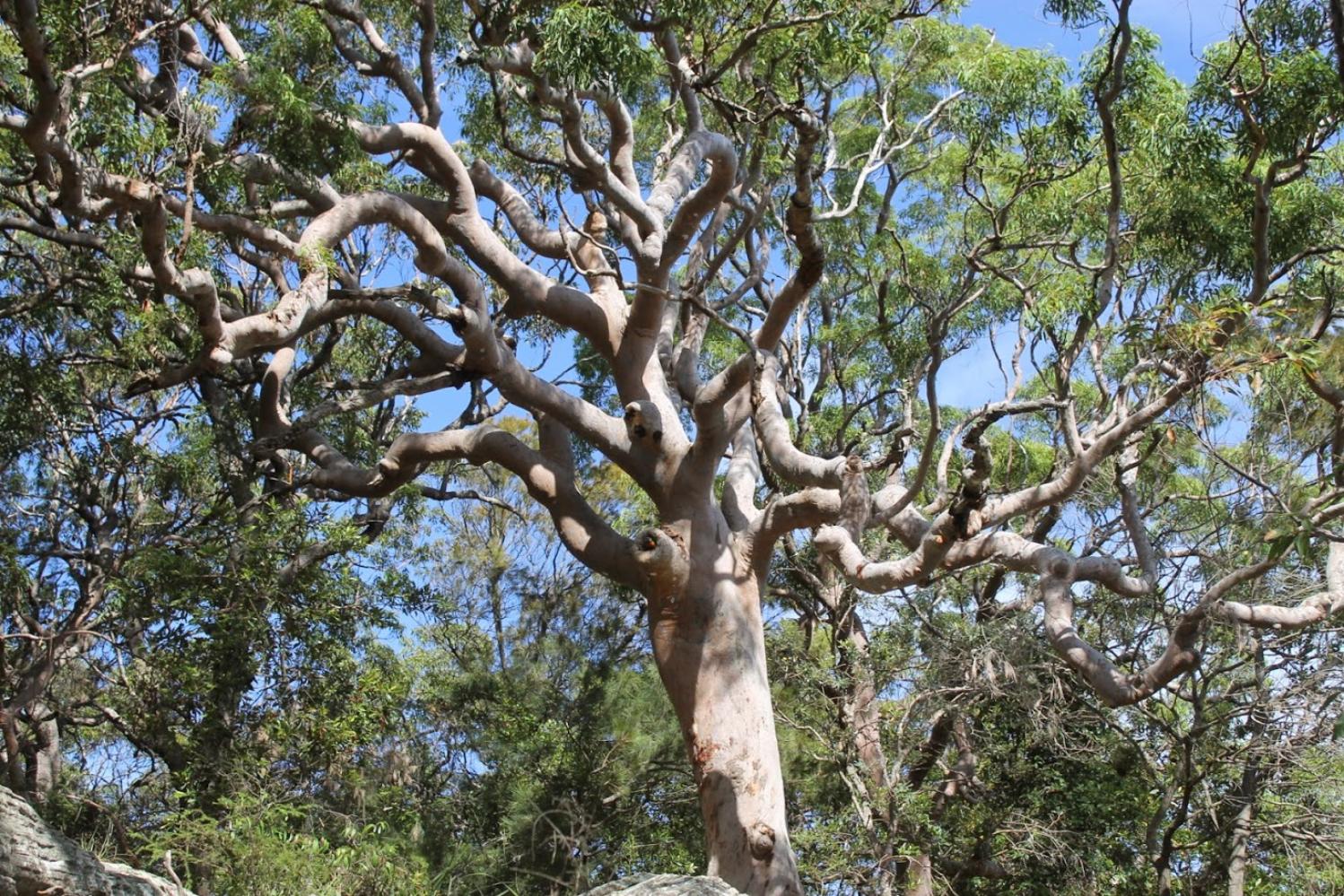
Angophora costata (Sydney Red Gum), McKay Reserve Palm Beach. Photo: A J Guesdon
Tasmanian Spinning Gum Eucalyptus perriniana. Photo: Remember The Wild, Catherine Cavallo, Instagram handle rememberthewild
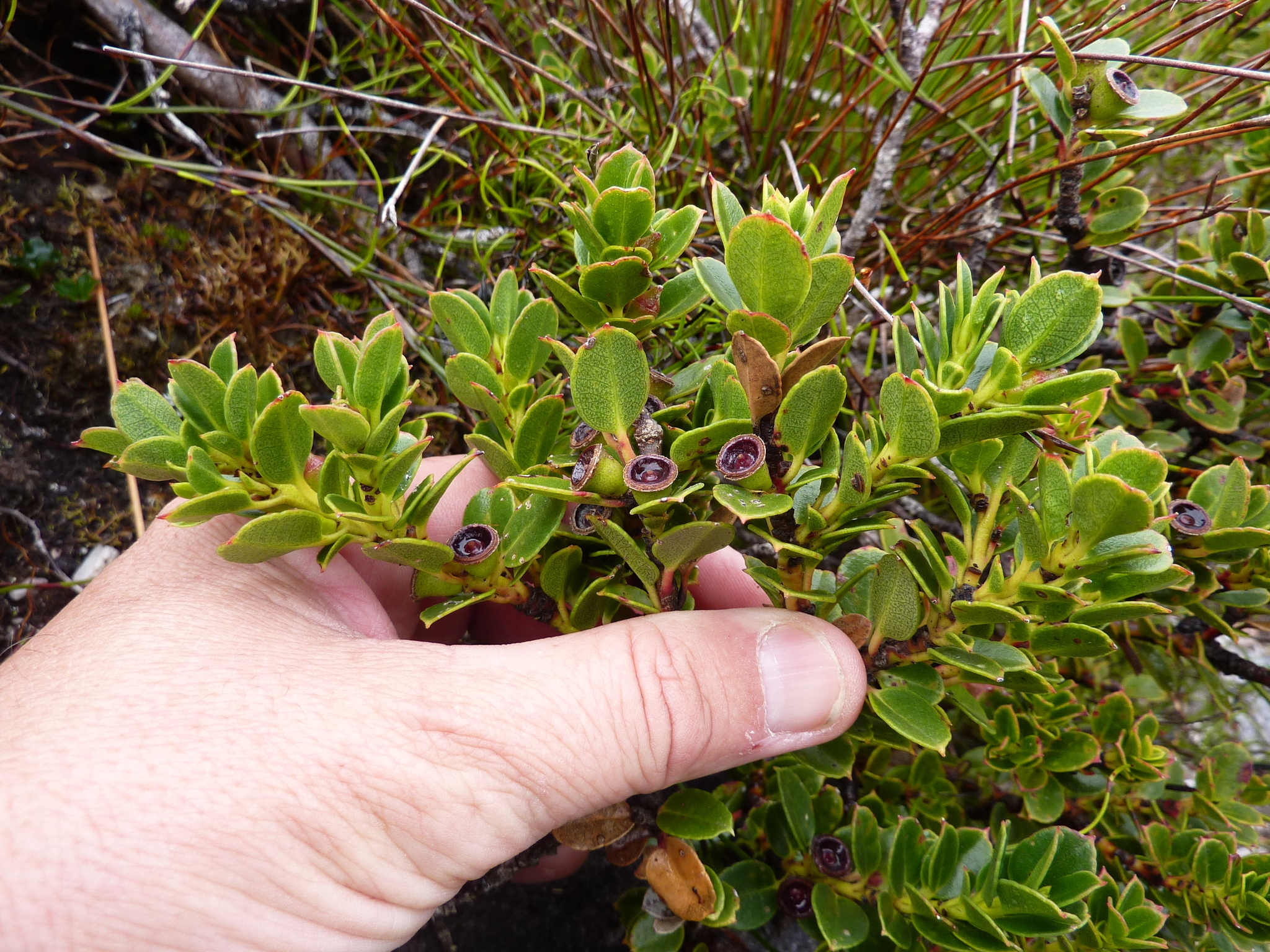
Varnished Mallee Eucalyptus vernicosa. Photo: Dean Nicolle
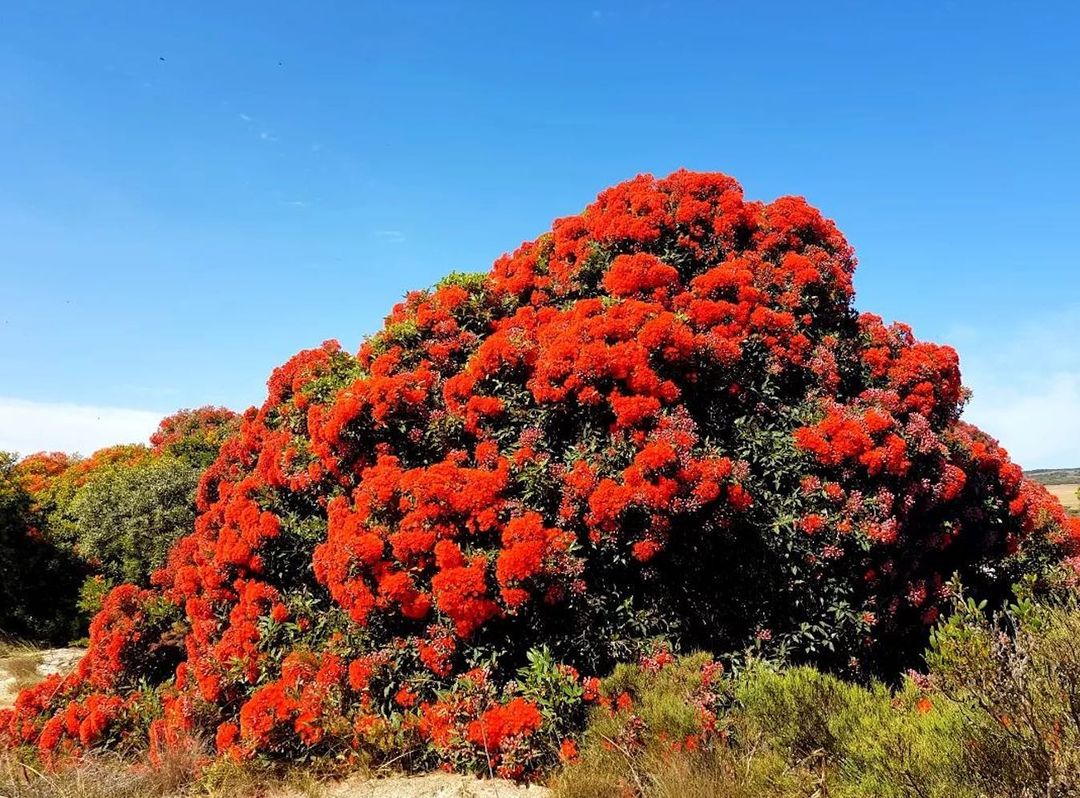
Red Flowering Gum Corymbia ficifolia. Photo: Melanie Cooper, Instagram handle maxxle5
Report Fox Sightings
%20(1).jpg?timestamp=1675893929686)
Protest For Koalas: Manly - Sunday March 12
We are taking a stand for koalas in NSW Environment Minister James Griffin’s Manly Electorate.
Koalas need forests.
The continual loss of habitat is contributing to the decline of koalas — and if we don’t end native forest logging they are on track to becoming extinct by 2050.
Join in showing your support in Manly to stand against the senseless devastation of koala habitat in NSW forests.
Environment Minister James Griffin is sitting on his hands on koalas.
It’s time we protect koalas by saving their habitat.
Speakers to be announced.
Event by Bob Brown Foundation
Manly Beach Promenade at the Corso: Sunday 12 March at 10am
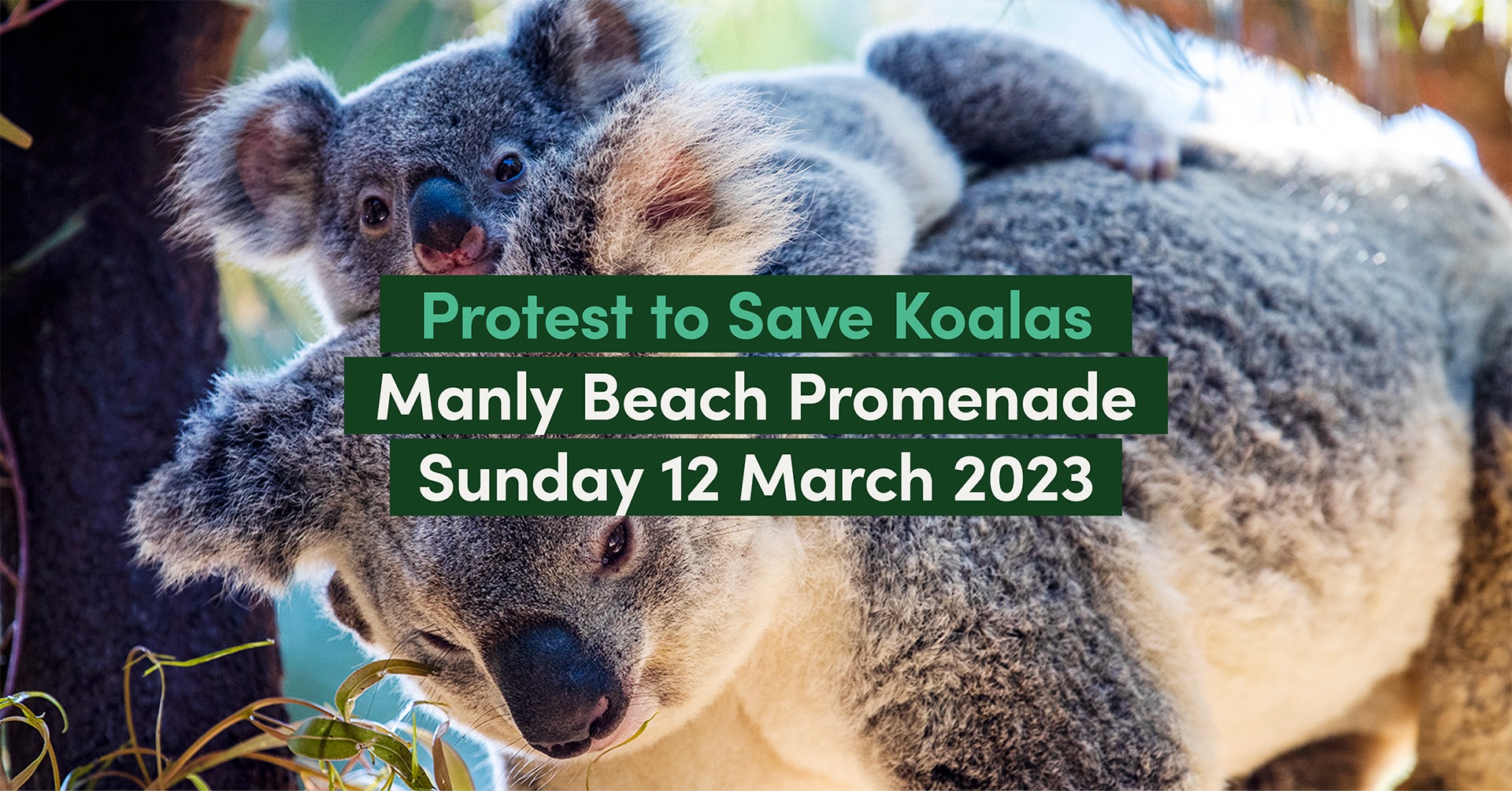
NSW National Park Additions Welcome – But Where Are The Koalas Meant To Live? Just 3.1% Of Land Pledged By Coalition Government Is Significant Koala Habitat
February 28, 2023
New South Wales still has a long way to go when it comes to preserving critical koala habitat, despite the announcement of new national parks in the east and west of the state.
While the acquisitions will be a great step toward Australia's commitment to protect 30% of NSW land by 2030, the Perrottet Government is still selling endangered species short.
Analysis by Nature Conservation Council NSW has found that of the lands added to the national parks estate by the Coalition over the past 11 years, only 3.1% are in areas of significant koala habitat.
That includes the 3,157 hectares announced on Sunday.
NCC chief executive Jacqui Mumford says nowhere near enough is being done to create the comprehensive and representative reserve system that is needed to safeguard biodiversity.
"Of more than 458 000 hectares of Areas of Regional Koala Significance (ARKS) mapped in NSW, only 21% are inside a National Park.
"One of our most iconic species is being subjected to native forest logging and out of control land clearing, and the National Parks estate can't save it unless something big changes.
"Koalas now face extinction in our lifetimes without urgent action. Yet their habitat has virtually no protection from the logging and clearing that is driving this decline.
"We need a new deal for nature, a new deal for koalas in NSW. The Government can’t keep logging and clearing the vast majority of the best koala habitat and expect to double the number of koalas.” said Ms Mumford.
This NSW election, the Nature Conservation Council of NSW is calling on candidates to:
- Stop logging public native forests and shift to plantations.
- Convert state forests to reserves by 2024 and conserve all core koala habitat on publicly owned land, including the creation of the Great Koala National Park
- Ban the clearing of koala habitat, and overhaul land clearing laws and the biodiversity offset scheme.
Concert: Rock For Lizard Rock
FREE. Register at: https://www.eventbrite.com/e/rock-for-lizard-rock-tickets-554768135427

Create A Spit To Seaforth Oval Walk: The Missing Link - Petition
There is approx. 20,000 square metres of land situated between Rignold Street and Castle Circuit, Seaforth. The largest block is now FOR SALE. There is currently contracts out to overseas investors and developers.
The land is separated by conservation land that joins Garigal National Park. This land should be purchased and returned to the community for all to enjoy and wildlife to be given a fighting chance at survival.
This is a thriving riparian zone that should be made a wildlife corridor. It is currently the wildlife corridor that connects existing corridors to Garigal National Park .Running through the middle of the land is a permanent water source that attracts and aids the survival of many animals. Currently there are wallabies, echidnas, powerful owls, lyrebirds, monitor lizards, water dragons, numerous species of small birds and insects such as a large variety of dragonflies.
The Powerful Owl is listed as vulnerable in NSW and there is talk of changing the lyrebird's status to threatened in light of the recent loss of habitats due the devastating fire season of last summer. The Seaforth Mint Bush is listed as critically endangered. The Angophora's are a protected species.
The loss of hollow bearing trees is a key threatening process in determining whether or not these vulnerable and threatened species will survive.
Given the conservation status of this flora and fauna I am asking for this land be bought back to create a wildlife corridor to join the land that was saved behind Dalwood homes. At present the land is made up of two privately owned properties, one is owned by a Chinese consortium and the other is owned by an American family. Both parcels have derelict houses that are falling down, leaving shattered glass, asbestos and building rubble spread through the bush. One property has no street access and is only accessible by water.
Thank you to all who have read this far and thank you in anticipation of your signatures helping to protect this very unique area.
Petition at: https://www.change.org/p/create-a-spit-to-seaforth-oval-walk
THIS IS THE MISSING LINK TO CREATING A FORESHORE WALK THROUGH SEAFORTH.
Prune Viburnum Hedge Agapanthus Flowers To Prevent Spread Into Bush Reserves
PNHA: January 11, 2023
Now is the time to prune the berries off the Viburnum hedge and dehead those old Agapanthus flowers. Put these prunings into your green waste bin. Both are now weeds of bushland as their seeds travel.
Photos: Pittwater Natural Heritage Association (PNHA)
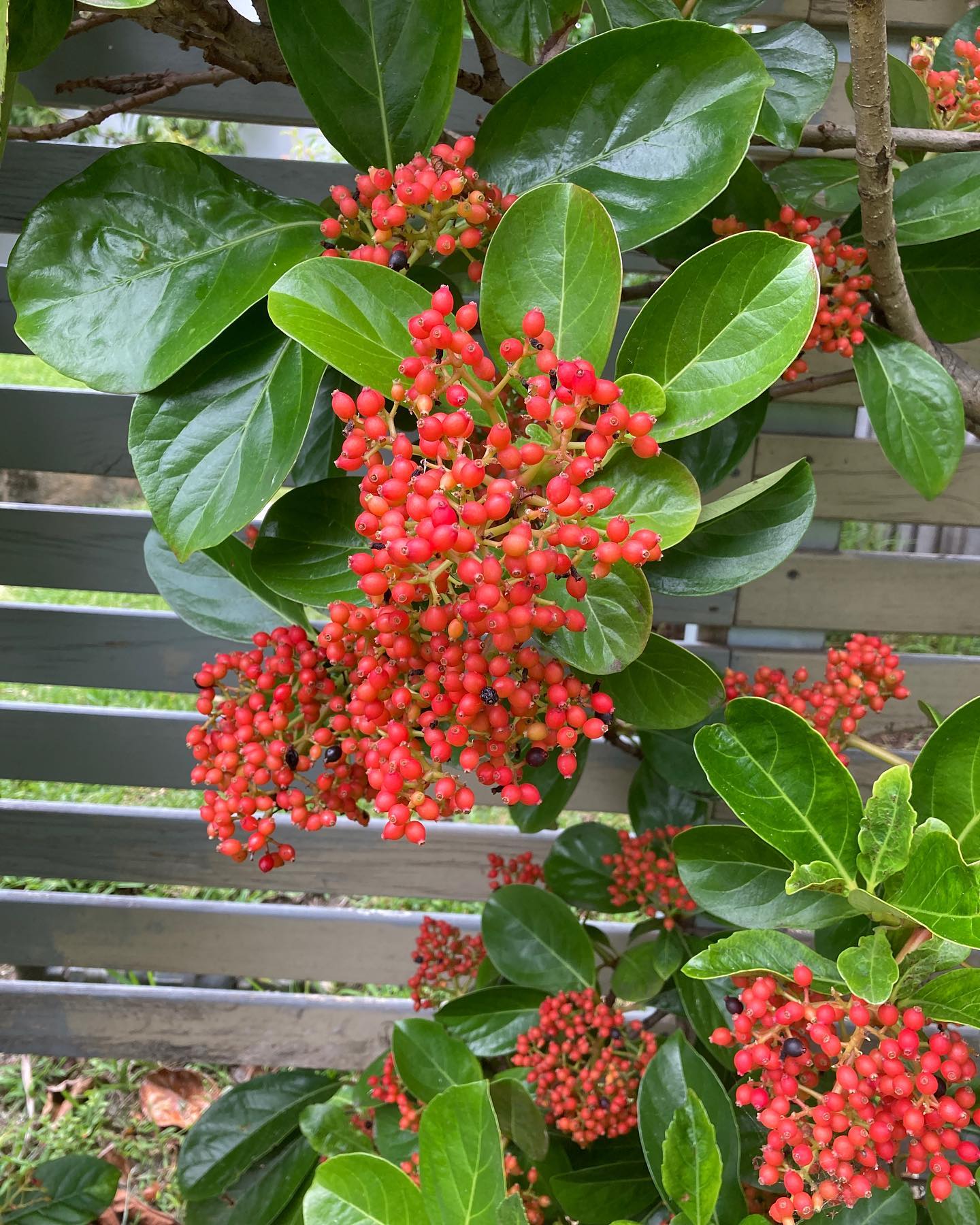
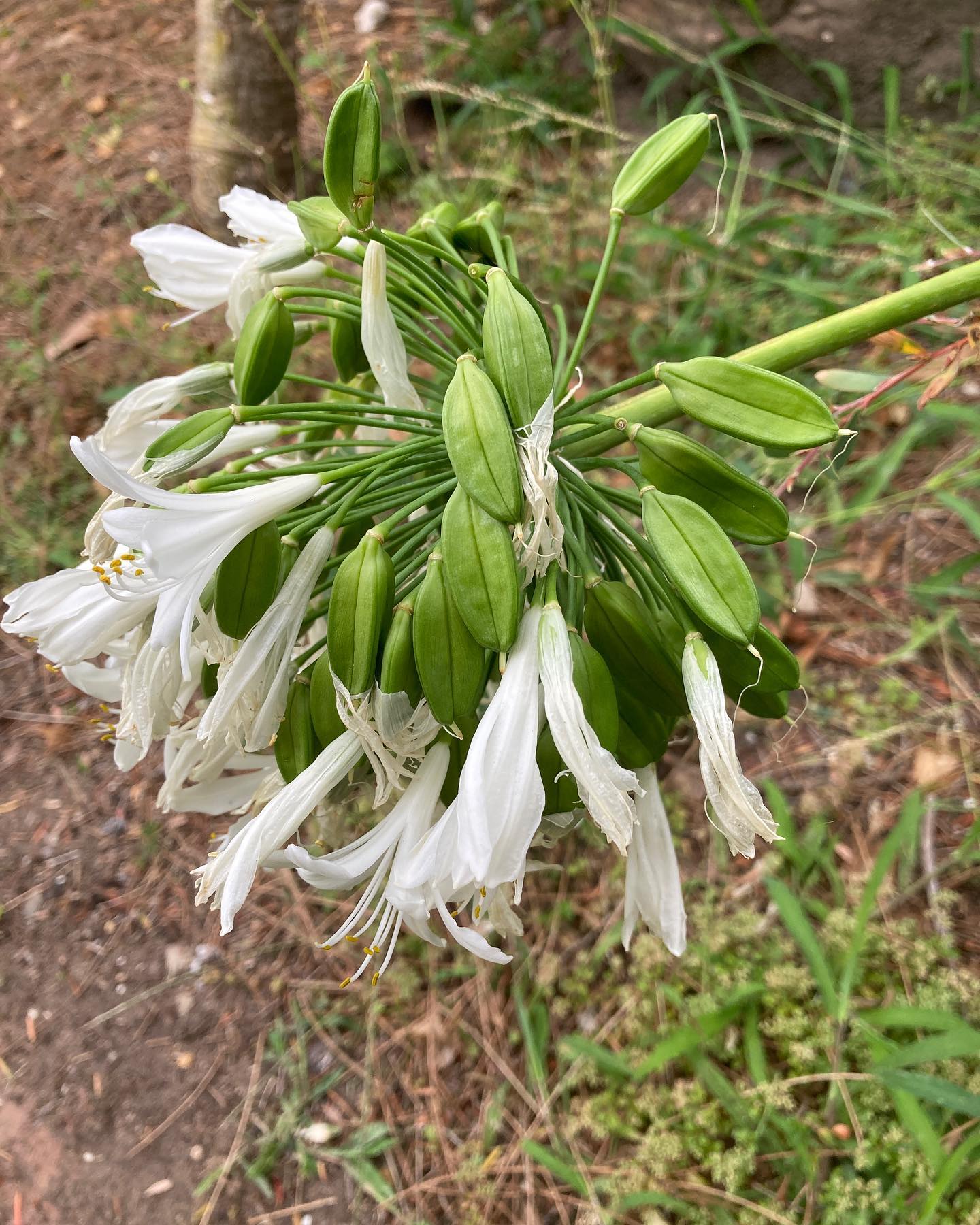
New Marine Wildlife Rescue Group On The Central Coast
A new wildlife group was launched on the Central Coast on Saturday, December 10.
Marine Wildlife Rescue Central Coast (MWRCC) had its official launch at The Entrance Boat Shed at 10am.
The group comprises current and former members of ASTR, ORRCA, Sea Shepherd, Greenpeace, WIRES and Wildlife ARC, as well as vets, academics, and people from all walks of life.
Well known marine wildlife advocate and activist Cathy Gilmore is spearheading the organisation.
“We believe that it is time the Central Coast looked after its own marine wildlife, and not be under the control or directed by groups that aren’t based locally,” Gilmore said.
“We have the local knowledge and are set up to respond and help injured animals more quickly.
“This also means that donations and money fundraised will go directly into helping our local marine creatures, and not get tied up elsewhere in the state.”
The organisation plans to have rehabilitation facilities and rescue kits placed in strategic locations around the region.
MWRCC will also be in touch with Indigenous groups to learn the traditional importance of the local marine environment and its inhabitants.
“We want to work with these groups and share knowledge between us,” Gilmore said.
“This is an opportunity to help save and protect our local marine wildlife, so if you have passion and commitment, then you are more than welcome to join us.”
Marine Wildlife Rescue Central Coast has a Facebook page where you may contact members. Visit: https://www.facebook.com/profile.php?id=100076317431064
- Ph: 0478 439 965
- Email: marinewildlifecc@gmail.com
- Instagram: marinewildliferescuecc

Watch Out - Shorebirds About
.JPG.opt1460x973o0,0s1460x973.jpg?timestamp=1663629195339)
Possums In Your Roof?: Do The Right Thing

Aviaries + Possum Release Sites Needed

Bushcare In Pittwater
Where we work Which day What time
Avalon
Angophora Reserve 3rd Sunday 8:30 - 11:30am
Avalon Dunes 1st Sunday 8:30 - 11:30am
Avalon Golf Course 2nd Wednesday 3 - 5:30pm
Careel Creek 4th Saturday 8:30 - 11:30am
Toongari Reserve 3rd Saturday 9 - 12noon (8 - 11am in summer)
Bangalley Headland 2nd Sunday 9 to 12noon
Bayview
Winnererremy Bay 4th Sunday 9 to 12noon
Bilgola
North Bilgola Beach 3rd Monday 9 - 12noon
Algona Reserve 1st Saturday 9 - 12noon
Plateau Park 1st Friday 8:30 - 11:30am
Church Point
Browns Bay Reserve 1st Tuesday 9 - 12noon
McCarrs Creek Reserve Contact Bushcare Officer To be confirmed
Clareville
Old Wharf Reserve 3rd Saturday 8 - 11am
Elanora
Kundibah Reserve 4th Sunday 8:30 - 11:30am
Mona Vale
Mona Vale Beach Basin 1st Saturday 8 - 11am
Mona Vale Dunes 2nd Saturday +3rd Thursday 8:30 - 11:30am
Newport
Bungan Beach 4th Sunday 9 - 12noon
Crescent Reserve 3rd Sunday 9 - 12noon
North Newport Beach 4th Saturday 8:30 - 11:30am
Porter Reserve 2nd Saturday 8 - 11am
North Narrabeen
Irrawong Reserve 2nd Saturday 2 - 5pm
Palm Beach
North Palm Beach Dunes 3rd Saturday 9 - 12noon
Scotland Island
Catherine Park 2nd Sunday 10 - 12:30pm
Elizabeth Park 1st Saturday 9 - 12noon
Pathilda Reserve 3rd Saturday 9 - 12noon
Warriewood
Warriewood Wetlands 1st Sunday 8:30 - 11:30am
Whale Beach
Norma Park 1st Friday 9 - 12noon
Western Foreshores
Coopers Point, Elvina Bay 2nd Sunday 10 - 1pm
Rocky Point, Elvina Bay 1st Monday 9 - 12noon
Friends Of Narrabeen Lagoon Catchment Activities

Gardens And Environment Groups And Organisations In Pittwater
State Government Caught Out In More Secret Deals
Statement On The Department's Rezoning Pathways Program
Date: 24.02.2023 Type: Departmental Media Release Author: NSW Department of Planning and Environment
As part of the selection process to determine which proposals will be considered by the State under the Rezoning Pathways program, the department is inviting subject matter experts at councils to provide early technical information on eligible projects.
As a probity measure, given the sensitive, commercial and confidential nature of some of the information, and because these are only preliminary nominations rather than formal planning proposals, these experts will need to sign conflict of interest and confidentiality deeds, should they wish to view any project information and provide input.
If selected, any resulting planning proposals will still be subject to the same strict assessment requirements as usual, which includes consultation with councils and community.
This early engagement is not mandatory, and councils will be able to provide input as part of the usual planning proposal process.
The industry nomination pilot process has been designed in lockstep with independent probity advisors, is being conducted in accordance with strict probity provisions, and is consistent with legal advice.
The department proactively sought advice from the NSW Independent Commission Against Corruption to ensure the process safeguards against corruption risks.
The department’s Secretary will determine which proposals will be state assessed, based on recommendations from an assessment panel of department staff, an independent panel member and a probity advisor.
2023: The Year The NSW Government Will Consider The Largest Coal Expansion Since Paris Agreement
February 28, 2023
The largest coal mine expansion in NSW since the Paris Agreement looks set to be considered this year, with eight new projects on the government's books.
A Lock the Gate analysis shows that if all these projects are built, they will collectively be responsible for more than 1.5 billion tonnes of greenhouse gas emissions after the coal from the mines is burnt - more than 10 times NSW’s emissions total in 2019.
The largest is Glencore and Yancoal’s Hunter Valley Operations project, which alone would be responsible for a whopping 1.2 billion tonnes of CO2-e. Public submissions concerning the project closed Monday February 27.
The total emissions figure from all the projects is also likely to be much higher, with some coal companies yet to submit their GHG estimates, and serious questions around the accuracy of how fugitive emissions are measured in Australia.
Lock the Gate Alliance NSW Coordinator Nic Clyde said the NSW Perrottet Government’s policy of letting the coal mining sector charge full steam ahead without constraint fatally undermined its stated climate goals.
“Dangerous climate change caused by the burning of fossil fuels like coal has led to devastating extreme weather events all over NSW,” he said.
“Anthony Roberts should have amended planning laws to put a safe climate before coal and gas mining, but he has failed to do so.
“Due to his failure to act, NSW is now staring down the barrel of the biggest climate bomb from coal mine expansions since the Paris Agreement - putting our future at risk.
“When every other sector in the NSW economy is doing their bit to start reducing emissions to address climate change, the coal and gas sector is running in the opposite direction.
“The Hunter Valley Operations coal expansion being assessed by the NSW Government right now is actually proposing to double its direct greenhouse emissions.
“As climate heats up as an election issue, the failure of the NSW Government to act on this most crucial element of reining in coal and gas for a safe future is on stark display.”
Since the Paris Agreement entered into force in November 2016, the NSW Government has approved 26 new coal and gas projects (see table here), responsible for a combined greenhouse gas emissions total of about 4.4 billion tonnes of CO2e.
Background:
Lock the Gate Alliance has analysed the scale of new coal capacity approved in NSW each year since the Paris Agreement. The results are presented in the graph below and are derived from publicly available government and company documents (further details available on request).
Figure 1: New coal production approved in NSW since the Paris Agreement entered into force in November 2016 (blue) vs new coal capacity under assessment (red).
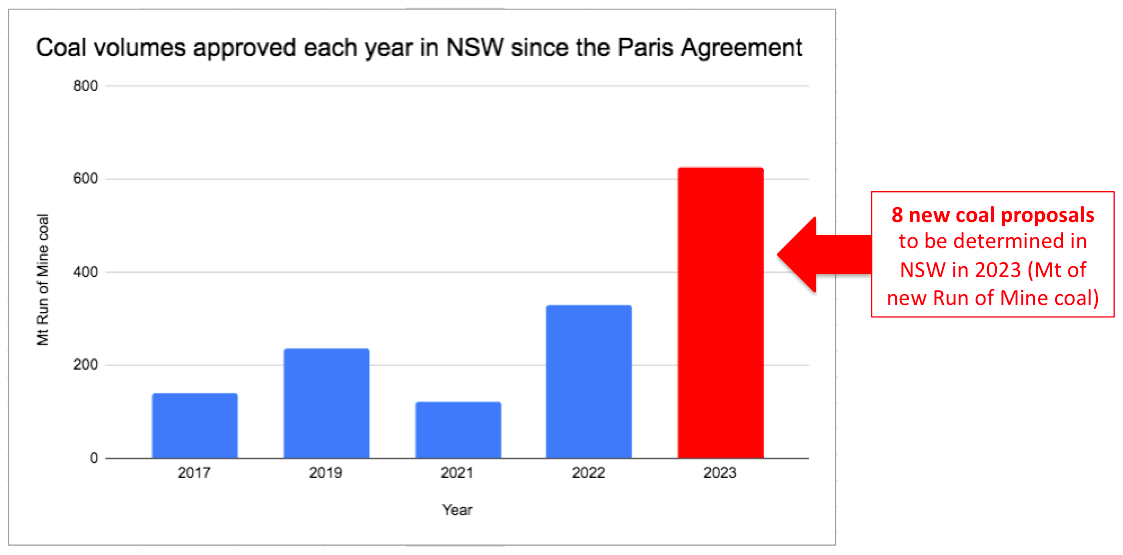
Leave It In The Ground: Liverpool Plains Community Unites Against Santos - Mackellar MP Visits
February 23, 2023
The Liverpool Plains community will unite this weekend to demand Santos abandon its plans for coal seam gas drilling and a high pressure gas pipeline in the world renowned food and fibre growing region.
Coal seam gas opponents and community members are expected to flock to the Spring Ridge Country Club for the "Save the Plains; Leave It in The Ground" festival, with Golden Guitar winners Luke O’Shea and Allan Caswell headlining the event, supported by Luke Vassella.
While forcing Santos off the Liverpool Plains is the festival’s primary focus, event organiser and Liverpool Plains farmer Nicky Chirlian said there was a larger goal.
“If we stop Santos building new gasfields on the Liverpool Plains, and we stop Santos building its Hunter Gas Pipeline, then the business case for the company’s Narrabri Gas Project in the Pilliga Forest becomes much harder for it to justify to its investors,” she said.
“Despite originally denying it, Santos’ intention has always been to build gasfields in the Liverpool Plains to increase the viability of its gasfield in the Pilliga, and the Berijiklian-Perrottet Governments knew it*. But communities won’t let Santos drill this region’s rich black soils.
“The sustainable, ongoing production of food and fibre on the Liverpool Plains is worth so much more than Santos’ temporary, polluting gas projects. The Perrottet Government made a grave error in allowing Santos to explore for gas here, and farmers won’t forget it.”
Walhallow Land Council Chief Executive Officer Jason Allan said Santos’ gasfield plans threatened peoples’ way of life on the Liverpool Plains.
“It’s important that we maintain the farming land on the Liverpool Plains for future generations. It’s our main source of employment and wealth, and we don’t want it destroyed for something that offers us no value at all,” he said.
“Santos is offering nothing for our community. There will be no financial benefit if Santos is allowed to build its gasfields.”
Assistant Secretary of Unions NSW Vanessa Seagrove spoke at the event.
“The NSW union movement stands in support of the Gomeroi and Gamilaraay First Nations people in their self-determination over their lands in the Pilliga. We are campaigning with all local communities to stop Santos from destroying the Pilliga. We are ready to support communities in the Liverpool Plains to stop Santos,” she said.
“Union members from across our state are joining our campaign with the Gomeroi and Gamilaraay people to stop any attempt by Santos to go ahead with this reckless destruction.
“There are huge volumes of Australian gas exported overseas, with the balance being sold to us at inflated prices. This is a policy crisis.
“We call on all levels of government to take whatever action necessary to honour the wishes of First Nations people and local communities to stop Santos destroying this land and threatening the water in the great artesian basin that sits below it.”
*Background: In a letter to a Liverpool Plains farmer concerned about the expansion of coal seam gas fields in the region, Parliamentary Secretary to the Deputy Premier Gurmesh Singh MP writes, “The remaining PELS (petroleum exploration licences) in NSW have been retained to support the long-term future of the Narrabri Gas Project”.
On February 22nd 2023: Dr. Sophie Scamps, MP for Mackellar, visited the Piliga and the Liverpool Plains with Kylea Tink, MP for North Sydney to hear directly from farmers and those impacted by Santos’s push to drill for more and more gas.
Our Mackellar MP stated;
We heard from experts and locals about how the drilling could destroy one of the most precious food bowls in our country…
Subsidence of farm land as underground aquifers are drained, water insecurity, toxic by-products, venting and flaring of methane - a greenhouse gas 30 times more potent than CO2.
It’s short term thinking at its worst.
We also learnt of the halving of the share price of Santos over the last decade, the projected decline in OS gas markets, and the 40% decline in gas being used here for power generation in recent years.
''This plan of Santos to drill the incredibly fertile Liverpool plains - otherwise know as God’s gift to Australia - is short term insanity
- - food insecurity
- -water insecurity
- - methane induced climate change
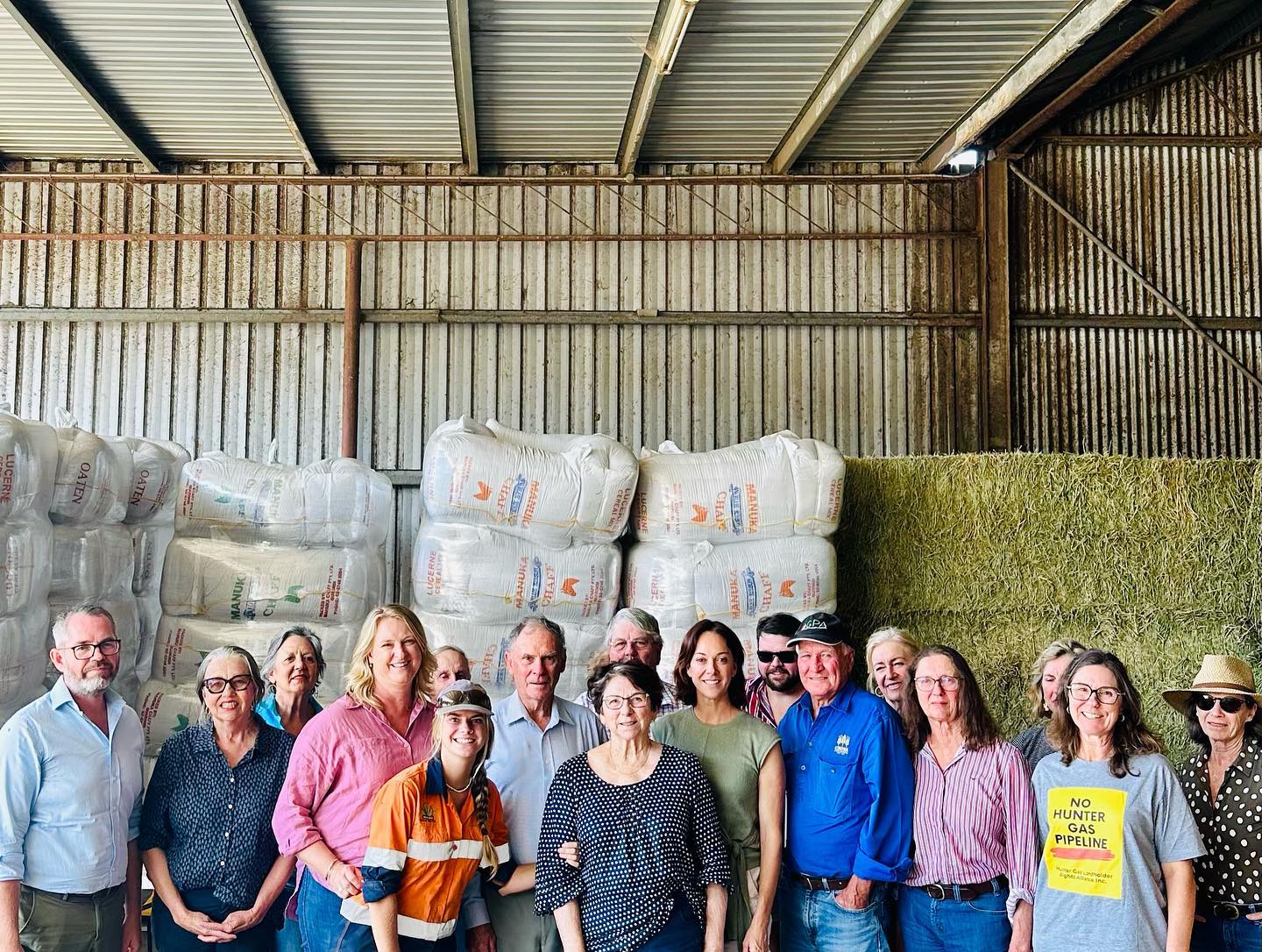
Dr ScampsMP for Mackellar and Kylea Tink, MP for North Sydney, speaking with residents of the Liverpool Plains
Plibersek’s Approval Of Santos’ Arcadia Valley Gasfield Doesn’t Pass The Climate Sniff Test
February 23, 2023
Lock the Gate Alliance has accused Federal Environment Minister Tanya Plibersek of failing to walk the talk on climate action after her department approved a Santos-owned project that will lead to the drilling of 116 gaswells in the beautiful Arcadia Valley in Central QLD late last week.
Lock the Gate Alliance National Coordinator Ellen Roberts said,
"The Arcadia Valley is a truly beautiful agricultural district, which attracts thousands of tourists each year as they make their way to nearby national parks. But Santos' gas project will industrialise this valley, and drain the water that sustains farms throughout the district.
"This is the reality of coal seam gas expansion - once beautiful farming districts are irreparably degraded and industrialised due to the drilling of many hundreds of gas wells, access roads, and wastewater treatment plants. Groundwater beneath the land is drained and placed at risk of contamination.
"These should have been reason enough for Tanya Plibersek to reject this project. But gas is also a fossil fuel that is driving the climate crisis. To think the world will still be burning fossil gas by 2077 - the approval end date for this project - is totally inconsistent with the International Energy Agency's 2021 recommendation that there must be no new fossil fuel projects if the world is to keep global warming to as far below two degrees as possible.
"It’s also particularly galling that Minister Plibersek’s department appears to have made this approval late on a Friday afternoon, and suggests the government was attempting to avoid public scrutiny over a very poor decision.”
Report: Santos’ wins fracking approval for Towrie gas development from Environment Minister Tanya Plibersek by Callum Foote | Feb 21, 2023 at:
https://michaelwest.com.au/santos-wins-fracking-approval-for-towrie-gas-development-from-environment-minister-tanya-plibersek/; ''At 4:55 pm yesterday afternoon, Tanya Plibersek approved another Santos fracking project to go ahead in Queensland’s Surat Basin. No announcement or fanfare, and only a single researcher keeping a close eye picked it up, reports Callum Foote.''
Buru’s Bulldozers Let Loose On Kimberley Savanna - Again
March 1, 2023
Western Australia’s environmental watchdog has refused to assess a proposal by Buru Energy to bulldoze more than 1000kms of savanna woodland in the Kimberley so the company can conduct more geological surveys for gas.
The Environmental Protection Authority announced this week that Buru’s “Rafael” land clearing proposal would not need to be assessed under the state’s Environment Protection Act.
Buru has already cleared more than 15,000kms of grid lines through native vegetation in the Kimberley for “seismic testing”.
In a mid-February corporate update, Buru identifies options for commercialisation of gas from its planned Rafael project, such as:
- Used in a yet-to-be built petrochemical plant in the Kimberley
- Exported using a yet-to-be-built floating gas terminal off the Kimberley coast
- Exported via the North West Shelf
- Used for other mining operations in the Pilbara
All these options would require the construction of a high pressure gas pipeline that would industrialise the Kimberley’s landscape, along with access roads, gas wells, and compressor stations.
Lock the Gate Alliance WA Coordinator Claire McKinnon said the EPA’s decision not to assess the seismic testing highlighted serious failings with environmental law in the state, especially concerning native vegetation destruction.
“It seems Buru Energy can clear enough Kimberley tropical savanna, the largest, most intact on the planet, to nearly cover a round the world bulldozer trip, without a proper environmental assessment. This is a really disappointing decision and will scar the landscape for decades,” she said.
“The EPA needs to take a cumulative approach to assessing these applications, rather than a piece by piece approach, which doesn’t consider the full impacts of destructive native vegetation clearing.
“The McGowan Government was very happy to send out media statements celebrating the end of logging in the South West, but in the meantime appears content to let fracking companies lay waste to the Kimberley’s world renowned tropical savanna without even the most basic of environmental assessments.
“The Kimberley’s woodlands are part of the largest intact tropical savanna in the world, and are critical habitat for threatened species including the Greater Bilby and Gouldian Finch. The proposed clearing is also close to the National Heritage listed Martuwarra Fitzroy River.
“We are now reviewing the option of appealing this decision by the EPA.”
Thurloo Downs Acquired: The Largest Acquisition In NSW National Parks History
February 28, 2023
Thurloo Downs in the state's far north-west is being acquired by the NSW Government for addition to the national parks estate. At 437,394 hectares – almost twice the size of Australian Capital Territory – it is the largest acquisition of private land for national parks in NSW history.
The property contains exceptional biodiversity values, filling important gaps in the national park estate and protecting landscapes and ecosystems not found in any other national park. These habitats support an array of threatened species, including black falcon, flock bronzewing, bustard, stripe-faced dunnart and woma python.
Located between Bourke and Tibooburra and boasting spectacular scenery, the property will become a must-see destination in a network of national parks in far western New South Wales. It includes a complex network of rivers, salt lakes and floodplains, fringed with coolibah and decorated with billabongs and waterholes. Long parallel sand dunes overlook a mosaic of woodlands, transitioning into sandplains and gibber country.
The property has extensive Aboriginal cultural heritage with evidence of artefacts, including hearth remains, flakes, grinding plates and other items of significance across the property. The National Parks and Wildlife Service will work with the Aboriginal community to protect these important cultural sites.
Thurloo will transition to a national park over the next 2 years as the pastoral operation winds down. During this period, NPWS will deliver targeted feral animal and weed control, undertake ecological and cultural heritage surveys, and plan visitor infrastructure.
NPWS will employ 5 staff to manage the property and invest $4 million in capital works to support park management and visitor infrastructure such as campgrounds, day-use areas, observation points and outback driving routes.
The park will open to visitors from 2025–26.
Key facts about Thurloo
- About 50 threatened species occur, including painted snipe, black falcon, flock bronzewing, Australian bustard, stripe-faced dunnart, plains-wanderer, pink cockatoo, grey grasswren, crowned gecko, eastern grass owl, white-fronted chat, little pied bat, sandy inland mouse and several threatened plants.
- This land hosts 39 ecosystems.
- The property contains a large area of arid zone wetlands that meet the requirements for listing as a Wetland of International Importance under the Ramsar Convention.
- Thurloo contains 4 landscapes that are not protected anywhere else in New South Wales, including Bulloo Salt Lakes and Playas, Ursino Alluvial Plains, Ursino Linear Dunes and Ursino Tablelands and Downs.
- Thurloo Downs is 437,394 hectares or 1.08 million acres in size – the single largest acquisition in NSW national parks history.
- It is located 250 kilometres north-west of Bourke, via Wanaaring.
- Once Thurloo Downs and other secured lands are gazetted, the national parks estate will be more than 8.2 million hectares (10.2% of the state) – a growth of 15% over 4 years.
- The land lies in the traditional country of the Karenggapa and Parundji people.
- It straddles 2 bioregions (Channel Country and Mulga Lands) and 3 subregions.
- A large area of arid zone wetlands meets the requirements for listing as a Wetland of International Importance under the Ramsar Convention.
- It contains:
- 2 of the highest priority subregions for addition to the NSW estate:
- Bulloo Dunefields is one of 5 subregions (out of 131) with 0% reservation
- Urisino Sandplains is one of 10 subregions with less than 0.5% reservation
- 4 landscapes that are not protected anywhere else in New South Wales, including Bulloo Salt Lakes and Playas, Ursino Alluvial Plains, Ursino Linear Dunes and Ursino Tablelands and Downs
- 6 landscapes that are not protected at the subregional level
- at least 39 ecosystems (plant community types)
- over 3,000 hectares is listed as an endangered ecological community.
- around 50 threatened species expected to occur, including flock bronzewing, grey grasswren, black falcon, plains wanderer, and white-fronted chat, as well as stripe-faced dunnart, little pied bat, sandy inland mouse, crowned gecko, and several threatened plants
- expansive Aboriginal cultural heritage.
It will become the third largest national park in New South Wales after Kosciuszko, at 674,000 hectares, and Wollemi, at 498,000 hectares.
Thurloo, together with neighbouring Narriearra-Caryapundy National Park, hosts a significant portion of the Bulloo Overflow floodplain, which is a huge wetland at the end of one of Australia's last free-flowing rivers, the Bulloo. After rains, these wetlands support hundreds of thousands of birds, fish and other animals, including mass communal nesting events for pelicans, egrets and terns.
Thurloo is located in the traditional country of the Karenggapa and Parundji people, and the property has extensive Aboriginal cultural heritage with evidence of artefacts including hearth remains, flakes, grinding plates and other items of significance. NPWS will work closely with the Aboriginal community to protect these important cultural sites.
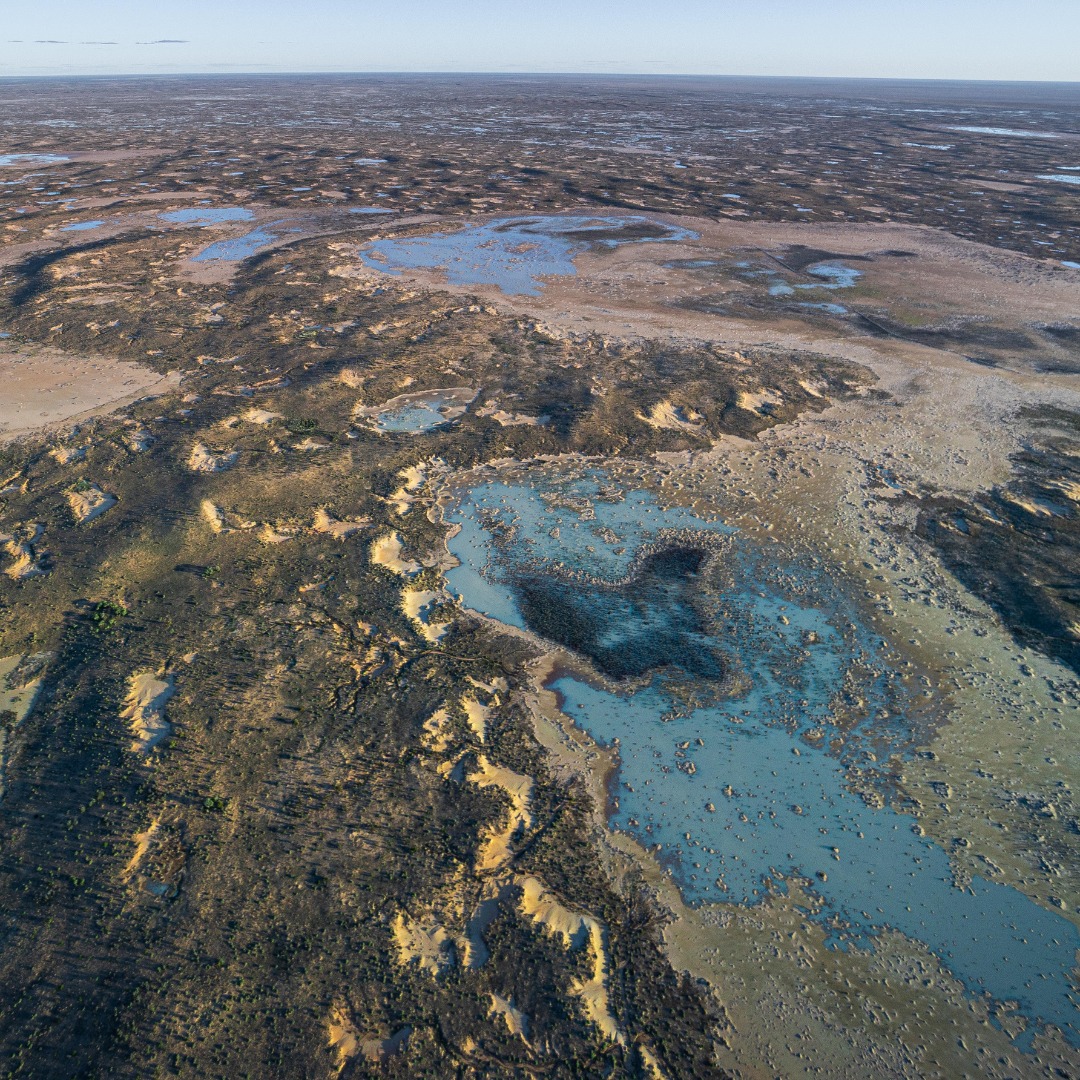
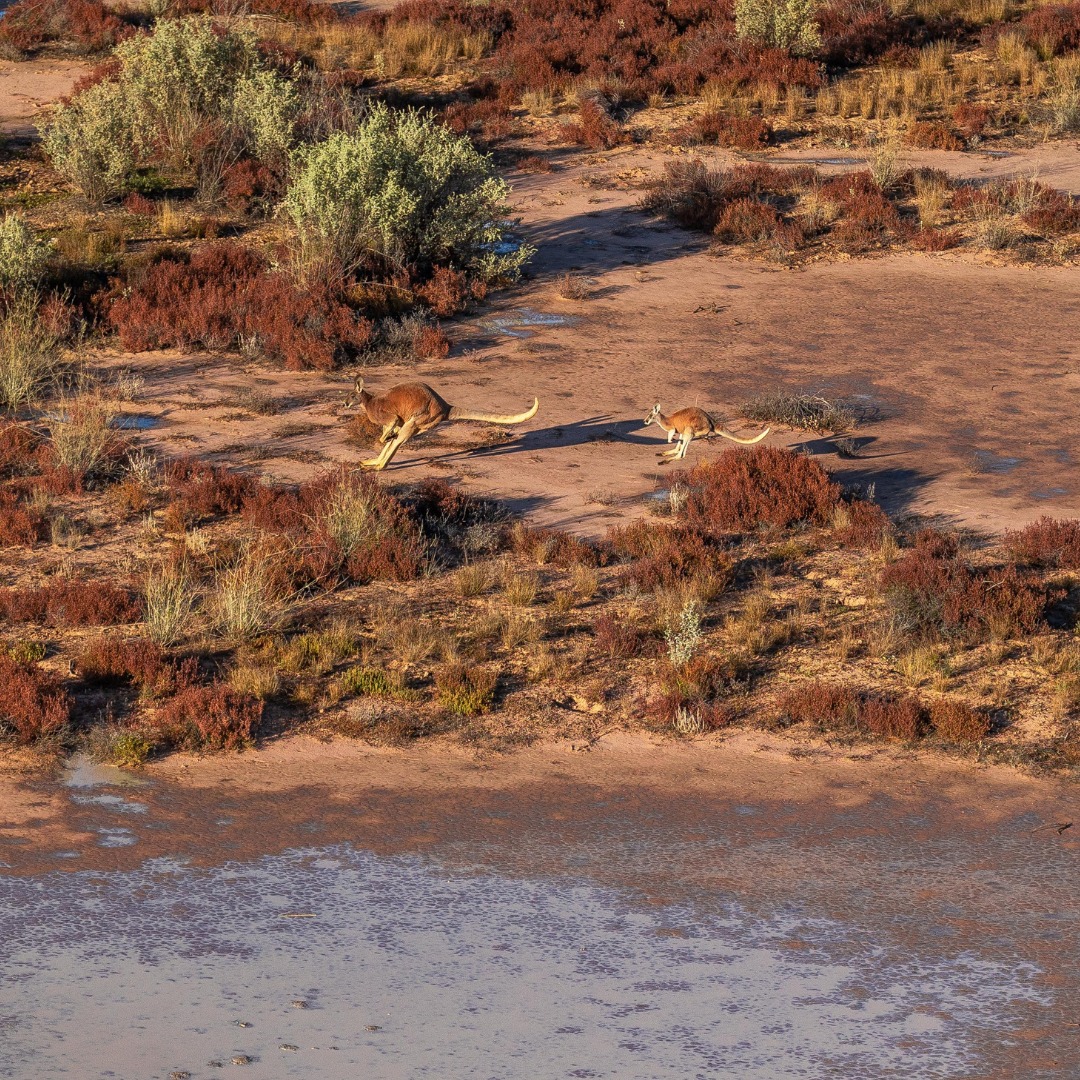
Photos: Alex Pike/DPE.
Threatened species recover in fenced safe havens. But their safety is only temporary
Katherine Moseby, UNSW Sydney and John Read, University of AdelaideIf you want to see some of Australia’s most charismatic threatened mammals such as bilbies, boodies and stick-nest rats, chances are you’ll have to go to a zoo – or a safe haven.
What’s a safe haven? An area safe from feral predators, such as islands too far offshore for foxes to swim to, or mainland sites ringed with cat- and fox-proof fences.
Recent research has suggested we can now take 29 species off the threatened list, thanks in large part to safe havens. But unfortunately, it’s not that simple, as we’ve found in establishing several havens. Safe havens are not the same as the wild. When we try to reintroduce animals outside the fences, they disappear down the maws of cats and foxes.
Yes, they fend off extinctions. But safe havens require ongoing management, which is expensive, challenging and rarely guaranteed long term. We should not rely on them to take species off the threatened list.
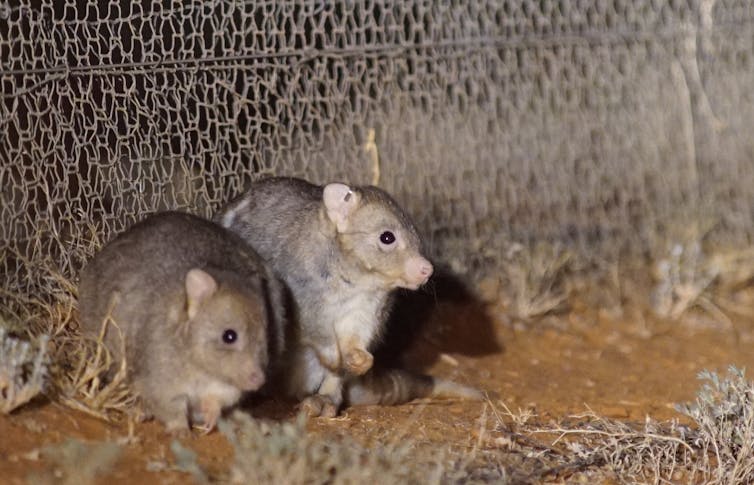
What Are Safe Havens For?
In 1995, Australia had just a handful of havens. By 2017, we had 17 mainland havens and 101 island refuges, housing 38 different threatened mammals. The reason is they work, at least over the short term. Most of our threatened mammals are small and unwary, easy prey for two introduced predators which hunt by stealth.
When you take off the pressure from cats and foxes, reintroduced animals bounce back. Inside safe havens, populations soar by an average of 680% over a 17-year period. Outside, their populations declined by an average of 63%. No wonder governments are funding them.
Fenced safe havens are usually small, to make it possible to remove all feral predators and keep watch for any making it over the fence. The threatened mammals inside the fence are isolated, meaning they have a higher chance of inbreeding and are more vulnerable to random disasters. Sometimes, havens even provide extra food and water.
There are worrying signs these islands ringed by fence or sea are not entirely sustainable. Many species within safe havens breed frantically, sending their populations skyward to unsustainable levels before a severe population crash. Ideally, they would be controlled by native predators, but the havens are too small to allow this. We’ve seen this play out with burrowing bettongs at one of our safe havens, Arid Recovery, in South Australia.
Some species struggle even inside fenced havens. The stick-nest rat has failed to establish in at least four havens.
Are Safe Haven Animals ‘Wild’? Not Quite
Let’s say you have a growing population of bilbies in our zoo network. Does this mean the species is now safe? Hardly. Safe in zoos doesn’t mean species are safe in the wild.
Safe havens are similar. Yes, the animals are free-roaming. They forage, breed and hide from predators such as snakes and eagles. But safe havens are created and sustained by people. When havens lose funding and fall into disrepair, the predators eventually break in and kill everything they can. Fenced off Shark Bay bandicoots in Western Australia were eventually killed by cats.
When the government works out if a species is threatened or not, it counts the animals in safe havens as contributing to the wild population.
If we use this measuring stick, mammals like the bilby, boodie, stick-nest rat, golden bandicoot and Shark Bay bandicoot can indeed be taken off the threatened species list.
But this seems hasty. Threatened species are defined as those where a “relatively large risk of extinction in the wild, sometime in the future, is deemed to exist for a species”, according to our key biodiversity law, the Environment Protection and Biodiversity Conservation Act.
If we remove a species from the threatened species list, we could place it at even higher risk of extinction.
When a species is threatened, it gets special consideration. Mining companies and developers have to ensure plans for land in its range won’t cause significant harm to the species. Companies may have to provide offsets to any damage. At the very least they are required to survey and monitor the species.
Consider the iconic bilby, whose range has shrunk by more than 80% in the last 150 years. It’s now found in the wild only in a small part of Queensland and in remote parts of Northern Territory and Western Australia.
Reports suggest it’s still declining in the wild, due to foxes and cats, more intense grazing and dangerous fire regimes. But because bilbies have been successfully reintroduced to islands and fenced safe havens, they no longer meet the criteria for being threatened.
Let’s say we remove them from the list. They would lose any special consideration when projects affecting their habitat are proposed, and conservation funding would dry up. Bilbies could quietly go extinct in the wild while reintroduced fenced populations thrive, at least in the short term.
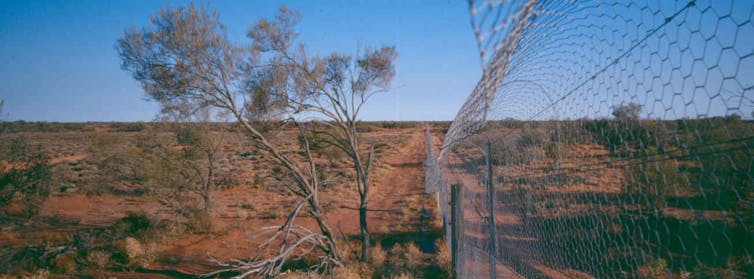
Does This Mean Safe Havens Are A Bad Idea?
No. We’ve co-founded four fenced safe havens to protect populations of nine threatened species. They are necessary. They ward off extinction and let us research the species. But they are only the first step to recovery.
It’s much harder to reverse the decline of threatened species in the wild. But it’s not impossible. Gene drive technology is maturing, potentially making it possible to force feral predators to breed themselves out of existence by having only male offspring. Almost 70% of Australians favour this approach, if viable. We also have biological controls, new control tools and improved management of fire to draw on. ˇ
Havens are exactly that – a desperate measure to stop extinction. We should keep species on the threatened list even if they have management-dependent haven populations. This will protect wild populations and drive innovation and interest in how we can best control feral predators and other threats.
We cannot simply put our threatened mammals behind fences and consider the job done. ![]()
Katherine Moseby, Associate Professor, UNSW Sydney and John Read, Associate Lecturer, Ecology and Environmental Sciences, University of Adelaide
This article is republished from The Conversation under a Creative Commons license. Read the original article.
Australia's Rarest Bird Of Prey Disappearing At Alarming Rate
February 28, 2023
Australia's rarest bird of prey -- the red goshawk -- is facing extinction, with Cape York Peninsula now the only place in Queensland known to support breeding populations.
PhD candidate Chris MacColl from The University of Queensland's School of Earth and Environmental Sciences led the research project that made the discovery and was shocked by the hawk's dwindling numbers.
"Over four decades the red goshawk has lost a third of its historical range, which is the area that's it's previously been known to occupy," Mr MacColl said.
"It's barely hanging on in another 30 per cent of regions it has previously been known to inhabit."
Mr MacColl said the species is now considered extinct in New South Wales and the southern half of Queensland.
"There has been a noticeable decline in North Queensland too, leaving Cape York Peninsula as the last place in the state still known to support breeding populations," Mr MacColl said.
"The Top End, Tiwi Islands and Kimberley are the red goshawk's last remaining stronghold, making northern Australia critical to its ongoing survival."
The unique bird of prey has long captivated bird watchers, with its striking reddish-brown plumage, deeply fingered wing tips, heavy yellow legs and over-sized talons.
The research team analysed four decades of sightings by citizen scientists to uncover the concerning population trends.
"The threats driving the red goshawk's decline require further investigation, but we believe habitat loss and degradation have played a key role," Mr MacColl said.
Study co-author Professor James Watson said the dramatic loss of the species means governments and communities need to be proactive in conserving remaining habitats.
"An increase in agricultural, mining and gas projects across northern Australia pose a real risk to a species like this, given what we've observed throughout its eastern range," Professor Watson said.
"Northern Australia supports the largest intact tropical savanna ecosystem in the world and hosts an abundance of biodiversity.
"Conservation efforts aimed at securing an emblematic species like the red goshawk in these areas will benefit many other species given the species is a top-predator."
The study authors back calls for the Commonwealth Government to amend the red goshawk's national conservation status from Vulnerable to Endangered, so the bird can be afforded greater conservation priority.
The research was funded by Rio Tinto and supported by the Queensland Department of Environment and Sciences (DES) and the Australian Wildlife Conservancy (AWC).
Christopher MacColl, Nicholas P. Leseberg, Richard Seaton, Stephen A. Murphy, James E.M. Watson. Rapid and recent range collapse of Australia’s Red Goshawk Erythrotriorchis radiatus. Emu - Austral Ornithology, 2023; 1 DOI: 10.1080/01584197.2023.2172735
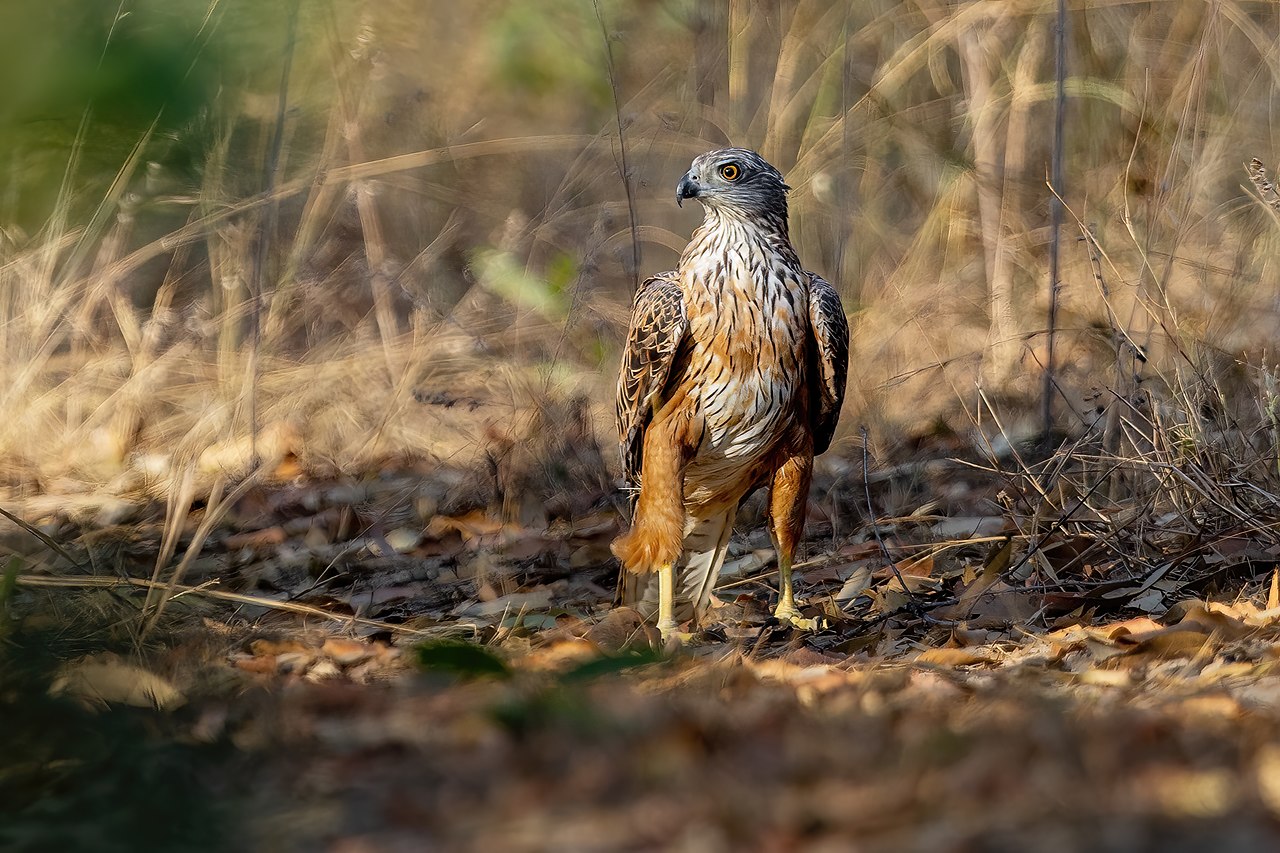
Red Goshawk female in the Cape York Peninsula photo by J J Harrison
Move over, honeybees: Aussie native bees steal the show with unique social and foraging behaviours

Australian native bees have evolved complex social structures and foraging behaviours that help biologists answer longstanding questions, such as the origins of social behaviour, and the drivers of increased biodiversity.
In European honeybees, the queen governs the hive with her sterile female workers. Meanwhile, the males are little more than freeloaders, or hangers-on (sorry boys).
But most Australian bees are different. Some are solitary. Others live in cooperative, egalitarian societies where individuals share and jointly defend a nest. There is no clear division into queen and worker castes.
Our new research, in the journals Biology Letters and Apidologie, reveals fresh insights into the evolution and ecology of Australian bees. These creatures deserve more attention and respect, not only for the ecosystem services they provide, but for the scientific lessons they can teach us.
Unusual Bee-Haviour
All bees face pressure from parasites and predators. But we discovered a unique strategy in one Australian species known as the capricious masked bee (Amphylaeus morosus).
Of the more than 2,000 species in the highly diverse Colletidae bee family, only the capricious masked bee is known to be social. Females that choose to cooperate can dramatically improve their defence against enemies such as parasitoid wasps and flies.
In these cooperative groups, one female protects the developing brood while the mother is away on foraging trips. (European honeybee queens rely on workers for such tasks, while they stay home.)
The guards do not produce their own offspring. However, guarded colonies do tend to produce more offspring - and the extras are always males.
However, having too many nest guards in the population can lead to an excess of males. When males greatly outnumber females, far fewer males (compared to females) will reproduce and pass on their genes. This reduces the genetic “value” of males and in turn cooperative behaviour.
Eventually, the relative benefit of cooperative nesting is diminished. We suggest this limits the frequency of the nest guard strategy, putting the brakes on further social evolution.

The Birds And The Bees
When we took a closer look at the diet of other Australian colletid bees (also known as plasterer bees due to the way they smooth the walls of their nest cells with secretions that dry to a cellophane-like lining), we found it varied considerably.

One group in particular only visited a very restricted range of plants. This group, the euryglossines, account for almost a quarter of all Australian bee species. So why are they so fussy?
The answer may lie in the nature of the food itself. Euryglossines clearly prefer plants in the family Myrtaceae. These include the gums, melaleucas, and tea trees that dominate Australian landscapes and provide massive amounts of pollen and nectar. Their shallow, brush-like flowers are also easy for small bees to access.
These same distinctive flowers are heavily used by parrots such as ringnecks, lorikeets and rosellas - who also love pollen and nectar. This floral system has likely been shaped by co-evolution of parrots and gum trees, and we suspect it was later exploited by euryglossine bees and helps account for their high species diversity. Clearly they are both onto a good thing.
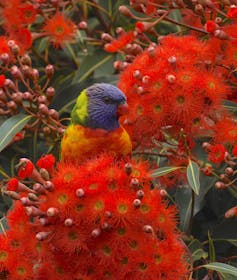
This research supports what many have suspected for years. Natives typically need other natives to flourish. Our native bees rely on our native plants, even if some have more flexible diets than others.
Spend some time looking at a flowering gum and you’re almost certain to see some of our tiniest but hardest-working pollinators - along with some of the brightest and loudest.
How To Observe Australian Bees
It is all very well for expert bee nerds, like us, to tell you about the value of native species. But to really appreciate our native bees, you should try observing them for yourself: they are all around us, but often smaller and less ostentatious than European honeybees.
Native bees are easy to spot, even in urban environments. Parklands, roadside verges, and even our gardens are full of them. Look for them at work pollinating flowers - they might look like little dark flies initially, but closer inspection will reveal their true bee shape.
They can be nesting in bare patches on the ground, the soft stems of tree ferns or grass trees, in the “bee hotels” made by people, or even pruned rose and hydrangea bushes. Just check for little perfectly round holes with insects buzzing around. With a bit of patience, a cold drink, and a comfy stool or cushion, one can watch these entrances and see critters hard at work.
Social Australian stem nesting bees are surprisingly complex, even though their colonies rarely contain more than four or five females. Watch for guard bees plugging the nest entrance with their red or black abdomens, while other females go to collect food. With extra patience it is possible to see ants or tiny wasps gather around the nest entrances, waiting for an unguarded moment to attack.
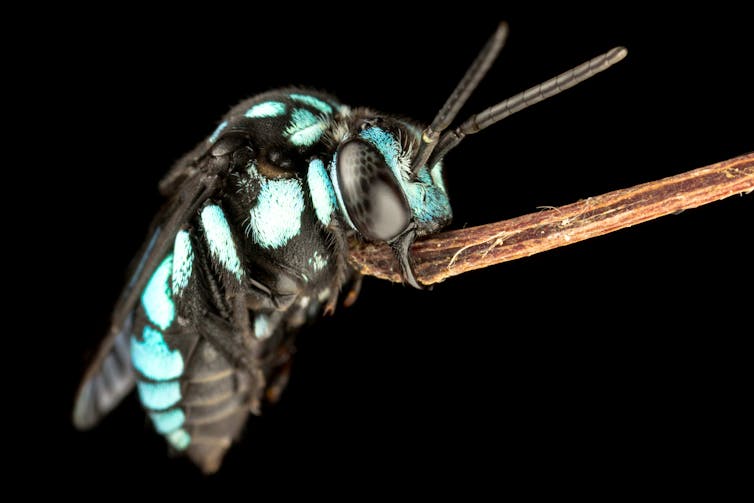
Australia has more than 1,650 native bee species. We encourage you to enjoy them on flowers, in the ground, in stems, or wherever you can find them. These little animals have a lot to offer us in terms of how we understand the world, in addition to being vital parts of the ecosystem. And importantly, they are our responsibility to understand and protect.![]()
James B. Dorey, Adjunct Associate Professor, Flinders University; Lucas Hearn, Researcher, Flinders University; Mike Lee, Professor in Evolutionary Biology (jointly appointed with South Australian Museum), Flinders University, and Patricia S. Slattery, Postgraduate Student, Flinders University
This article is republished from The Conversation under a Creative Commons license. Read the original article.
Human-Wildlife Conflicts Rising Worldwide With Climate Change
February 27, 2023
Research on the impacts of climate change often considers its effects on people separately from impacts on ecosystems. But a new study is showing just how intertwined we are with our environment by linking our warming world to a global rise in conflicts between humans and wildlife.
The research, led by scientists at the University of Washington's Center for Ecosystem Sentinels and published Feb. 27 in Nature Climate Change, reveals that a warming world is increasing human-wildlife conflicts.
"We found evidence of conflicts between people and wildlife exacerbated by climate change on six continents, in five different oceans, in terrestrial systems, in marine systems, in freshwater systems -- involving mammals, reptiles, birds, fish and even invertebrates," said lead author Briana Abrahms, a UW assistant professor of biology. "Although each individual case has its own array of different causes and effects, these climate-driven conflicts are really ubiquitous."
To identify trends, the team pored over published, peer-reviewed incidents of human-wildlife conflicts and identified cases that were linked specifically to the effects of climate change. These include both short-term climate events -- such as a drought -- as well as longer-term changes. Warming in the Arctic, for example, is leading to loss of sea ice which has left polar bears short of food. They increasingly travel on land, sometimes entering human settlements and attacking people, as a recent incident in Alaska illustrates.
The new study shows that climate shifts can drive conflicts by altering animal habitats -- like sea ice for polar bears -- as well as the timing of events, wildlife behaviours and resource availability. It also showed that people are changing their behaviours and locations in response to climate change in ways that increase conflicts. Other examples of the effects of short- and long-term climate events include:
- Torrential floods in Tanzania led to more lion attacks after their usual prey migrated away from floodplains.
- Higher air temperatures in Australia triggered more aggressive behavior in eastern brown snakes, leading to more incidents of snake bites.
- Wildfires in Sumatra, Indonesia -- triggered by El Nino -- drove Asian elephants and tigers out of reserves and into human-inhabited areas, leading to at least one death.
- Disruption of terrestrial food webs during La Nina events in the Americas drove black bears in New Mexico and foxes in Chile into human settlements in search of food.
- Warmer air and ocean temperatures in a severe El Nino led to an increase in shark attacks in South Africa.
Most cases of human-wildlife conflict linked to climate involve a shift in resources -- not just for wildlife, but also for people.
A majority of cases on land also involved a change in precipitation, which will continue to be affected by climate change. Many resulted in human deaths or injuries, as well as property damage.
In 2009, for example, a severe drought struck the western part of Tanzania's Kilimanjaro Region. This reduced food supplies for African elephants, which in turn entered local fields to graze on crops -- at times destroying 2 to 3 acres daily. Local farmers, whose livelihoods were directly threatened by the drought, at times resorted to retaliatory killings of elephants to try to mitigate these raids.
"Identifying and understanding this link between human-wildlife conflicts is not only a conservation issue," said Abrahms. "It is also a social justice and human safety issue."
These types of conflicts are likely to rise as climate change intensifies, particularly as mass migrations of people and wildlife increase and resources shift.
But, it doesn't have to be all bad news.
"One major motivation in studying the link between climate change and human-wildlife conflict is finding solutions," said Abrahms. "As we learn about specific incidents, we can identify patterns and trends -- and come up with interventions to try to address or lessen these conflicts."
Some interventions may be as simple as public-awareness campaigns, such as advising residents of the American Southwest during La Nina years to carry bear spray on a hike. Governments can also plan for times when extreme climate events will bring people and wildlife into closer contact. Botswana, for example, has funds in place to compensate herders and ranchers for drought-induced attacks by wildlife on livestock, often in exchange for pledges not to engage in retaliatory killings of wildlife.
"We have effective drought forecasts now. So, governments can engage in fiscal planning for mitigating conflicts ahead of time," said Abrahms. "Instead of a 'rainy day' fund, have a 'dry day' fund."
To Abrahms, one success story of note lies in the waters of the eastern Pacific. In 2014 and 2015, a record number of humpback and blue whales became ensnared in fishing lines off the California coast. Research later showed that an extreme marine heat wave had pushed whales closer to shore, following their primary food sources. California regulators now adjust the start and end of each fishing season based on climate and ocean conditions in the Pacific -- delaying the season if whales and fishing gear are likely to come into close contact.
"These examples show us that once you know the root causes of a conflict, you can design interventions to help both people and wildlife," said Abrahms. "We can change."
Co-authors on the paper are UW postdoctoral researchers T.J. Clark-Wolf, Anna Nisi and Kasim Rafiq; UW doctoral students Erik Johansson and Leigh West; Neil Carter, an associate professor at the University of Michigan; Kaitlyn Gaynor, an assistant professor at the University of British Columbia; and Alex McInturff, UW assistant professor of environmental and forest sciences.
Briana Abrahms, Neil H. Carter, T. J. Clark-Wolf, Kaitlyn M. Gaynor, Erik Johansson, Alex McInturff, Anna C. Nisi, Kasim Rafiq, Leigh West. Climate change as a global amplifier of human–wildlife conflict. Nature Climate Change, 2023; DOI: 10.1038/s41558-023-01608-5
Blue Whale Foraging And Reproduction Are Related To Environmental Conditions
February 28, 2023
A new study of New Zealand blue whales' vocalizations indicates the whales are present year-round in the South Taranaki Bight and their behaviour is influenced by environmental conditions in the region.
The findings are a significant advancement in researchers' understanding of the habitat use and behaviour of this population of blue whales, which Oregon State University researchers first identified as genetically distinct from other blue whale populations less than a decade ago.
"We went from not knowing 10 years ago whether this was a distinct population to now understanding these whales' ecology and their response to changing environmental conditions," said the study's lead author, Dawn Barlow, a postdoctoral scholar in OSU's Marine Mammal Institute. "These findings can inform conservation management of this blue whale population and their habitat."
The patterns and intensity of the whales' calls and songs over two years showed strong seasonality in their foraging and breeding behaviour, and the vocalizations changed based on environmental conditions such as a documented marine heatwave, Barlow said.
"During the marine heatwave, feeding-related calls were reduced, reflecting poor foraging conditions during that period," Barlow said. "But we also saw changes in vocalizations in the next breeding period, an indication that they put less effort into reproduction following a period of poor feeding conditions."
The study was just published in the journal Ecology and Evolution. Barlow conducted the research as a doctoral student in the Geospatial Ecology of Marine Megafauna Laboratory at Hatfield Marine Science Center in Newport, led by associate professor Leigh Torres, a co-author of the new paper.
Blue whales are the largest of all whales and are found in all oceans except the Arctic. Their populations were depleted due to commercial whaling in the early 1900s, and today they are listed as endangered under the International Union for Conservation of Nature's Red List of Threatened Species.
The New Zealand whales' habitat overlaps with a wide range of commercial activities, including oil and gas exploration and extraction, vessel traffic, fisheries, wind energy development and possible seabed mining.
Torres first hypothesized in 2013 that the South Taranaki Bight, between New Zealand's North and South Islands, was an undocumented blue whale feeding ground. Following comprehensive data collection efforts, and using multiple lines of evidence, Torres, Barlow and colleagues were able to document in 2018 that the population in this region was genetically distinct from other blue whale populations.
Previous research was primarily based on observations researchers made during visits to the region in the summer months. But the researchers wanted to know more about the whales' behaviour during other parts of the year. They placed five hydrophones -- a type of underwater microphone -- that recorded continuously between January 2016 and February 2018, with only brief gaps to retrieve data every six months.
"Unlike many other baleen whales, this population stays in this region year-round," Barlow said. "That means we can monitor what they are doing from one location. Listening is an effective way to do that."
The hydrophone recordings showed that the whales' "D" calls were strongly correlated with oceanographic conditions related to upwelling in the spring and summer. Upwelling is a process where deeper, cooler water is pushed toward the surface; the nutrient-rich water supports aggregations of krill that the blue whales feed on. The whales' D calls were more intense during periods of strong upwelling.
The recordings also showed that the whales' song vocalizations, which are produced by males and associated with breeding behaviour, followed a highly seasonal pattern, with peak intensity in the fall. That timing aligns with past whaling records' estimates of conception, Barlow said.
The hydrophone evidence of the breeding behaviour and the whales' presence in the region year-round can influence the animals' national threat classification status, which impacts management practices, the researchers said.
Blue whales in New Zealand had been classified as migrant, but as a result of the research by Torres, Barlow and colleagues, the classification of has changed from migrant to data deficient. If the whales are reclassified as a resident population, that could impact management practices, but evidence of breeding in New Zealand is needed for that change to occur, the researchers said.
"Although no one has actually documented blue whales mating -- it is hard to observe that directly -- the increase in song during the expected time of mating is a strong indication of breeding in New Zealand waters," Torres said. "Our study adds more evidence that these are resident New Zealand blue whales."
Once the researchers were able to make the link between the whales' behaviour and their calls, they could then look at the calls and behaviour relative to environmental patterns. Specifically, they noted how the whales' foraging and breeding behaviour changed during and after a 2016 marine heatwave.
During the marine heatwave, there were fewer aggregations of krill for the whales to feed on, which the researchers documented in a previous study. The reduction in foraging behaviour correlated to less intense D calls during that period, and in the next breeding season, the breeding songs were also less intense.
The findings raise additional questions about how changing ocean conditions and human activity in the region are impacting the New Zealand blue whale population and reinforce the need for continued monitoring, the researchers said.
"We have come so far in 10 years in our knowledge of these blue whales -- from not knowing this population existed to now understanding their year-round use of this region for feeding, mating and nursing," Torres said. "New Zealanders should be excited and proud that their country is home to its own unique population of blue whales. We hope our work helps Kiwis manage and protect these whales."
Additional coauthors are Holger Klinck, director of the Cornell University K. Lisa Yang Center for Conservation Bioacoustics, who also is affiliated with OSU's Marine Mammal Institute; Dimitri Ponirakis of Cornell; and Trevor Branch of the University of Washington. The Marine Mammal Institute is part of Oregon State's College of Agricultural Sciences.
Dawn R. Barlow, Holger Klinck, Dimitri Ponirakis, Trevor A. Branch, Leigh G. Torres. Environmental conditions and marine heatwaves influence blue whale foraging and reproductive effort. Ecology and Evolution, 2023; 13 (2) DOI: 10.1002/ece3.9770
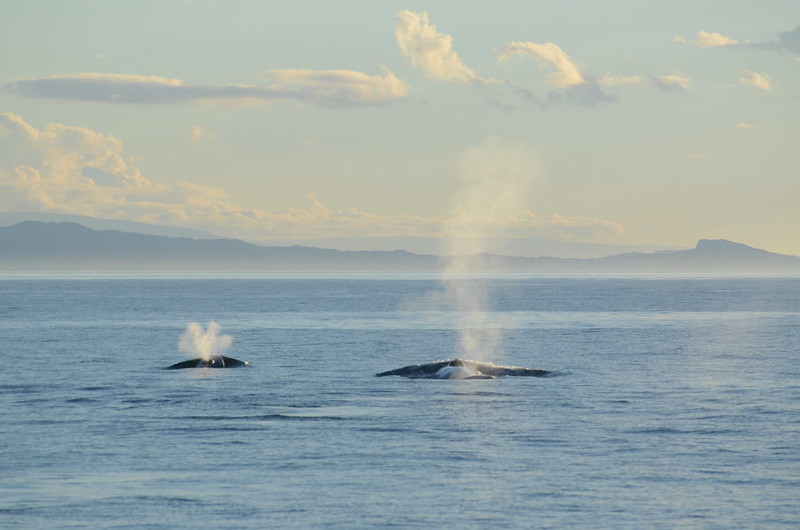
A blue whale mother-calf pair surfaces in New Zealand's South Taranaki Bight. Photo credit: Kristin Hodge.
Water buybacks are back on the table in the Murray-Darling Basin. Here’s a refresher on how they work

The federal government has announced a new round of strategic water buybacks in the Murray-Darling Basin. The government intends to purchase water entitlements from voluntary sellers in parts of New South Wales and Queensland.
A total of 49.2 gigalitres (GL) will be purchased across seven catchment areas through open, competitive and transparent tenders. This water will then be returned to the environment.
The government decided to restart buybacks because other methods, such as water-saving and offset measures both on and off farms, have been less effective and won’t be achieved in time. There is a 49.2GL “gap” between the current revised 2,075GL target set for June 30 2024, and the amount of water recovered so far.
The Morrison government effectively stopped using buybacks as a tool when Barnaby Joyce became federal water minister. Over time, the Murray-Darling Basin Plan – and buybacks in particular – became a focal point of blame for all kinds of problems in rural communities.
This blame played out in legislation to cap water recovery via buybacks in 2015. Although the Howard government introduced the water recovery schemes from 2007-08 onwards, it was the Rudd/Gillard governments that achieved the largest amount of water recovery. The Albanese government is now trying to get water policy and recovery back on track.
Why Are We Recovering Water For The Environment?
Over the past 50 years, water has been over-allocated to agriculture in the Murray-Darling Basin. Coupled with the catastrophic Millennium Drought in the 2000s, this meant many ecosystems, and rural communities, were at crisis point. The Water Act 2007 and the Murray-Darling Basin Plan aimed to return water from irrigation to environmental use.

There were considerable arguments regarding how much water was needed for a sustainable river basin, and the final amount of 2,750GL legislated in 2012 was far less than the original proposal. Actual physical water recovery was then whittled downwards again in the 2018 Basin Plan amendment to 2,075GL, which reduced water recovery in the northern basin and implemented a sustainable diversion limit adjustment mechanism offset, made up of supply and efficiency projects.
To appease South Australia – which, as the downstream state, suffers the most negative consequences of a declining river system – an extra 450GL was included as an additional target in 2012. This was to be achieved solely through efficiency measures such as upgrading irrigation infrastructure from gravity-fed to drip irrigation, or reducing evaporation from irrigation delivery channels. So far, only a few gigalitres have been achieved of this additional 450GL.
Environmental Water Recovery Methods
Water recovery has so far occurred via two main mechanisms that have cost a total of $7.2 billion. The main method is buybacks, with $2.67 billion spent to recover 1,228GL of water. Buybacks allow farmers to spend the money wherever they want, whether it be on reducing debt, reinvestment, improving productivity or adapting to dry conditions.
The second has mainly involved subsidising irrigation infrastructure on and off farms to improve water efficiency or to achieve water offsets. So far, $4.52 billion has been spent on things such as lining channels, or changing irrigation systems, which has garnered the 693GL now held in water licences by the government.

Data provided by the Department of Climate Change, Energy, the Environment and Water in late 2022 suggests that on average, just over $2,100 per megalitre has been spent to recover water through buybacks, and more than $6,550 per megalitre to recover water through irrigation infrastructure subsidies. This is one of the reasons buybacks have been the most successful policy instrument in delivering water recovery. Most of this was already achieved by 2015, and since then, only some small strategic purchases have been made.
This cost differential in water recovery methods is expected to widen substantially. Water recovery projects put forward by states are now quoting huge amounts of money, regularly figures over $20,000 per megalitre.
On and off-farm efficiency projects have also been heavily criticised for their lack of effectiveness. The net “additional” increase to environmental water holdings is questionable, due to the fact they lead to reduced return flows into groundwater and surface water. There are also question marks over whether some supply “environmental equivalence” projects will actually work.
Water Policy Reversals
Following the introduction of the Basin Plan legislation in 2012, water policy has gone backwards. Capping buyback purchases to a total of 1,500GL in 2015 is one such example. This halted the most effective instrument we have in recovering water.

Lobbyists and irrigator groups have been successful in spreading misinformation and fostering widely held beliefs that buybacks are responsible for large-scale rural economic decline. Indeed, there is a “Beyond Buyback” campaign underway right now.
However, it has been shown that the social costs of buyback have been overestimated and the benefits underestimated.
Rural and farm prosperity reflects a more complex mix of factors, including falling commodity prices, increasing input costs, and climate change.
Environmental water has many benefits for rural communities, right across the Basin. Unfortunately these facts are often ignored, both in media commentary and in some very dodgy economic modelling that relies on highly simplistic and unrealistic assumptions about the impacts of water recovery.
What Do We Need To Do Next?
The very first Nobel Prize in Economics – Jan Tinbergen (1969) - was given for work demonstrating that one policy is needed to address one objective. If we have one policy for multiple objectives, unexpected responses occur.
When we subsidise irrigation infrastructure in order to meet farm productivity, economic development and environmental water recovery objectives, sometimes we end up not achieving our original aim – namely net water recovery for the environment.
Hence, the federal government’s announcement of the latest round of buybacks is very welcome, for it allows us to use the most effective instrument we can for environmental water recovery. Let’s hope we can use these lessons for the additional 450GL of water recovery, and for starting a conversation about cultural water rights.
This does not mean we don’t have to worry about rural regional consequences of water reform – of course we do. But let’s use the best policy options we have to address those issues.
For example, research shows that money spent on regional development (such as in essential social services) creates three to four times more jobs than efficiency upgrades. The Productivity Commission suggested there was little evidence that existing economic structural adjustment policies in the Murray-Darling Basin have helped local communities transition through water reforms.
In an era of climate change, we must grapple with the best ways to share water, and look after all interests as best as we can.![]()
Sarah Ann Wheeler, Professor in Water Economics, University of Adelaide
This article is republished from The Conversation under a Creative Commons license. Read the original article.
What if urban plans gave natural systems the space to recover from the cities built over them? It can be done
Louise Wright, Monash University and Catherine Murphy, Monash UniversityOur cities have altered their original landscapes so greatly that their natural systems are profoundly compromised. These systems – such as swamps, rivers, creeks, aquifers and bushland corridors – need more space to function properly. Sometimes they assert their underlying presence through land subsidence, floods and fires. As Margaret Cook wrote in her history of Brisbane floods, the Brisbane River is “a river with a city problem”.
In Australia, Melbourne in particular has been hugely altered. Historian James Boyce wrote:
Of all Australia’s major cities the natural environment of Melbourne before British settlement is perhaps the most difficult now to imagine. This is in part a product of the city’s size and flat topography, but it also reflects the extent to which the region was dominated by swamps and grasslands – the two ecosystems that were most comprehensively transformed by the conquest.
In response to climate change threats, cities around the world are making space to restore natural systems such as creeks, rivers, wetlands and vegetation on a larger scale. But this is an enormous task. These systems have been concreted, filled in or built over since the industrial revolution.
Sometimes Ecosystems Are Restored
One example of restoration is in Elsternwick, a suburb of southeast Melbourne. Here an ephemeral wetland behind the coastal dunes, on the traditional lands of the Yaluk-ut Weelam, Boon Wurrung clan of the Kulin Nation, was drained and filled. It became a parkland, trotting track and then golf course. Now a constructed wetland is transforming Yalukit Willam Nature Reserve (formerly Elsternwick Park) into a modified version of its former self.
There are many such projects, but still not nearly enough. They tend to be site-specific and isolated, lacking the connection to larger landscape-scale systems so crucial to their proper functioning. For instance, while water from the Elster Creek now flows “naturally” through a chain of ponds in the former Elsternwick golf course, for most of its length the creek is still a channel under and above ground.
When more space needs to be reserved for public benefit and use, the government can compulsorily acquire it through legislation, such as the Land Acquisition and Compensation Act 1986 (Vic), and through planning schemes, via an instrument called a public acquisition overlay.
The overlay was used in Victoria to remove the suburb of Summerland on Phillip Island over 25 years to conserve and restore habitat for penguins.
Similarly, housing in high fire risk areas was compulsorily acquired to reforest land in the Dandenong Ranges east of Melbourne in the 1970-80s. More recently in New South Wales this approach is being used to move housing away from flood zones in Lismore and the Northern Rivers.
More Often Natural Systems Lose Contest For Space
Most commonly, such mechanisms are used to make space for roads and other infrastructure. A current example is in the Melbourne suburb of Bulleen, just 50 metres from the Birrarung (Yarra River). Around 80 industrial buildings are making way for the Manningham Road Interchange of the North East Link project.
Meanwhile, the natural systems of the Birrarung struggle for enough space.
The story of the dispossession and transformation of the river corridor along the bends, floodplains and billabongs known as Banyule-Bulleen Flats is repeated across Australia. This important cultural place of rich food and resources for the Wurndjeri Woi Wurrung was capable of sustaining up to 500 people. It was cleared, farmed and grazed from the mid-1880s.
Piecemeal development has intensified the use of this once cheap, low-lying, flat land. This 2km by 1km parcel of land has been given over to an 18-hole golf course, 27-house estate, six sporting ovals, six soccer pitches, six clay tennis courts, three indoor basketball courts, an archery field, parking across multiple sites for at least 600 cars, a large social club with restaurant, futsal court and convention rooms, major electrical pylons, the large scar of a former drive-in cinema, a web of paths, fences, barriers, toilets, clubrooms, playgrounds and, until recently, an industrial estate.
Very soon, there will be a six-lane tunnel. The land being used for its construction is the subject of “future development potential”.
All this human activity is located there largely due to floodplains not being valued. Yet this area contains the last significant remnants of a network of billabongs and riparian woodlands with centuries-old river red gums.
How Can Urban Plans Help Restore Natural Systems?
Planning schemes are meant to recognise the environmental and cultural value of land. They regulate the use of land, what can be built there, and how we should go about it.
However, each intervention is mostly assessed at the scale of the parcel of land. The process has little to do with the land’s role in a wider, underlying and connected ecological structure.
We need an alternative urban plan that foregrounds and provides space for ecosystem regeneration. New and robust planning tools and governance processes are required if we acknowledge we cannot continue to urbanise areas of ecological significance and should repair and strengthen others.
Yes, we have detailed and careful regulations and controls for protection of vegetation, significant landscapes, land subject to flooding, and so on. But the fact is most buildings and development are not compatible with healthy natural systems that support the complex web of symbiotic relationships between soil, plants, animals and an array of other organisms.
We need urban plans that consolidate space for natural systems in our cities. This process will require long-term frameworks that strategically return land to enable connected ecological systems to function over large territories. To free up this space, urban density will have to increase in other areas through more intensive use of existing buildings and infrastructure.
This alternative approach will improve the quality and sustainability of our future cities.![]()
Louise Wright, Practice Professor of Architecture, Monash University and Catherine Murphy, Senior Lecturer in Urban Planning and Design, Monash University
This article is republished from The Conversation under a Creative Commons license. Read the original article.
The new major players in conservation? NGOs thrive while national parks struggle

It might surprise you to know that not-for-profit conservation organisations own, manage or influence growing chunks of Australia.
Not-for-profit NGOs such as The Nature Conservancy, Australian Wildlife Conservancy, Bush Heritage Australia and Trust for Nature contribute to management of over three million square kilometres, including owning about 50,000 square kilometres.
The land managed or owned by NGOs has grown at a staggering rate in Australia, which now has the second-largest percentage of land managed privately for conservation in the world, after the United States.
This growth has come as federal and state funding for protected areas has stagnated. Many of our national parks, for instance, are overrun with invasive mammals and weeds, while NGO-owned land tends to be better resourced and managed.
To have any chance of hitting our international commitment of 30% of land conserved by 2030, we will have to rely on fast-growing non-government conservation land alongside Indigenous Protected Areas.
How Did We Get Here?
In 1954, a group of US landowners were given an ultimatum: buy the 60 acre forest next to them, or see it developed. They bought it. From that event emerged The Nature Conservancy (TNC), a land trust which has protected over 50 million hectares of land worldwide, and spawned dozens of other land trusts across the globe.
In the 1970s, Australian conservationists launched their own efforts to acquire vital land. Now, the Australian Wildlife Conservancy manages, owns or influences around 1.7% of Australia; Bush Heritage Australia accounts for another 0.5%; and the Tasmanian Land Conservancy is heavily active in that state. There are a host of smaller land trusts, like Nature Glenelg Trust and Queensland Trust for Nature.
During the 1970s and ‘80s, there was strong growth in government conservation. Our public protected areas grew markedly. But then, interest and funding faltered. Queensland didn’t come close to its goal of protecting 17% of the state by 2020, for example.
That’s why conservation NGOs have stepped up, often in close partnership with First Nations groups. The US is further along this path, partly because of strong scepticism of government intervention. In Australia, we’ve tended to regard the preservation of nature as the government’s job. Unfortunately, our governments have never allocated sufficient funds to adequately stem the loss of species and habitat.
The Downside Of Protecting Large Areas? Ongoing Costs
One reason governments are wary of expanding their protected networks are the ongoing costs. Funding for management hasn’t kept pace with the growth of the reserve system. In part, that’s because Australia is really big and sparsely populated.
Science-based conservation means protecting samples of all habitat types, not just tracts of cheap infertile land. To protect 30% of Queensland would mean a park system the size of Spain. Then you have to look after it.
Why does management matter? Don’t you just need to find pristine bush, fence it and install a sign, a road, walking trails and an information kiosk?
No. Declaring a national park is the easy bit. In many parks, feral animals and invasive plants are all but uncontrolled. Plant diseases, cane toads, foxes, cats, blackberry, lantana – without management, the park will degrade rapidly. And then there’s the complexity of ensuring the right fire and flooding regime.
A smart organisation or government will put aside two to three times the cost of buying the land for management. The problem is, management costs do not excite us in the same way as acquisition.
And because we expect our national parks to be open to the public, budget constraints often means money goes to keeping facilities running, tracks open and little else. The money coming in from camping and ecotourism is a fraction of what’s needed to properly care for the government parks.
Why Are Conservation NGOs Better Placed?
NGOs are increasingly attracting donations and legacies from people interested in conservation action on the ground. These donors wouldn’t think to donate to the parks service – but they will to an NGO. The organisations can work strategically with landowners to, say, improve feral animal management on grazing land or fence off waterways, without actually taking ownership of the land.
Conservation NGOs also don’t have to open their areas to the public. Many do, but only at specific times of year. Others remain shut. By and large, they’re better managed than national parks – and some are much better, with intensive management such as feral-proof fences.

National park staff are often hamstrung by bureaucracy and budget, with limited resources to monitor and report successful outcomes. NGOs, by contrast, are very big on scientific reporting. A threatened species had a successful breeding season on their land? They’ll tell you because reporting conservation outcomes to donors is like reporting company returns to shareholders.
So when you see big-ticket plans to protect 30% of Australian land, you should know it’s not protection as you may have thought of it. It will draw very heavily on these NGOs and land protected by private individuals.
This shift towards a broader definition of conservation land is controversial.
In these newly expanded areas, there may be some environmental thinning of trees, targeted grazing and ecotourism, as well as areas closed to these activities. This is unavoidable. There are now very few areas free from our industries, cities and farms. What matters is finding ways to conserve the world’s wealth of species alongside us.
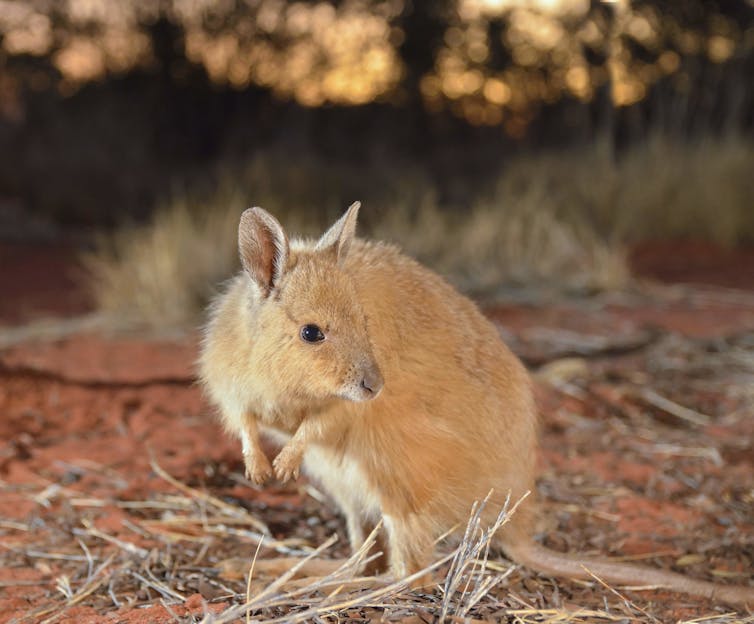
What Does This Mean For Me?
What we should take from this shift is we can no longer file environmental issues in that handy mental box we all have named “that’s why I pay tax”.
More and more, Australians are realising they don’t have to rely on the government to secure our natural heritage.
It’s not just the government’s problem. It’s a collective problem, which means it’s also your problem. More and more of us now realise the cavalry isn’t coming to the rescue. We are the cavalry.
Correction: this article originally stated The Nature Conservancy managed 1% of Australia, which is incorrect.![]()
Hugh Possingham, Professor, The University of Queensland
This article is republished from The Conversation under a Creative Commons license. Read the original article.
Pittwater Reserves: Histories + Notes + Pictorial Walks
A History Of The Campaign For Preservation Of The Warriewood Escarpment by David Palmer OAM and Angus Gordon OAM
A Walk Around The Cromer Side Of Narrabeen Lake by Joe Mills
America Bay Track Walk - photos by Joe Mills
An Aquatic June: North Narrabeen - Turimetta - Collaroy photos by Joe Mills
Angophora Reserve Angophora Reserve Flowers Grand Old Tree Of Angophora Reserve Falls Back To The Earth - History page
Annie Wyatt Reserve - A Pictorial
Avalon's Village Green: Avalon Park Becomes Dunbar Park - Some History + Toongari Reserve and Catalpa Reserve
Bairne Walking Track Ku-Ring-Gai Chase NP by Kevin Murray
Bangalley Headland Bangalley Mid Winter
Banksias of Pittwater
Barrenjoey Boathouse In Governor Phillip Park Part Of Our Community For 75 Years: Photos From The Collection Of Russell Walton, Son Of Victor Walton
Barrenjoey Headland: Spring flowers
Barrenjoey Headland after fire
Bayview Baths
Bayview Wetlands
Beeby Park
Bilgola Beach
Botham Beach by Barbara Davies
Bungan Beach Bush Care
Careel Bay Saltmarsh plants
Careel Bay Birds
Careel Bay Clean Up day
Careel Bay Playing Fields History and Current
Careel Creek
Careel Creek - If you rebuild it they will come
Centre trail in Ku-ring-gai Chase National Park
Chiltern Track- Ingleside by Marita Macrae
Clareville Beach
Clareville/Long Beach Reserve + some History
Coastal Stability Series: Cabbage Tree Bay To Barrenjoey To Observation Point by John Illingsworth, Pittwater Pathways, and Dr. Peter Mitchell OAM
Cowan Track by Kevin Murray
Curl Curl To Freshwater Walk: October 2021 by Kevin Murray and Joe Mills
Currawong and Palm Beach Views - Winter 2018
Currawong-Mackerel-The Basin A Stroll In Early November 2021 - photos by Selena Griffith
Currawong State Park Currawong Beach + Currawong Creek
Deep Creek To Warriewood Walk photos by Joe Mills
Drone Gives A New View On Coastal Stability; Bungan: Bungan Headland To Newport Beach + Bilgola: North Newport Beach To Avalon + Bangalley: Avalon Headland To Palm Beach
Duck Holes: McCarrs Creek by Joe Mills
Dunbar Park - Some History + Toongari Reserve and Catalpa Reserve
Dundundra Falls Reserve: August 2020 photos by Selena Griffith - Listed in 1935
Elsie Track, Scotland Island
Elvina Track in Late Winter 2019 by Penny Gleen
Elvina Bay Walking Track: Spring 2020 photos by Joe Mills
Elvina Bay-Lovett Bay Loop Spring 2020 by Kevin Murray and Joe Mills
Fern Creek - Ingleside Escarpment To Warriewood Walk + Some History photos by Joe Mills
Iluka Park, Woorak Park, Pittwater Park, Sand Point Reserve, Snapperman Beach Reserve - Palm Beach: Some History
Ingleside
Ingleside Wildflowers August 2013
Irrawong - Ingleside Escarpment Trail Walk Spring 2020 photos by Joe Mills
Irrawong - Mullet Creek Restoration
Katandra Bushland Sanctuary - Ingleside
Lucinda Park, Palm Beach: Some History + 2022 Pictures
McCarrs Creek
McCarr's Creek to Church Point to Bayview Waterfront Path
McKay Reserve
Mona Vale Beach - A Stroll Along, Spring 2021 by Kevin Murray
Mona Vale Headland, Basin and Beach Restoration
Mount Murray Anderson Walking Track by Kevin Murray and Joe Mills
Mullet Creek
Narrabeen Creek
Narrabeen Lagoon Catchment: Past Notes Present Photos by Margaret Woods
Narrabeen Lagoon State Park
Narrabeen Lagoon State Park Expansion
Narrabeen Rockshelf Aquatic Reserve
Nerang Track, Terrey Hills by Bea Pierce
Newport Bushlink - the Crown of the Hill Linked Reserves
Newport Community Garden - Woolcott Reserve
Newport to Bilgola Bushlink 'From The Crown To The Sea' Paths: Founded In 1956 - A Tip and Quarry Becomes Green Space For People and Wildlife
Pittwater Reserves: The Green Ways; Bungan Beach and Bungan Head Reserves: A Headland Garden
Pittwater Reserves, The Green Ways: Clareville Wharf and Taylor's Point Jetty
Pittwater Reserves: The Green Ways; Hordern, Wilshire Parks, McKay Reserve: From Beach to Estuary
Pittwater Reserves - The Green Ways: Mona Vale's Village Greens a Map of the Historic Crown Lands Ethos Realised in The Village, Kitchener and Beeby Parks
Pittwater Reserves: The Green Ways Bilgola Beach - The Cabbage Tree Gardens and Camping Grounds - Includes Bilgola - The Story Of A Politician, A Pilot and An Epicure by Tony Dawson and Anne Spencer
Pittwater spring: waterbirds return to Wetlands
Pittwater's Lone Rangers - 120 Years of Ku-Ring-Gai Chase and the Men of Flowers Inspired by Eccleston Du Faur
Pittwater's Parallel Estuary - The Cowan 'Creek
Resolute Track at West Head by Kevin Murray
Resolute Track Stroll by Joe Mills
Riddle Reserve, Bayview
Salvation Loop Trail, Ku-Ring-Gai Chase National Park- Spring 2020 - by Selena Griffith
Seagull Pair At Turimetta Beach: Spring Is In The Air!
Stapleton Reserve
Stapleton Park Reserve In Spring 2020: An Urban Ark Of Plants Found Nowhere Else
Stony Range Regional Botanical Garden: Some History On How A Reserve Became An Australian Plant Park
The Chiltern Track
The Resolute Beach Loop Track At West Head In Ku-Ring-Gai Chase National Park by Kevin Murray
Topham Track Ku-Ring-Gai Chase NP, August 2022 by Joe Mills and Kevin Murray
Towlers Bay Walking Track by Joe Mills
Trafalgar Square, Newport: A 'Commons' Park Dedicated By Private Landholders - The Green Heart Of This Community
Tranquil Turimetta Beach, April 2022 by Joe Mills
Turimetta Beach Reserve by Joe Mills, Bea Pierce and Lesley
Turimetta Beach Reserve: Old & New Images (by Kevin Murray) + Some History
Turimetta Headland
Warriewood Wetlands and Irrawong Reserve
Whale Beach Ocean Reserve: 'The Strand' - Some History On Another Great Protected Pittwater Reserve
Wilshire Park Palm Beach: Some History + Photos From May 2022
Winji Jimmi - Water Maze

New Shorebirds WingThing For Youngsters Available To Download
A Shorebirds WingThing educational brochure for kids (A5) helps children learn about shorebirds, their life and journey. The 2021 revised brochure version was published in February 2021 and is available now. You can download a file copy here.
If you would like a free print copy of this brochure, please send a self-addressed envelope with A$1.10 postage (or larger if you would like it unfolded) affixed to: BirdLife Australia, Shorebird WingThing Request, 2-05Shorebird WingThing/60 Leicester St, Carlton VIC 3053.

 Shorebird Identification Booklet
Shorebird Identification Booklet
The Migratory Shorebird Program has just released the third edition of its hugely popular Shorebird Identification Booklet. The team has thoroughly revised and updated this pocket-sized companion for all shorebird counters and interested birders, with lots of useful information on our most common shorebirds, key identification features, sighting distribution maps and short articles on some of BirdLife’s shorebird activities.
The booklet can be downloaded here in PDF file format: http://www.birdlife.org.au/documents/Shorebird_ID_Booklet_V3.pdf
Paper copies can be ordered as well, see http://www.birdlife.org.au/projects/shorebirds-2020/counter-resources for details.
Download BirdLife Australia's children’s education kit to help them learn more about our wading birdlife
Shorebirds are a group of wading birds that can be found feeding on swamps, tidal mudflats, estuaries, beaches and open country. For many people, shorebirds are just those brown birds feeding a long way out on the mud but they are actually a remarkably diverse collection of birds including stilts, sandpipers, snipe, curlews, godwits, plovers and oystercatchers. Each species is superbly adapted to suit its preferred habitat. The Red-necked Stint is as small as a sparrow, with relatively short legs and bill that it pecks food from the surface of the mud with, whereas the Eastern Curlew is over two feet long with a exceptionally long legs and a massively curved beak that it thrusts deep down into the mud to pull out crabs, worms and other creatures hidden below the surface.
Some shorebirds are fairly drab in plumage, especially when they are visiting Australia in their non-breeding season, but when they migrate to their Arctic nesting grounds, they develop a vibrant flush of bright colours to attract a mate. We have 37 types of shorebirds that annually migrate to Australia on some of the most lengthy and arduous journeys in the animal kingdom, but there are also 18 shorebirds that call Australia home all year round.
What all our shorebirds have in common—be they large or small, seasoned traveller or homebody, brightly coloured or in muted tones—is that each species needs adequate safe areas where they can successfully feed and breed.
The National Shorebird Monitoring Program is managed and supported by BirdLife Australia.
This project is supported by Glenelg Hopkins Catchment Management Authority and Hunter Local Land Services through funding from the Australian Government’s National Landcare Program. Funding from Helen Macpherson Smith Trust and Port Phillip Bay Fund is acknowledged.
The National Shorebird Monitoring Program is made possible with the help of over 1,600 volunteers working in coastal and inland habitats all over Australia.
The National Shorebird Monitoring program (started as the Shorebirds 2020 project initiated to re-invigorate monitoring around Australia) is raising awareness of how incredible shorebirds are, and actively engaging the community to participate in gathering information needed to conserve shorebirds.
In the short term, the destruction of tidal ecosystems will need to be stopped, and our program is designed to strengthen the case for protecting these important habitats.
In the long term, there will be a need to mitigate against the likely effects of climate change on a species that travels across the entire range of latitudes where impacts are likely.
The identification and protection of critical areas for shorebirds will need to continue in order to guard against the potential threats associated with habitats in close proximity to nearly half the human population.
Here in Australia, the place where these birds grow up and spend most of their lives, continued monitoring is necessary to inform the best management practice to maintain shorebird populations.
BirdLife Australia believe that we can help secure a brighter future for these remarkable birds by educating stakeholders, gathering information on how and why shorebird populations are changing, and working to grow the community of people who care about shorebirds.
To find out more visit: http://www.birdlife.org.au/projects/shorebirds-2020/shorebirds-2020-program
Aussie Bread Tags Collection Points

Express Yourself 2023
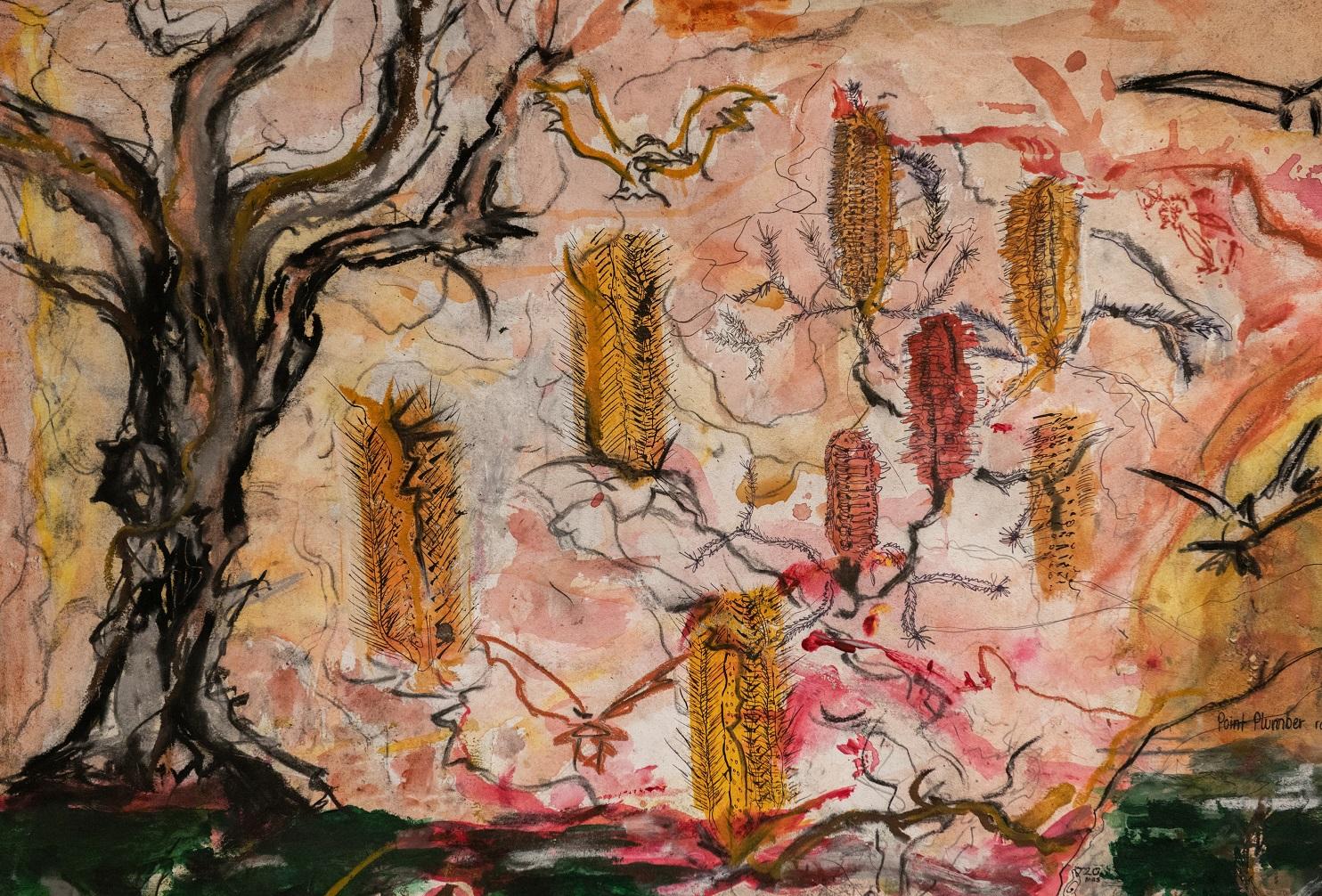
Surf Patrol: Manly In 1950
Surf Patrol shows the work of the volunteer life-savers who patrol Australia's dangerous surf beaches, saving hundreds of lives each year.
Australia's beaches, ringed as they are by dangerous surf, call for vigilance by even the best swimmers. The film stresses that these men and women, who devote their energies to this, give up much of their leisure to equip themselves for the task. As well as being expert swimmers and qualifying for swimming awards, they spend as many as two or three evenings a week studying life-saving methods and human physiology. How they man life-boats which fight huge seas, how with belt and line they brave heavy seas to rescue the unfortunate and unwary, and how they apply the most efficient methods of resuscitation to the apparently drowned, makes a highly exciting and interesting film. 1950; Directed by Jack S. Allan. Produced by National Film Board. Locations: Manly Beach and Surf Club
Pittwater High School: 60 Years Young In 2023
Did you know that Pittwater High School was officially opened on November 22nd 1963?
In 1963 Pittwater operated with 200 students and 20 staff out of one building built on flood land resumed in 1961 with Stage I costing; Pittwater High, new school, £279,644; Nearly £12 Million on Schools (1963, September 6). Western Herald (Bourke, NSW : 1887 - 1970), p. 13. Retrieved from http://nla.gov.au/nla.news-article142315720
Named after Pittwater, the estuary, the school has always had a good focus on aquatic sports and the arts, including launching some great musicians and the Diamond class yacht launched and built at the school through the work of Wal Wardle and Harold Vaughan, the Kalori, which also went on to become the name for the school magazine. Roughly translated it means 'message stick'.
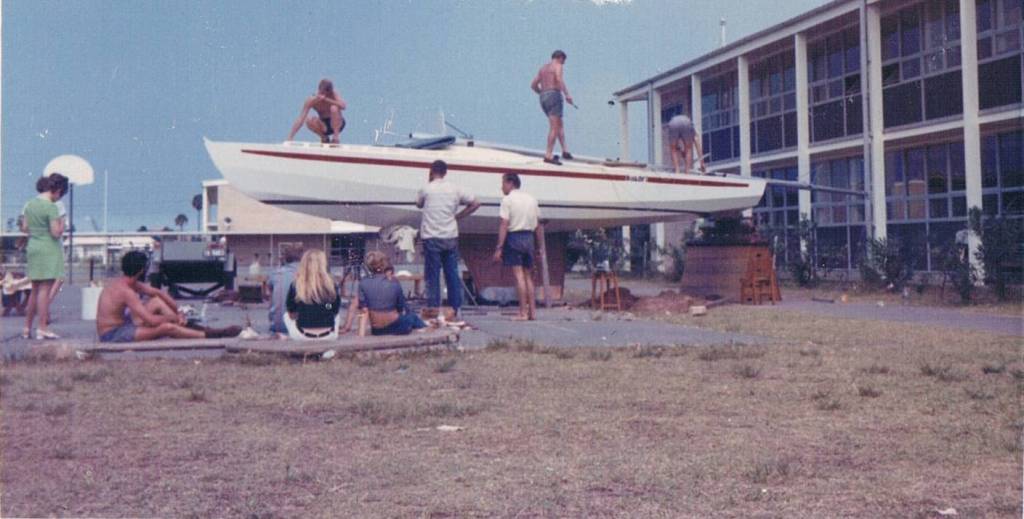
The Kalori being built in the school grounds
The school has also seen some of Australia's premier sailors as students go on to GREAT things - for example, this little insight from 1998:
Pittwater team to represent Australia Sailing
PITTWATER High School sailing team captain Ben Bianco praised the competitiveness shown by the other teams at last week's Secondary Schools Team Racing Championships on Boston Bay. The Pittwater team, representing New South Wales, staved off gallant efforts from Western Australia and South Australia to take out the prestigious title. Ben said the competition was good, with all teams putting up an excellent fight. South Australia was represented by the Port Lincoln High School team. The High School side has been very successful in the past, winning a number of titles. Team captain Tiffany Evans said this year's side showed lot of promise for the future. "They are a young team, and they are also the lightest team we have ever had," Miss Evans said. "When the conditions are rough like they were over the weekend then the heavier teams have an ! advantage. "I think we will be a force in the future." The Pittwater team will now represent; Australia at the interdominion against New Zealand team Keri Keri in September.
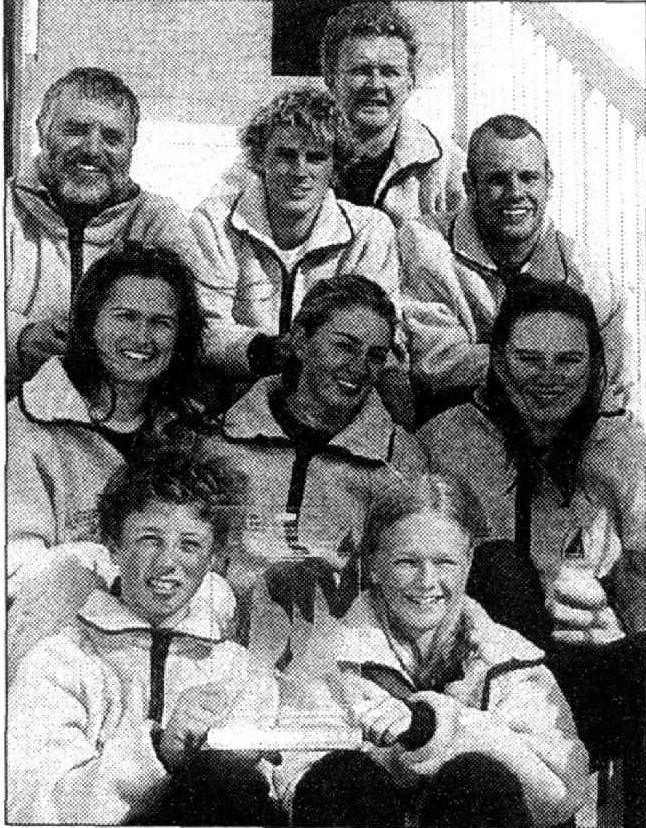
The victorious Pittwater High School team was made up of (back) Angus Gordon (coach), Ben Bianco (captain), Peter Mullholland (manager) Nick Garland (skipper), (middle) Nadine MacCaurin, Lauren Bianco, Katie Spithill, Murray Gordon and Emily MacCaurin. Pittwater team to represent Australia (1998, July 16). Port Lincoln Times (SA : 1927 - 1965; 1992 - 2002), p. 39. Retrieved from http://nla.gov.au/nla.news-article267204325
Land resumed Notice:
NOTIFICATION OF RESUMPTION OF LAND UNDER THE PUBLIC WORKS ACT, 1912, AS AMENDED
IT is hereby notified and declared by His Excellency the Governor, acting with the advice of the Executive Council, that so much of the land described in the Schedule hereto as is Crown land is hereby appropriated, and so much of the said land as is private property is hereby resumed, under the Public Works Act, 1912, as amended, for the following public purpose, namely a High School at MONA VALE, and that the said land is vested in the Minister for Education as Constructing Authority on behalf of Her Majesty the Queen.
Dated this twenty-fifth day of October, one thousand nine hundred and sixty-one.
E. W. WOODWARD, Governor. By His Excellency's Command,
ERN. WETHERELL, Minister for Education.
The Schedule
All that piece or parcel of land situate in the Shire of Warringah, parish of Narrabeen and county of Cumberland, being part of the land comprised in Real Property Application 20,799, part of the land firstly described in Deed Registered Book 733, No. 445, and part of the land described in Deed Registered Book 2,038, No. 592: Commencing at the intersection of the north-western side of Mona-street with the north-eastern side of Pitt water-road; and bounded thence on the south-west by the said north-eastern side of Pittwater-road bearing 324 degrees 5 minutes 264 feet 101 inches to the westernmost corner of the land comprised in Certificate of Title, volume 4,215, folio 27; on the north-west by part of the north-western boundary of that land bearing 30 degrees 38 minutes 30 seconds 164 feet; again, on the south-west by a line bearing 326 degrees 9 minutes 10 seconds 404 feet li inches to the north-western boundary of the land comprised in Certificate of Title, volume 4,360, folio 148; on the south-east by part of that boundary bearing 210 degrees 20 minutes 176 feet 4 inches to the said north-eastern side of Pittwater-road; again on the south-west by that side of that road bearing successively 330 degrees 36 minutes 40 seconds 96 feet, 334 degrees 57 minutes 40 seconds 96 feet 31 inches, 339 degrees 19 minutes 5 seconds 96 feet 31 inches, 343 degrees 40 minutes 30 seconds 96 feet 3£ inches and 348 degrees 1 minute 55 seconds 64 feet 101 inches to the northwestern boundary of the said land firstly described in Deed Registered Book 733, No. 445; again on the north-west by part of that boundary bearing 30 degrees 33 minutes 678 feet i inch to the northernmost corner of that land; on the northeast by the north-eastern boundary of that land bearing 143 degrees 57 minutes 380 feet 1 inch; again on the south-east by part of a south-eastern boundary of that land bearing 210 degrees 20 minutes 5 feet 8 inches to the northernmost corner of the said land comprised in Real Property Application 20,799; and again on the north-east and south-east by the north-eastern and south-eastern boundaries of that land bearing successively 143 degrees 58 minutes 15 seconds 659 feet 6£ inches, 220 degrees 29 minutes 2 feet 3 inches and 210 degrees 13 minutes 30 seconds 801 feet 7i inches to the point of commencement,—having an area of 15 acres 3 roods 5 1/2 perches or thereabouts, and said to be in the possession of Phyllis E. John and others. NOTIFICATION OF RESUMPTION OF LAND UNDER THE PUBLIC WORKS ACT, 1912, AS AMENDED (1961, November 10). Government Gazette of the State of New South Wales (Sydney, NSW : 1901 - 2001), p. 3588. Retrieved from http://nla.gov.au/nla.news-article220286558
More later this year!
Northern Composure Band Competition 2023
Due to the pandemic, Council have had the 20th anniversary on hold but pleased to say that the competition is open and running again.
Northern Composure is the largest and longest-running youth band competition in the area and offers musicians local exposure as well as invaluable stage experience. Bands compete in heats, semi finals and the grand final for a total prize pool of over $15,000.
Over the past 20 years we have had many success stories and now is your chance to join bands such as:
- Ocean Alley
- Lime Cordiale
- Dear Seattle
- What So Not
- The Rions
- Winston Surfshirt
- Crocodylus
And even a Triple J announcer plus a wide range of industry professionals
About the Competition
In 2023, the comp looks a little different.
All bands are invited to enter our heats which will be exclusively run online and voted on by your peers and community by registering below and uploading a video of one song of your choice. (if you are doing a cover, please make sure to credit the original band) We are counting on you to spread the word and get your friends, family, teachers voting for you!
The top 8-12 bands will move on through to our live semi finals with a winner from each moving on to the grand final held during National Youth Week. Not only that but we have raised the age range from 19 to 21 for all those musicians who may have missed out over the past two years.
Key dates
- Voting open for heats: Mon 13 Feb – Sun 26 Feb
- Band Briefing: Mon 6 March, Dee Why PCYC
- Semi 1: Sat 18 March Mona Vale Memorial Hall
- Semi 2: Sat 25 March, YOYOs, Frenchs Forest
- Grand Final: Fri 28 April, Dee Why PCYC
For more information contact Youth Development at youth@northernbeaches.nsw.gov.au or call 8495 5104
Stay in the loop and follow Northern Composure Unplugged on KALOF Facebook.
School Leavers Support
- Download or explore the SLIK here to help guide Your Career.
- School Leavers Information Kit (PDF 5.2MB).
- School Leavers Information Kit (DOCX 0.9MB).
- The SLIK has also been translated into additional languages.
- Download our information booklets if you are rural, regional and remote, Aboriginal or Torres Strait Islander, or living with disability.
- Support for Regional, Rural and Remote School Leavers (PDF 2MB).
- Support for Regional, Rural and Remote School Leavers (DOCX 0.9MB).
- Support for Aboriginal and/or Torres Strait Islander School Leavers (PDF 2MB).
- Support for Aboriginal and/or Torres Strait Islander School Leavers (DOCX 1.1MB).
- Support for School Leavers with Disability (PDF 2MB).
- Support for School Leavers with Disability (DOCX 0.9MB).
- Download the Parents and Guardian’s Guide for School Leavers, which summarises the resources and information available to help you explore all the education, training, and work options available to your young person.
School Leavers Information Service
- navigate the School Leavers Information Kit (SLIK),
- access and use the Your Career website and tools; and
- find relevant support services if needed.
Word Of The Week: Ponder
Verb
1. To wonder, think of deeply. 2. To consider (something) carefully and thoroughly. 3. (obsolete) To weigh.
From Middle English ponderen, from Old French ponderer (“to weigh, balance, ponder”) from Latin ponderare (“to weigh, ponder”), from pondus (“weight”), from pendere (“to weigh”)
From deadly jaws and enormous strength to mushroom farming, Ant-Man is only tapping into a portion of the real superpowers of ants
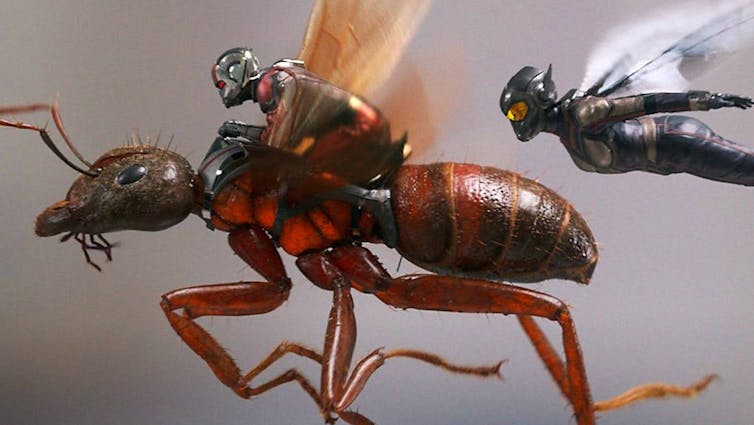
Ant-Man and The Wasp: Quantumania is the latest film in the ever-expanding Marvel Cinematic Universe.
The ant-filled film follows the adventures of Scott Lang (AKA Ant-Man), Hope Van Dyne (AKA The Wasp) and Cassie Lang (AKA The Stinger), who all use science-derived technology to give them ant-like powers. In the Ant-Man films, Ant-Man also has the ability to direct the actions of several ant species, each with its own unique set of characteristics.
Tiny ants might seem like unlikely inspirations and sidekicks for a superhero, but real-life ants have astonishing superpowers that make them formidable allies.
Super Strength
Ant-Man and The Wasp both wear suits that allow them to shrink and also give them the proportionate strength of an ant.
Ants are well known for their super-strength, with some workers being able to carry up to 50 times their own body weight. Since ants – like other insects – have their skeletons on the outside, their muscles do not have to support much of their body weight, leaving them free to apply more strength to lifting.
In addition, smaller animals tend to have greater strength relative to their body weight. Even ants’ joints are strong: the neck joints of the common field ant Formica exsectoides can withstand 5,000 times the ant’s body weight.
Super Speed
Ant-Man and The Wasp don’t have super speed – but real-life ants certainly do!
Saharan silver ants (Cataglyphis bombycina) can travel 100 times their body length in a second, making them one of the fastest animals on the planet. That’s like a 180-centimetre human running at 200 metres per second (or 720km per hour)! Usain Bolt, the all-time fastest person in the world, could only hit a maximum speed of 47km per hour.
Ants are not just fast runners – they can move other parts of their bodies with mind-boggling speed. Trap jaw ants (Odontomachus bauri) can slam their jaws shut at an incredible 137km per hour, one of the fastest movements in the animal kingdom. Trap jaw ants use their super-fast mandibles to catch their favourite prey: termites.
The jaws of trap jaw ants are also impressive defensive weapons and can be used to stun attacking predators such as spiders. These ants can even make a rapid retreat by striking their jaws against the ground. This “bouncer defence” throws the ant an astonishing 8cm into the air, the equivalent of an average-sized human jumping 40 metres.
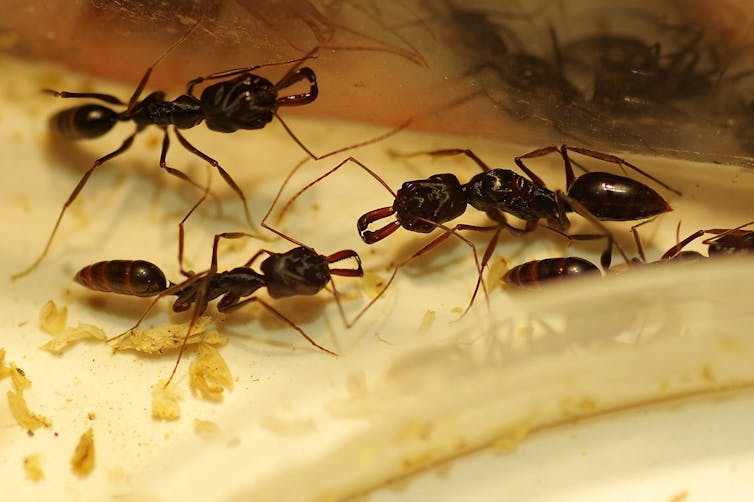
Strength In Numbers
What ants lack in size, they make up for in sheer numbers. A recent study estimated that there are more than 20 quadrillion ants alive at any one time – there are many more ants on Earth than stars in the Milky Way galaxy.
Argentine ants (Linepithema humile) build some of the largest supercolonies on Earth, containing billions of workers spread over 6,000 square kilometres.
By working together in overwhelming numbers, ants can successfully attack animals many times bigger than themselves. Army ant swarms can take down large prey such as lizards, frogs and even scorpions. Like the Ant-Man comic character Cassie Lang, some ant species possess a stinger capable of delivering painful venom. South American bullet ants (Paraponera clavata) have one of the world’s most painful stings. It’s no wonder they were featured as “attack ants” in the first Ant-Man movie.
No Leaders Necessary
Throughout the Ant-Man films, the heroes use communication devices to lead colonies of ants. However, there are no leaders in a real ant colony.
Worker ants are responsible for tasks such as hunting, cleaning and rearing larvae, while queens lay eggs to keep the colony stocked with workers. You might think a society containing millions of tiny-brained animals with no leader would be chaos, but by working together, ants can achieve feats that far exceed the brain power of any individual – this is called “swarm intelligence”.
Argentine ants, for example, can find the shortest path between nests, while fire ants escape flooding by linking their bodies together to form enormous living life rafts. In the First Ant-Man movie, Scott Lang uses the coordinated skills of fire ants to break into Pym Headquarters.
Super Sized Societies
In the latest movie, a colony of ants accidentally enters the mysterious quantum realm where they undergo 1,000 years of evolution, resulting in a society of highly intelligent ants living in a futuristic society.
But modern-day ants have already evolved exceptionally complex societies. Some ant species have even evolved forms of agriculture by tending to and protecting herds of sap-sucking aphids. Aphids respond to their ant farmers by producing droplets of a sugary substance called “honeydew” which the ants harvest as food.
Amazingly, leaf cutter ants in South America care for immense underground fungi gardens which they grow for food. The ants feed the fungus leaves and are able to select the leaf species that maximise fungal growth. Ants weed the garden by removing weedy fungi species, and can even use antibiotics to protect the fungi from disease.
Given their super strength, incredible speeds and amazing swarm intelligence, Ant-Man is lucky to have ants on his side!![]()
Tanya Latty, Associate professor, University of Sydney and Caitlyn Forster, Associate Lecturer, School of Life and Environmental Sciences, University of Sydney
This article is republished from The Conversation under a Creative Commons license. Read the original article.
The art of balding: a brief history of hairless men

Balding is really common, affecting more than 50% of men. It’s also physically inconsequential (bald men live just as long as haired men). So why, in his memoir Spare, does Prince Harry refer to his brother’s baldness as “alarming”?

As a social psychologist with a special interest in balding (and author of an upcoming book entitled Branding Baldness), I know this didn’t used to be the case – as the presence of balding men in art history demonstrates.
Historically, baldness was treated with neutrality, as a regular part of daily life. In 2019, Egyptology professor Samar Kamal found evidence of 122 bald men painted in private Ancient Egyptian tombs, circa 2613 to 525 BC.
Most of these men were visibly aged (their remaining hair was white). They were depicted in varied spheres of Egyptian society, from farming and fishing to sculpting and scribing.
The art suggests that the Ancient Egyptians didn’t treat bald men any differently from their haired peers.
Kamal also observed that the Ancient Egyptians had specific terms for male baldness, included a “baldness line” during mummification, and had different balding hairstyles (e.g. short all over or long at the back).
Balding Men In European Paintings
European art also showcases baldness’s historical ordinariness. Vincent van Gogh’s painting On The Threshold Of Eternity (1890) features the balding Dutch pensioner Adrianus Zuyderland.

While the painting evokes a sense of existential despair, Zuyderland’s baldness is an incidental – even attractive – feature of the artwork. Van Gogh described the painting in his letters, writing: “What a fine sight an old working man makes, in his patched bombazine suit with his bald head.”
Zuyderland is not an exception – there are many other bald men featured neutrally in historical art. For example, Dutch Golden Age painter Frans van Mieris the Younger’s Man With A Tankard (1793) depicts a bald man contentedly enjoying a pub lunch.
Balding men have also historically been idealised in art. For example, Italian Renaissance painter Paolo Veronese’s 16th-century The Eternal Father features a balding God performing an ethereal miracle.
Rembrandt’s Anatomy Lesson of Dr Nicolaes Tulp (circa 1632) shows multiple balding doctors studying dissection. Impressionist Pierre-August Renoir’s Portrait of Ambroise Vollard (1908) depicts the eponymous balding art collector.
And there is plenty of other historical evidence to challenge the claim that baldness is “alarming”.
Balding religious figures exist across almost every faith. There’s Buddha, the Christian saints Jerome and Augustine, and then there are bald deities including the Japanese gods Fukurokuju and Hotei.

Religious and political directives have also promoted baldness. This ranges from Christian monks’ tonsure, where hair was grown around a centrally shaved part of the scalp, to the Manchu “queue” haircuts, where hair at the back of the head was grown into a long plait while the rest of the head was shaved.
How Baldness Became ‘Alarming’: Advertising And Mass Media
The mass marketing of anti-baldness products in the 20th century changed how baldness was seen. It transformed the perception of baldness from a benign aesthetic to a disadvantageous disease in need of “cure”.
Such “cures” ranged from expensive and ineffective “snake oil” products to the regulatory approved formulations that have some (though limited) hair regrowth properties, such as minoxidil.
The advertising of these products fostered the idea that baldness is alarming. In 2013, sociolinguistics professor Kevin Harvey observed that online anti-baldness adverts characterise haired men as attractive, successful and happy.
In contrast, the same adverts promoted the claim that baldness was a disease that severely distressed and disadvantaged men. Adverts for anti-baldness shampoo Renaxil, for example, depicted hair follicles on the verge of suicide. Renaxil bottles are shown extending a hand to save them.
In contemporary mass media, baldness is rarely seen beyond the few actors (such as Jason Statham, Vin Diesel and Bruce Willis) who have made lack of hair their unique selling point. Research conducted in 2006 found that just 3% of 1,356 characters in US popular children’s TV shows were balding.
In a study I led of 5,000 images of men in popular magazines published between 2011 and 2012, we found that just 8% were balding.
There are also negative stereotypes in many contemporary depictions of baldness. The website TV Tropes indicates that bald TV and film characters tend to be villains or aged. Another study found that more than 60% of 1980s TV actors portrayed bald characters who were “ugly”, incompetent or lazy.
Alarm around baldness is even promoted in academic research. Myself and Dr Hannah Frith recently found that about 80% of baldness psychology studies had links to businesses. The studies tended to depict baldness as a disease (77%), and promoted anti-baldness products (60%) without meaningful discussion of their limitations (68%).
Baldness representation matters. Modern depictions in TV, advertising and research sanction the claims that hair loss is a disadvantage and a disease. But a look at the art history of the balding man shows this hasn’t always been the case. Bald men can be healthy, successful and content – just as much as their haired counterparts.![]()
Glen Jankowski, Senior Lecturer in the School of Social Sciences, Leeds Beckett University
This article is republished from The Conversation under a Creative Commons license. Read the original article.
‘Why would you go to uni?’ A new study looks at what young Australians do after school

This week, the federal government released a discussion paper for a Universities Accord, which it hopes will make a 30-year plan for the sector.
One of the key priorities of the upcoming accord is equal access to university. The discussion paper specifically asks:
what is needed to increase the number of people from under-represented groups applying to higher education?
Our new book, based on ten years of research, aims to look beyond narrow definitions around equity and access to university.
We argue these ignore more subtle inequalities that shape access to higher education, particularly those that play out at a local level.
Equity Targets In Higher Education
Thirty years ago, the Hawke government set national targets to increase university participation for First Nations Australians, people from low socio-economic backgrounds, people from regional and remote areas, people with disabilities and people from non-English-speaking backgrounds.
The goal was to make sure university students reflected Australian society and ensure Australians from all backgrounds could participate successfully in higher education.
As of 2021, there was a lower proportion of students from these groups enrolled in higher education compared with the proportion in the general population (with the exception of students with a disability). The discussion paper notes 17% of university students were from a low socioeconomic background, 2.4% were First Nations Australians, 21% were from regional or remote areas, and 9% were students with a disability.
As Education Minister Jason Clare told ABC Radio on Wednesday, when it comes to students from disadvantaged backgrounds, “we failed”.
Our New Book: Community Matters
Since 2012, we have conducted one of the largest studies to date of how young Australians form their ideas about their education and what they want to do after school. We gathered 10,000 survey responses and did 700 interviews with students in Years 3 to 12, as well as surveys and interviews with parents/carers, teachers and community members.

We published our findings in a new book, Community Matters, released this week.
The book examines seven communities and their relationships with higher education (the names of interviewees and their communities have been changed). These include a metropolitan suburb with a large culturally and linguistically diverse community, a small coastal town, a remote community and a regional centre.
Our aim is to shift the focus away from impersonal “equity target groups” to diverse suburbs, towns and areas across Australia. This shows how equitable access to higher education is shaped by the communities where young people grow up, live and develop a sense of their place in the world.
Aspirations Are High
Significantly, in all of the communities we looked at, young people want to go to university.
When we asked them about their aspirations for education, going to university was always the most popular choice among students as young as eight and as old as 18. This proportion ranged from 30% to 78% of students in the various communities.
These findings challenge the view that young people from socially disadvantaged backgrounds have “low” aspirations for their futures. What is important, however, is the broader context in which these aspirations play out.
Local Labour Markets Matter
In historically working-class communities and those in rural areas, we found local employment options matter. For some young people, the realities of their local area impacts on their ideas about their futures.
Kathleen is a teacher in Ironbark, a regional agricultural community currently experiencing relative prosperity associated with the wine industry:
My brother was offered a school-based traineeship as an electrician […] Now he’s earning more money than me […] Why would you go to uni when you can study here at TAFE, earn big money, especially during vintage season?
Community Norms Have An Impact
Many young people do not have any exposure to university study in their families or even more broadly in communities. Mel, a Year 6 student in Excelsa, a working-class urban community, told us:
Nobody I know in my family has gone to university or TAFE. My Aunty might have because she does computer work and she gets paid lots of money. Yeah, so she must have, like, studied it at university or something.
Zoey, a Year 7 student at a local high school in Excelsa, also told us how the aspirations of her peers at school are shaped by gendered norms within the community:
Probably most girls would probably be stay-at-home mums or might just work at KFC or McDonalds. And the boys might be working in surf shops.
The Broader Context Matters
We also found factors like drought, technology and globalisation had an impact of young people’s choices in some rural areas. Interviewees spoke about farms being sold and the local school dwindling in size.
These devastating effects translated into an awareness among young people of barriers they would face in even attempting to get to university. Year 12 student Lora is a young Indigenous woman living in the remote township of Olearia:
I used to say I’d want to go to uni, when I was younger. But, as I got older […] everything changed, and it just got too hard.
As Catherine, a parent, further explained:
Not many go through to Year 12, see? […] To do any of the bigger, better stuff you’ve got to have a lot of willpower because you don’t really get a teacher with it […] If you wanted to go on to university you sit there and do your own work, because you’re not with the other kids that are just doing Year 11 and 12.
Infrastructure Often Lags Behind
In communities where pursuing higher education is not the norm, we also found significant problems with infrastructure.
In one case, a satellite university campus had been established in a community but there was no viable way to get there on public transport. As Adam, a local community member, told us:
It’s as simple as in the absence of having a decent transport system that is more than a bus every two hours […] it’s really hard if you don’t have a car. […] Talent is everywhere, but opportunity isn’t.
Where To Next With Equity Policy?
Jason Clare has stated numerous times that he wants to improve access to university in Australia:
where you live, how much your parents earn, whether you are Indigenous or not, is still a major factor in whether you are a student or a graduate of an Australian university.
There is now a specific opportunity to focus on this in the upcoming Universities Accord, which talks about “widening opportunities” and “removing barriers”.
What our research shows, however, is that “removing barriers” is not about imploring more young people to choose university, nor is it about rectifying a lack of aspiration or ambition.
Our findings highlight the urgent need for policymakers to consider how universities can better meet the needs of diverse and changing communities. This includes much broader consideration of the role of university in society and how access can be better supported through alignment with local industries, improved infrastructure, and working directly with community members to understand their challenges and concerns.
The Australian higher education sector is now at a crucial juncture. If institutions are not going to better align themselves with their communities, the question might indeed become: why would you go to uni?
You can find out more about our research on young people’s education aspirations here.![]()
Sally Patfield, Senior Research Fellow, Teachers and Teaching Research Centre, University of Newcastle; Jenny Gore, Laureate Professor of Education, Director Teachers and Teaching Research Centre, University of Newcastle; Jess Harris, Associate Professor in Education, University of Newcastle, and Leanne Fray, Senior Research Fellow, University of Newcastle
This article is republished from The Conversation under a Creative Commons license. Read the original article.
Empires of ice: how Edmund Hillary’s Antarctic adventure 65 years ago helped loosen NZ’s colonial ties to Britain

When the Commonwealth Trans-Antarctic Expedition ended on March 2, 1958, it marked what many called the last great adventure possible on Earth: an overland crossing of the Antarctic continent.
Sixty-five years later, it’s remembered in New Zealand chiefly for Sir Edmund Hillary’s unplanned and controversial “dash” to the South Pole in a convoy of modified Massey Ferguson tractors.
But as a historian of Antarctic science, I believe the expedition tells us about more than just Kiwi ingenuity and attitude. It was also about national competition and prestige, disputed sovereignty, and competing versions of masculinity.
Perhaps most significantly, an exercise designed to showcase Commonwealth unity ended up demonstrating the opposite. And it helped cement New Zealand’s independent relationship with Antarctica, specifically the Ross Dependency and Scott Base, as quite separate from its ties to Britain.
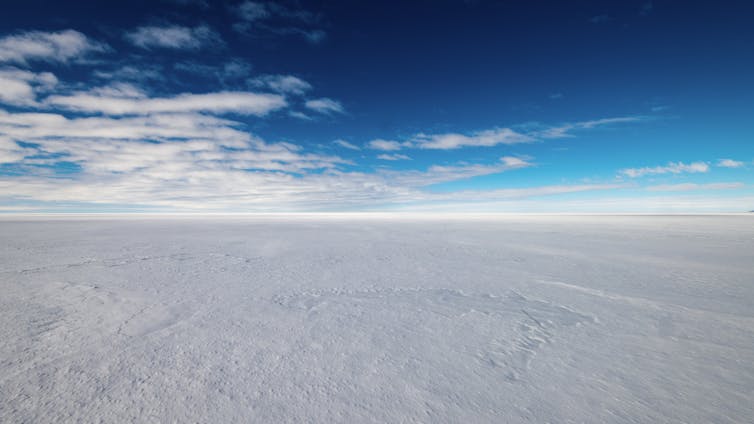
Science And Nationalism
The expedition’s origins go back to 1953, when Vivian Fuchs, a geologist with the Falkland Islands Dependency Survey, began circulating a proposal for the Commonwealth Trans-Antarctic Expedition (TAE). This would be the first overland crossing of the frozen continent.
Although Fuchs later stressed the scientific potential of his plan – which he said took initial shape as he sheltered from a blizzard, huddled in a tent on Antarctica’s Stonington Island – the proposal also had geopolitical motivations.
At the time, the United Kingdom’s claims in Antarctica were under increasing threat from Argentina and Chile. Even the American expedition to the Weddell Sea in 1947-48 did not acknowledge British sovereignty. In Fuchs’ words:
A trans-continental journey made wholly within territory claimed by the British Commonwealth […] would gain prestige and at the same time contribute to the solidarity of Commonwealth interests.
Fuchs tied the Trans-Antarctic Expedition to the scientific programme of the International Geophysical Year (IGY) of 1957-1958. This was an international collaborative scientific project that focused on gathering new observations on the oceans, weather systems, outer space and the poles.
Even though the expedition remained officially separate, it could be seen as supporting the IGY’s wide-ranging scientific research efforts. While Fuchs soon won the support of many in the Commonwealth polar and scientific communities, some derided what appeared to be a geopolitical exercise using the supposedly apolitical, science-focused IGY.
The Hillary Factor
For Fuchs to succeed in journeying from the Weddell Sea to the Ross Sea via the South Pole, his plan – like that of Ernest Shackleton’s ill-fated attempt 40 years earlier – depended on a supporting party from New Zealand.
Led by Edmund Hillary, an international celebrity since his 1953 ascent of Mt Everest, this party would lay depots of food and fuel to support the second part of Fuchs’ journey, from the South Pole to the Ross Sea.
Hillary’s expedition, intended to be largely privately funded, initially lacked widespread support from New Zealanders, many of whom believed their government should cover the entire cost.
But the Ross Sea Committee, which organised the expedition, worked to imbue the public with a sense that their country had a stake in the Antarctic territory they claimed: the New Zealand Antarctic Expedition, as it was often called domestically, would be a triumph for their nation.
At the head of a major public relations campaign, Hillary’s attachment to the expedition was a big factor in growing support for the expedition. In the end, New Zealanders donated more to the TAE per capita than the British public did. Nonetheless, the New Zealand government still had to heavily subsidise the enterprise.

To The Pole By Tractor
The newly established Scott Base was intended to serve the interests of both New Zealand’s IGY and TAE parties, and was placed under Hillary’s command. In fact, it was Hillary who selected, in a last-minute change, the base’s location on Ross Island, as it was more convenient for the TAE’s priority of travelling over the Polar Plateau.
This was to the chagrin of many scientists in both parties, including the IGY scientific leader Trevor Hatherton, who decried the site’s poor conditions for geologic, geomagnetic and seismic research.
Hillary began his depot-laying journey on October 14, 1957. To reduce costs and reflect New Zealand’s agricultural strengths, he travelled with three TE20 Massey Ferguson tractors, modified with a full tracking system for use in the snowy conditions. His team made good time and established Depot 700, the last one scheduled, in late December.
In the meantime, Fuchs’ team had encountered rough conditions and crossed the continent much more slowly than expected. Deviating from the expedition’s initial plans and disobeying orders from the Ross Sea Committee, Hillary continued to the South Pole and arrived at the US Amundsen-Scott South Pole Station on January 3, 1958, becoming the first to make this journey using overland vehicles.
Between 1992 and 2015, an image of a modified Massey Ferguson tractor graced the New Zealand $5 note, commemorating the achievement.
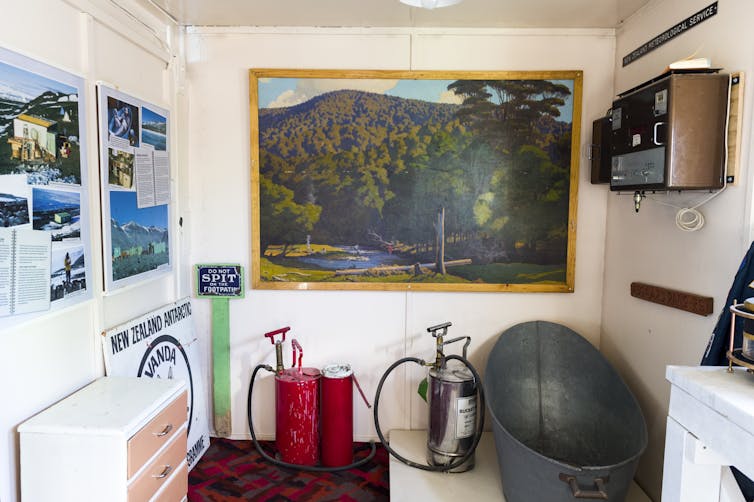
End Of Empire
Shortly after his arrival at the Pole, Hillary sent a message to Fuchs suggesting he abandon his plans for completing a crossing, given the difficult conditions. This telegram was accidentally released to the New Zealand press.
By the time Fuchs arrived at the Pole on January 19, a media firestorm had exploded. The expedition was now characterised as a “race to the Pole” by two national parties headed by the “adventurer” Hillary and the “scientist” Fuchs. Like the first race to the Pole between Roald Amundsen and Robert Falcon Scott in 1911-12, this one was framed as yet another loss by Britain.
The remainder of the expedition was an exercise in damage control, with the organising committees in New Zealand and the UK stressing there was indeed only one expedition, and there had been no race to the Pole. Fuchs’ party arrived, rather anticlimactically, at Scott Base on March 2, 1958, completing the historic 3,473 kilometre journey.
Yet the drama was still not over. Three years after Fuchs and Hillary’s official account of the expedition was published, Hillary published his own tell-all version which played up the masculinity and daring of the New Zealand party in opposition to the British.
What had begun as a show of Commonwealth unity with Britain at the head became an international incident, reinforcing perceptions of a fracturing British Empire. Hillary’s dash to the Pole was far more memorable than the actual crossing.
Moreover, it marked the beginning of modern New Zealand’s close identification with Antarctica and its own Scott Base, and the end of old colonial hierarchies on the ice. Indeed, by the end of the Trans-Antarctic Expedition, New Zealand’s biggest partner in Antarctic science was not the United Kingdom, but the United States.![]()
Daniella McCahey, Assistant Professor of History, Texas Tech University
This article is republished from The Conversation under a Creative Commons license. Read the original article.
Scientists just revealed the most detailed geological model of Earth’s past 100 million years

Earth’s surface is the “living skin” of our planet – it connects the physical, chemical, and biological systems. Over geological time, landscapes change as this surface evolves, regulating the carbon cycle and nutrient circulation as rivers carry sediment into the oceans.
All these interactions have far-reaching effects on ecosystems and biodiversity – the many living things inhabiting our planet.
As such, reconstructing how Earth’s landscapes have evolved over millions of years is a fundamental step towards understanding the changing shape of our planet, and the interaction of things like the climate and tectonics. It can also give us clues on the evolution of biodiversity.
Working with scientists in France (French National Centre for Scientific Research, ENS Paris university, University of Grenoble and University of Lyon), our team at the University of Sydney has now published a detailed geological model of Earth’s surface changes in the prestigious journal Science.
Ours is the first dynamic model – a computer simulation – of the past 100 million years at a high resolution down to ten kilometres. In unprecedented detail, it reveals how Earth’s surface has changed over time, and how that has affected the way sediment moves around and settles.
Broken into frames of a million years, our model is based on a framework that incorporates plate tectonic and climatic forces with surface processes such as earthquakes, weathering, changing rivers and more.
Three Years In The Making
The project started about three years ago when we began the development of a new global-scale landscape evolution model, capable of simulating millions of years of change. We also found ways to automatically add other information into our framework, such as palaeogeography – the history of Earth’s landscapes.
For this new study, our framework used state-of-the-art plate tectonic reconstructions and simulations of past climates on a global scale.
Our advanced computer simulations used Australia’s National Computational Infrastructure, running on hundreds of computer processors. Each simulation took several days, building a complete picture to reconstruct the past 100 million years of Earth’s surface evolution.
All this computing power has resulted in global high-resolution maps that show the highs and lows of Earth’s landscapes (elevation), as well as the flows of water and sediment.
All of these fit well with existing geological observations. For instance, we combined data from present-day river sediment and water flows, drainage basin areas, seismic surveys, and long-term local and global erosion trends.
Our main outputs are available as time-based global maps at five-million-year intervals from the Open Science Framework.
Water And Sediment Flux Through Space And Time
One of Earth’s fundamental surface processes is erosion, a slow process in which materials like soil and rock are worn and carried away by wind or water. This results in sediment flows.
Erosion plays an important role in Earth’s carbon cycle – the never-ending global circulation of one of life’s essential building blocks, carbon. Investigating the way sediment flows have changed through space and time is crucial for our understanding of how Earth’s climates have varied in the past.
We found that our model reproduces the key elements of Earth’s sediment transport, from catchment dynamics depicting river networks over time to the slow changes of large-scale sedimentary basins.
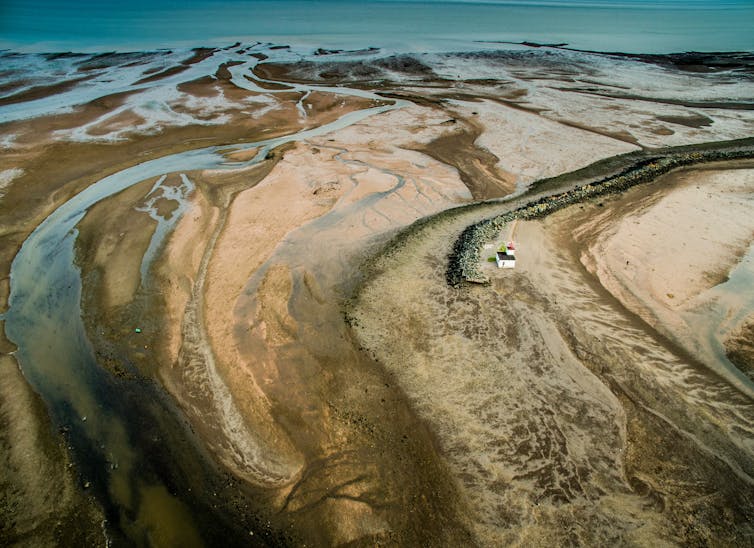
From our results, we also found several inconsistencies between existing observations of rock layers (strata), and predictions of such layers. This shows our model could be useful for testing and refining reconstructions of past landscapes.
Our simulated past landscapes are fully integrated with the various processes at play, especially the hydrological system – the movement of water – providing a more robust and detailed view of Earth’s surface.
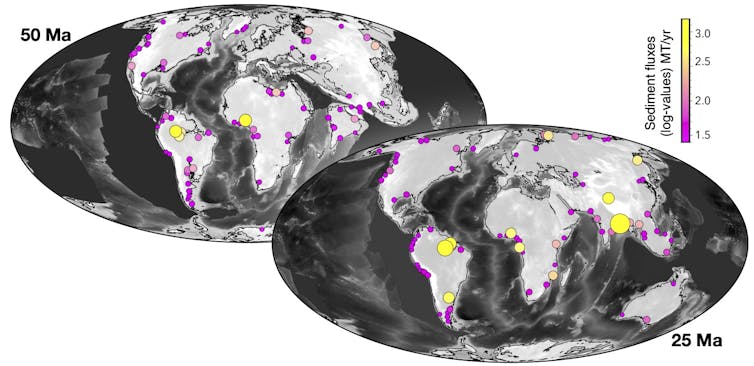
Our study reveals more detail on the role that the constantly evolving Earth’s surface has played in the movement of sediments from mountaintops to ocean basins, ultimately regulating the carbon cycle and Earth’s climate fluctuations through deep time.
As we explore these results in tandem with the geological record, we will be able to answer long-standing questions about various crucial features of the Earth system – including the way our planet cycles nutrients, and has given rise to life as we know it.![]()
Tristan Salles, Senior Lecturer, University of Sydney
This article is republished from The Conversation under a Creative Commons license. Read the original article.
Extinct elephant birds were 3 metres tall and weighed 700kg. Now, DNA from fossil eggshells reveals how they lived

Madagascar’s extinct elephant birds – the largest birds ever to have lived – have captured public interest for hundreds of years. Little is known about them due to large gaps in the skeletal fossil record.
A new study published today in Nature Communications used ancient molecules extracted from fossil eggshells to reveal surprising new insights into the biology of these flightless giants. How many species were there? Where did they live? What did they eat?
Answers to these questions contribute to our understanding of the origin and loss of species, which is especially important today as global biodiversity continues to rapidly decline.
Staggeringly Large Birds
As a biodiversity hotspot, the island nation of Madagascar is a natural test tube for studying evolution and extinction. The numerous species of now-extinct megafauna that once roamed there play a key role in furthering our understanding of these processes.
One such group were the elephant birds, about which precious little has been gleaned since they were first described over 150 years ago.

Alongside Africa’s ostrich, Australia’s emu and cassowary, South America’s rhea, and New Zealand’s moa and kiwi, the elephant birds of Madagascar (or vorompatra in Malagasy language) were large, flightless ratites. They became extinct around 1,000 years ago, soon after humans first settled Madagascar.
These were truly enormous birds, with some weighing over 700kg and standing up to 3m tall. Their eggs, weighing 10kg, were 150 times the size of a chicken’s egg.
Elephant birds (Aepyornithiformes) have been the stuff of legends for hundreds of years, with early sightings possibly being the origin of the mythical creature, roc (or rukh), and inspiring writers such as H. G. Wells. British naturalist David Attenborough also took a special interest in elephant birds, documenting his journey for answers about his own elephant bird egg in Attenborough and the Giant Egg.
In recent years, elephant birds were found to be most closely related to the chicken-sized kiwi bird – a result that changed our view of avian evolution.

A Patchy Record
Yet there is still debate about how many species of elephant bird there actually were. At one time, 16 species were named based on differences found between skeletal fossils. In the 1960s, this dropped to seven species, and the most recent revision classified elephant birds into four species. But why the controversy?
Although these birds became extinct relatively recently, the skeletal fossil record through time and space is patchy. Madagascar’s climate can be very hot and humid, which is not conducive to preserving biological material.
When bones are incomplete or fragmented, it can be hard to tell apart different species – and sometimes, bone doesn’t preserve at all, like in the far north of Madagascar where there have been reports of eggshells but no bones.
Modern DNA technology can help overcome this barrier. In a similar way that we can identify people, or tell how they are related to each other by comparing their DNA, ancient DNA from fossils can help identify unknown specimens or uncover relationships within and between species.
The more differences there are between two organisms’ DNA, the more distantly they are related. These differences can then be used estimate when species evolved, which provides clues about how and why. But, just like the elephant bird bones themselves, the DNA within them is not well preserved either.

Thick And Abundant Eggshell
This is where eggshell comes in. Compared to other birds, elephant bird eggshell is very thick, so the DNA trapped inside is better protected. Eggshells are also much more abundant than bones, with fragments densely scattered across beaches along Madagascar’s coastline, where these birds presumably once nested.
On top of preserving DNA and proteins, eggshell preserves “stable isotope” signatures which can be matched to those of plants and animals from the environment to get an idea of what the birds were eating and drinking.
Physical characteristics of eggshell (such as thickness and pore density) can also reveal information about egg size, bird size, the nesting environment, nesting behaviour, and can sometimes be used to distinguish between bird groups.
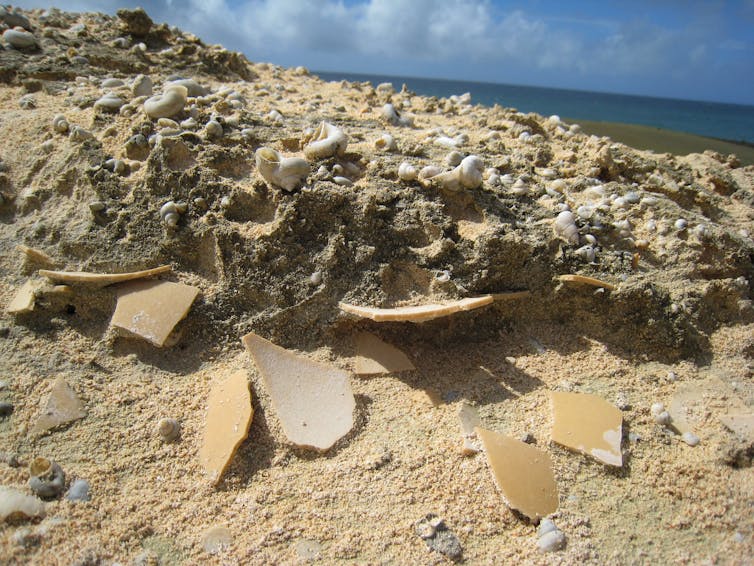
With the help and support of Malagasy locals, our team collected hundreds of 1,000-year-old fossil eggshell from across Madagascar. We looked at their thickness, their micro-structure (through micro-CT scanning), DNA and proteins, and their stable isotopes. We screened hundreds of eggshell fragments to find 21 with sufficient DNA to reconstruct a family tree using eggshell and bone specimens of known identity.
A Mysterious Lineage
We found there were not as many species of elephant bird as previously thought – there was very little genetic difference between specimens. We think some of the size and shape differences seen in the skeletal fossils are just differences between males and females, and not differences between species. It is common among ratites for females to be much larger than males – and to be mistaken for different species.
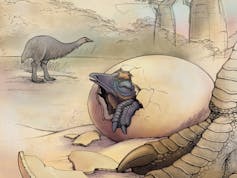
But more surprisingly, we identified a mystery eggshell from Madagascar’s far north as belonging to a novel lineage of large elephant birds that weighed 230kg and laid 3kg eggs. Although these birds were closely related to the elephant birds of central Madagascar, they were genetically distinct and had a different diet. They were also separated by about 1,000km in distance and 1.5km in elevation.
This proves that elephant birds were living in Madagascar’s far north where no skeletons have ever been found, a result that is reminiscent of the finding of a new hominid from DNA analysis of an unknown fossil.
These weren’t the only unexpected findings: we also identified potential drivers of speciation (formation of new species) and extreme gigantism in elephant birds. As Madagascar became drier and cooler during the last ice age, the vegetation changed, and elephant birds may have adapted to new niches. This led to the evolution of the largest species in a rapid and recent time frame – within the last 1.4 million years, a fraction of their evolutionary history.
These findings demonstrate how ancient DNA from eggshell is a promising avenue for studying the evolution of extinct birds. It contributes to our understanding of Madagascar’s past biodiversity – an important step towards understanding how to conserve its unique species into the future.![]()
Alicia Grealy, Research Projects Officer, CSIRO
This article is republished from The Conversation under a Creative Commons license. Read the original article.
Exercise is even more effective than counselling or medication for depression. But how much do you need?

The world is currently grappling with a mental health crisis, with millions of people reporting depression, anxiety, and other mental health conditions. According to recent estimates, nearly half of all Australians will experience a mental health disorder at some point in their lifetime.
Mental health disorders come at great cost to both the individual and society, with depression and anxiety being among the leading causes of health-related disease burden. The COVID pandemic is exacerbating the situation, with a significant rise in rates of psychological distress affecting one third of people.
While traditional treatments such as therapy and medication can be effective, our new research highlights the importance of exercise in managing these conditions.
Our recent study published in the British Journal of Sports Medicine reviewed more than 1,000 research trials examining the effects of physical activity on depression, anxiety, and psychological distress. It showed exercise is an effective way to treat mental health issues – and can be even more effective than medication or counselling.
Harder, Faster, Stronger
We reviewed 97 review papers, which involved 1,039 trials and 128,119 participants. We found doing 150 minutes each week of various types of physical activity (such as brisk walking, lifting weights and yoga) significantly reduces depression, anxiety, and psychological distress, compared to usual care (such as medications).
The largest improvements (as self-reported by the participants) were seen in people with depression, HIV, kidney disease, in pregnant and postpartum women, and in healthy individuals, though clear benefits were seen for all populations.
We found the higher the intensity of exercise, the more beneficial it is. For example, walking at a brisk pace, instead of walking at usual pace. And exercising for six to 12 weeks has the greatest benefits, rather than shorter periods. Longer-term exercise is important for maintaining mental health improvements.
How Much More Effective?
When comparing the size of the benefits of exercise to other common treatments for mental health conditions from previous systematic reviews, our findings suggest exercise is around 1.5 times more effective than either medication or cognitive behaviour therapy.
Furthermore, exercise has additional benefits compared to medications, such as reduced cost, fewer side effects and offering bonus gains for physical health, such as healthier body weight, improved cardiovascular and bone health, and cognitive benefits.
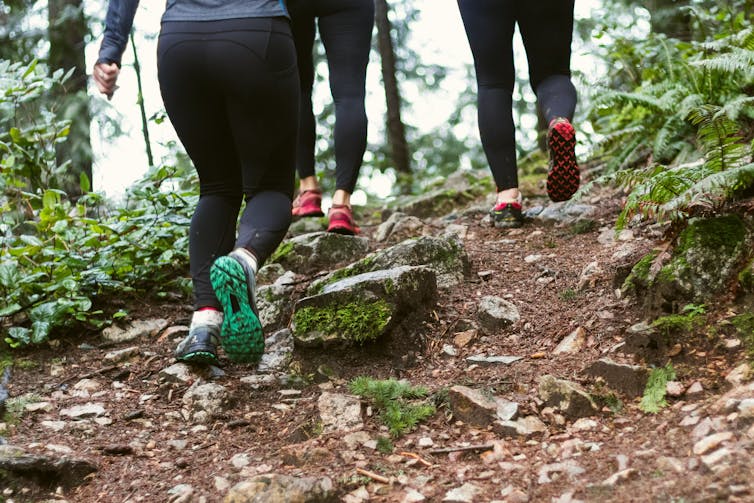
Why It Works
Exercise is believed to impact mental health through multiple pathways, and with short and long-term effects. Immediately after exercise, endorphins and dopamine are released in the brain.
In the short term, this helps boost mood and buffer stress. Long term, the release of neurotransmitters in response to exercise promotes changes in the brain that help with mood and cognition, decrease inflammation, and boost immune function, which all influence our brain function and mental health.
Regular exercise can lead to improved sleep, which plays a critical role in depression and anxiety. It also has psychological benefits, such as increased self-esteem and a sense of accomplishment, all of which are beneficial for people struggling with depression.
Not Such An ‘Alternative’ Treatment
The findings underscore the crucial role of exercise for managing depression, anxiety and psychological distress.
Some clinical guidelines already acknowledge the role of exercise – for example, the Australian and New Zealand Clinical Guidelines, suggest medication, psychotherapy and lifestyle changes such as exercise.
However, other leading bodies, such as the American Psychological Association Clinical Practice Guidelines, emphasise medication and psychotherapy alone, and list exercise as an “alternative” treatment – in the same category as treatments such as acupuncture. While the label “alternative” can mean many things when it comes to treatment, it tends to suggest it sits outside conventional medicine, or does not have a clear evidence base. Neither of these things are true in the case of exercise for mental health.
Even in Australia, medication and psychotherapy tend to be more commonly prescribed than exercise. This may be because exercise is hard to prescribe and monitor in clinical settings. And patients may be resistant because they feel low in energy or motivation.
But Don’t ‘Go It Alone’
It is important to note that while exercise can be an effective tool for managing mental health conditions, people with a mental health condition should work with a health professional to develop a comprehensive treatment plan – rather than going it alone with a new exercise regime.
A treatment plan may include a combination of lifestyle approaches, such as exercising regularly, eating a balanced diet, and socialising, alongside treatments such as psychotherapy and medication.
But exercise shouldn’t be viewed as a “nice to have” option. It is a powerful and accessible tool for managing mental health conditions – and the best part is, it’s free and comes with plenty of additional health benefits.![]()
Ben Singh, Research fellow, University of South Australia; Carol Maher, Professor, Medical Research Future Fund Emerging Leader, University of South Australia, and Jacinta Brinsley, Postdoctoral research fellow, University of South Australia
This article is republished from The Conversation under a Creative Commons license. Read the original article.
Applications Now Open For Inaugural $10,000 Military History Prize
COTA Australia Welcomes Super Clarity; Calls For Retirement Income Certainty
Older women are doing remarkable things – it’s time for the putdowns to end

It’s not easy to claim being an old woman. To start with, how can I be 75 when I feel about 40? And isn’t it shameful to be old when youth is valued? People proudly parrot statements such as, “I’m growing older but not getting old” (meaning, “How terrible to be old!”). I even heard that line quoted approvingly by one of the middle-aged hosts of the recent Australia Day Award ceremony.
Then there are shop assistants who serve an old person by asking, “What can I do for you, young lady/man?” (i.e. “I see that you’re old and will mock it by calling you young”). When author Jane Caro wrote about her husband’s angry response to this example of ageism it created quite a Twitter storm. Can’t you take a joke? But, as Caro replied, “Benign ageism, hostile ageism. One often turns into the other and both make the recipients feel diminished”.
Benign ageism applies as much to the stereotyping of young people (wasting their money on smashed avocado), as it does to the old.
Ageism is bad enough, but it’s often compounded by sexism. It is humiliating for a boy to be told he’s playing like a girl but even worse for a man expressing doubts or concerns to be called an old woman. The stereotype of the old woman is anxious, dependent, useless, and a burden – if she isn’t a nasty, bitter old witch. Dismissing old women in this way renders them invisible because they are considered of no use to society.
Women experience a sense of invisibility from late middle age: being overlooked in shops, ignored in restaurants. People walk into me in the street as though I’m incorporeal. Of course, it can be liberating to be ignored, not to be constantly assessed for one’s looks as young women are, and I try to make as much lemonade as possible from life’s lemons. Nevertheless, I’d prefer not to be completely disregarded.
When Jane Fisher and I interviewed Baby Boom women (born 1946 to 1964), we found that they wanted to be treated with respect, which doesn’t seem like much to ask. They said that respect includes requiring we all challenge – and refuse to perpetuate – these harmful stereotypes.
Ageist stereotypes reinforce age-based discrimination. An Australian survey of more than 2000 people aged over 60 found experiences of ageism have an adverse effect on mental health, prompting depression and anxiety.
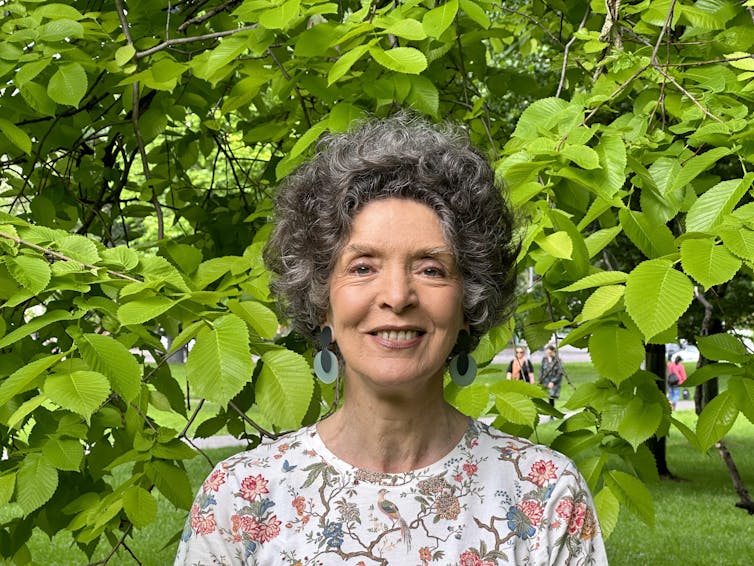
Challenging Stereotypes
My recent interviews with women from the previous generation, dolefully named the Silent Generation (born before 1946), challenge these stereotypes. In their late seventies, eighties, and nineties, these women are leading fulfilling lives; contributing to their communities and to the wider society.
There is Mig Dann, whose PhD was conferred in her early eighties. Her thesis explored memory and trauma through art theory and practice. Exhibitions of her work are breathtaking.
Olive Trevor OAM developed her love of plants as her five children grew up and, in her eighties, was recognised as a world expert in bromeliads.
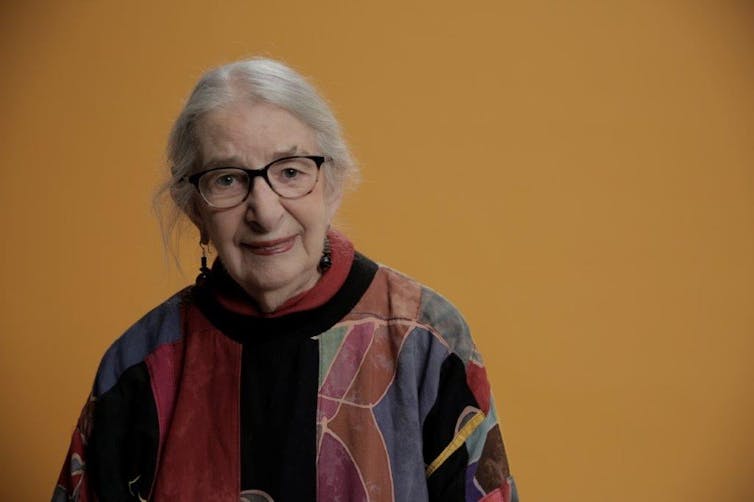
Lester Jones runs an educational coaching business, specialising in people with learning difficulties. She is in her nineties.
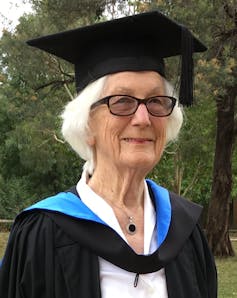
Jacqueline Dwyer was ANU’s oldest successful postgraduate student when she became a Master of Arts at 90; a book about her research was published when she was 92.
After a difficult young adulthood as an itinerant worker, Raylee George found her vocation in typesetting. When she was made redundant, an employer who values older people took George on in her seventies as a specialist call-centre operator.
As she approaches 80, environmental scientist and climate campaigner Dr Sharron Pfueller continues to set an example of how we should all be living sustainably.
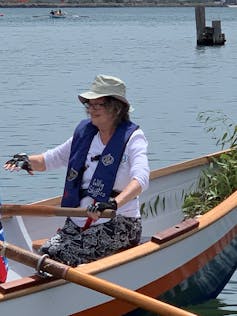
After working as a TV make-up artist and in managerial roles, as well as doing voluntary work, Robina Rogan at 76 joined a team that built a boat and rowed it around Port Phillip Bay. In her eighties, she’s still rowing.
Dr Miriam Rose Ungunmerr Baumann AM was Senior Australian of the Year in 2021; her life is committed to supporting Indigenous youth and to maintaining bridges that unite Indigenous and non-Indigenous cultures and people. These are just a few examples.
It was Ungunmerr Baumann who led me to ponder the contrast between the way in which so many of us (appropriately) pay our respects to First Nations Elders past and present while disrespecting old people in general. As she says to audiences of people in late adulthood, “You are all Elders”.
The life stories of these women reveal they endured hardship and grief while displaying resilience and determination. But personal qualities can’t fully account for lives that continue to have meaning. It isn’t enough to tell women to exercise, eat more vegetables, do lots of puzzles, and volunteer at the local op shop. We live in communities and societies in which we are all interdependent.
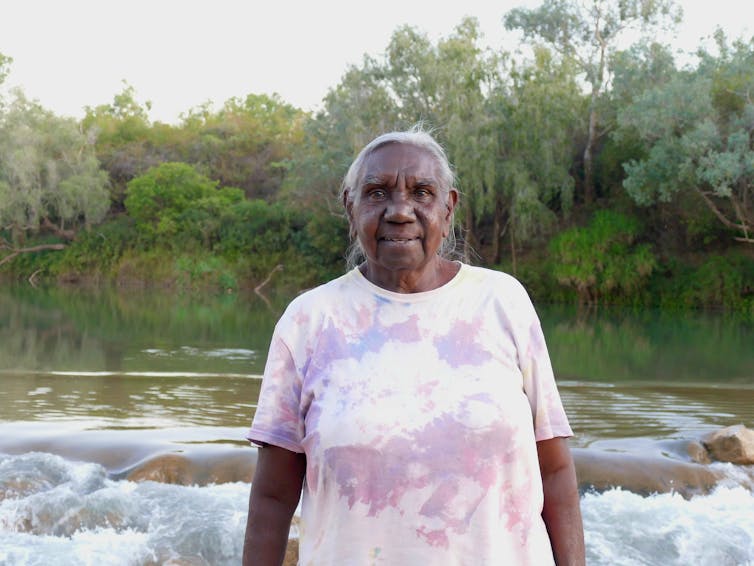
The Baby Boom women demonstrated that their whole life course influenced their experience of ageing, including their mental health. Were they adequately parented? Disadvantaged? Victims of violence? Well nourished in body and mind? Did they have good health? And, crucially, were there people, policies, and a culture that valued and supported them?
A Social Responsibility
Women may have qualities that help them to live productive and satisfying lives, but they can achieve their potential only in a milieu that enables, rather than inhibits, them.
The milieu includes other people (family, friends, workmates, the community), the built environment and social policies. Ageing well is a social responsibility, to be shouldered by everyone – not only because it is the right thing to do but because we all stand to benefit.
Preparations for old age begin with care and support for parents and infants and even with preconception healthcare: anything that contributes to physical and mental health and to parents’ capacity to nurture children. It includes financial support, adequate housing, early identification and treatment of postnatal depression, good childcare and high-quality education for all.
Anti-discriminatory policies, informed and inclusive healthcare, and social structures that support and enhance the lives of girls and women – as well as boys and men – will benefit everyone, not only older women.
The United Nations has declared the years 2021 to 2030 to be the Decade of Healthy Ageing: a time for worldwide collaboration to promote longer and healthier lives. Physical health is emphasised not as an end but as a necessary condition for full participation in society. This endeavour is part of a magnificent movement towards creating age-friendly neighbourhoods. The World Health Organization has taken the lead through its age-friendly cities framework.

The eight areas in the framework are community and healthcare, transportation, housing, social participation, outdoor spaces and buildings, respect and social inclusion, and civic participation and employment. These areas are interconnected. They encompass the physical, psychological and social components of life, all of which are implicated in ageing. We need to develop and maintain a world in which everyone, of any age, feels welcome and is encouraged to participate.
Socially constructed ideas of ageing can similarly be socially dismantled.
I’m proud to be old, but my age is not what I want you to see first, especially when “old” means useless, past it, of no interest to anyone else. A woman of 25 might have firm flesh and a future full of possibilities, but she doesn’t have all the decades of life experience embodied by a wrinkly woman of 75.
I’d like people to be interested in old women’s stories, to be prepared to learn about their lives: not only their past, but what they’re doing now, what they plan to do in the time to come.
This isn’t a whinge. I enjoy getting old. I love birthdays and cake. But I would like old age to be valued. It seems perverse for those who are not yet old to condemn their own futures.
Maggie Kirkman’s book Time of Our Lives: Celebrating Older Women is out on 1 March.![]()
Maggie Kirkman, Senior Research Fellow, Global and Women's Health, School of Public Health and Preventive Medicine, Monash University
This article is republished from The Conversation under a Creative Commons license. Read the original article.
Tax-free super for the super rich is a bad deal for the rest of us – and Morrison said it first

You’d be forgiven for thinking Treasurer Jim Chalmers had done something dramatic.
From 2025 he will double the tax rate on earnings from superannuation balances above A$3 million, lifting it from 15% to 30%.
Only 80,000 Australians have accounts that large, and many of them who have retired have shoved the maximum permissible $1.7 million into a separate so-called retirement account whose earnings are entirely tax-free.
That’s right. Retirees with $1.7 million in retirement accounts pay nothing whatsoever on what those accounts earn, which in normal years amounts to $85,000.
By way of comparison, wage earners on $85,000 get taxed $18,000.
But though you’d never know it from some of the “socialist tax grab” commentary around this week, Chalmers isn’t the first treasurer to act on this rort. Scott Morrison got there first.
Howard’s Super Deal For The Richest 1%
In 2006, in what economist Saul Eslake describes as one of the worst taxation decisions in modern times (an honour for which he says there’s a fair bit of competition), then Prime Minister John Howard exempted from tax withdrawals from super for Australians aged 60 and over.
By itself, this was unremarkable. We don’t tax withdrawals from bank accounts, because the interest they earn has been taxed within the account.
But Howard left in place a preexisting exemption from tax for earnings within the retirement accounts of Australians aged 60 and over.
This meant the earnings on the sometimes very large accounts of retirees aged 65 and over weren’t taxed at all. Not at the normal super tax rate of 15%, not at any rate – without limit, no matter how much was earned, merely because the person owning the account was aged 65 or over and had retired.
Morrison Wound Howard’s Policy Back
In office, the Labor governments of Kevin Rudd and Julia Gillard didn’t touch the open-ended opportunity to earn unlimited amounts from super tax-free. Instead, we had to wait a decade, until Prime Minister Malcolm Turnbull and his Treasurer Scott Morrison wound it back in 2016.
Facing off against critics in his own party, Morrison cut the amount that could be transferred from an ordinary super account into a tax-free “retirement” super account to $1.6 million, a ceiling that is adjusted every few years with inflation.
“If you’ve got more than $1.6 million in a superannuation account, you’re in the top 1% and you’ve worked hard to get there, that’s fabulous,” Morrison said at the time. “But that $1.6 million is the limit.”
The Seeds Of Chalmers’ New Plan
They were words echoed by Chalmers on Tuesday, who said his change would only affect half of the top 1%. If people had done well, that was “a good thing”.
But Chalmers said the system should be fairer.
And I think for any objective observer, the idea that ordinary working people subsidise incredibly generous tax breaks for people with millions and millions of dollars in superannuation doesn’t stack up.
Chalmers did more than channel Morrison’s language. The idea of a 30% super tax rate isn’t new.
Most Australians pay 15% on contributions, but in 2016 then treasurer Morrison expanded a 30% contributions rate from Australians with combined incomes and super contributions exceeding $300,000 to Australians with incomes and contributions exceeding $250,000.
And Chalmers received encouragement from another source.

In last year’s pre-budget submission, the Association of Superannuation Funds (ASFA) pointed the new treasurer to 11,000 super accounts holding more than $5 million, some of them holding hundreds of millions, “well in excess of retirement needs”.
The peak body for super funds called on the then Morrison government to end super tax concessions when accounts grew to $5 million, an amount it said could not “reasonably be justified as necessary to support a comfortable lifestyle in retirement”.
On Tuesday Chalmers picked up the idea – an idea that came from the super industry itself – but made the limit $3 million, instead of $5 million.
As ASFA proposed, that ceiling won’t climb over time with inflation, meaning over time more and more Australians will be taxed at 30%.
You Don’t Need Millions For A Comfortable Retirement
There are two points worth noting. One is that the quoted tax rate of 30% won’t work out at 30%. The best guess within the industry is that few pay anything like 15%. They are able to use concessions on capital gains and dividend imputation to drive down the tax actually paid to something nearer 7%.
The other is most Australians don’t need anything like what $3 million would buy in retirement – or even the $1.7 million they are allowed to use tax-free.
The ASFA retirement income standard has a “comfortable” retirement costing $48,266 per year (or $68,014 for a couple).
ASFA defines comfortable to mean $90 per month on broadband, $80 in alcohol, $46 in Netflix-like services, $258 dining out, top-flight private health insurance, and one domestic flight per year and an international flight every seven years.
It’s a level of largess not bestowed on many of us while working. If it was felt necessary in retirement (and doubtless many wealthy retirees do feel it is necessary) there’s no reason to expect them to get it all from super.
The government’s 2020 retirement income review found high-income Australians earned as much again from investment income outside super as they made from withdrawals from it. They do alright.
Scott Morrison, much criticised for the generosity to high income earners of his Stage 3 tax cuts, moved in the right direction on super. Jim Chalmers is picking up where he left off.![]()
Peter Martin, Visiting Fellow, Crawford School of Public Policy, Australian National University
This article is republished from The Conversation under a Creative Commons license. Read the original article.
Minister For Aged Care - Op-Ed
- Creating the Star Ratings system to increase choice, accountability and transparency. Implementing the inaugural code of conduct for providers and workers to protect older people.
- Capping homecare charges and exit fees to stop the rorting.
- Appointing an interim inspector general to be an independent champion for the sector. Enhancing safeguards for restrictive practices.
- Passing two aged care Acts through Parliament to keep reform moving
Get Boostered! No Room For COVID Complacency As Winter Wave Threatens
Banks Looking To Dump The Cheque Book
- From June 2023, we’re making changes to the way our customers order cheques.
- Some new accounts will no longer have access to a chequebook facility.
- Existing accounts will no longer have replacement cheque books issued automatically.
- Cheque Account Bearing Interest
- Society Cheque Account
- Department of Finance Account
- All Statutory Trust Accounts
- AUD Nostro Account
The Dark Side of the Moon at 50: how Marx, trauma and compassion all influenced Pink Floyd’s masterpiece

Dixi et salvavi animam meam.
This Latin phrase – I have spoken and saved my soul – sits at the end of Karl Marx’s Critique of the Gotha Programme.
Written in 1875, this text imagines a communist society that will come about “after the enslaving of the individual to the division of labour, and thereby also the antithesis between mental and physical labour has vanished”.
Only then, Marx argues, “can the narrow horizon of bourgeois right be completely transcended and society inscribe on its banners: from each according to his abilities, to each according to his needs!”
Roger Waters – bassist, lyricist and conceptual mastermind behind Pink Floyd’s 1973 album The Dark Side of the Moon, released 50 years ago today – knows Marx’s Critique. Indeed, he quotes it when discussing the record with music journalist John Harris.
“Making The Dark Side of the Moon, we were all trying to do as much as we possibly could,” Waters told Harris.
It was a very communal thing. What’s that old Marxist maxim? ‘From each according to his ability, to each according to his need.’ That’s sort of the way the band worked at that point.
Assertions about solidarity, cooperation and shared “unity of purpose” – as Waters says – situate Dark Side in the context of Pink Floyd’s notoriously fractious recording career and helps us understand the album’s enduring appeal.
Shine On You Crazy Diamond
Pink Floyd formed in London in 1965. Led by the charismatic songwriter, guitarist and lead vocalist Syd Barrett, the group established itself as a leader in the London underground music scene. They released their debut album The Piper at the Gates of Dawn in 1967.
Soft Machine member Kevin Ayers described The Piper at the Gates of Dawn as “something magical, but it was in Syd Barrett”.
Not long after the record’s release, Barrett suffered a catastrophic, LSD-induced breakdown. In response, the band recruited David Gilmour on guitar and recorded a second album, A Saucerful of Secrets, as a five-piece in 1968. Around this time, the increasingly unstable Barrett was unceremoniously ousted by the rest of the band.
After Barrett left, says Ayers, “Pink Floyd became something else totally”.
There are different versions of Pink Floyd. The recordings released after Barrett left the band in 1968 bear little resemblance to the first.
Dark Side sounds nothing like the whimsical Piper. But it is obvious the record is in large part preoccupied with the loss of Barrett.
This preoccupation comes to the fore in the album’s penultimate track.
Brain Damage, written and sung by Waters, references Barrett’s adolescence (“Remembering games and daisy chains and laughs”), alludes to his illness (“And if the dam breaks open many years too soon”), and acknowledges his leaving the group (“And if the band you’re in starts playing different tunes; I’ll see you on the dark side of the Moon”).
Drummer Nick Mason confirms the group didn’t want to lose Barrett.
In his autobiography, he writes:
He was our songwriter, singer, guitarist, and – although you might not have known from our less than sympathetic treatment of him – he was our friend.
If The Dam Breaks Open Many Years Too Soon
What we hear on The Dark Side of the Moon is a band dealing with trauma.
In this sense, Dark Side represents the start of a reckoning with the past – a process that culminated with the band’s next record, 1975’s elegiac Wish You Were Here.
Culmination is a useful term when it comes to Dark Side more generally. On this record, all the avant-garde techniques and tendencies the band had toyed with in the post-Barrett period – musique concrète, sonic manipulation, extended improvisation, analogue tape manipulation – come together to spectacular effect.
Money – with its anti-capitalist lyrics penned by Waters (“Money, it’s a crime; share it fairly, but don’t take a slice of my pie”), odd time signature, and handmade tape-loops mimicking the sounds of cash tills, bags of coins being dropped from great height and bank notes being torn up – is one of the stranger hit singles in pop music history.
Be that as it may, Money and the album from which it is taken, of which more than 50 million copies have been sold, continue to resonate with listeners worldwide, five decades on from its initial release.
The Enormous Risk Of Being Truly Banal
“I made a conscious effort when I was writing the lyrics for Dark Side of the Moon to take the enormous risk of being truly banal about a lot of it,” Waters told John Harris, “in order that the ideas should be expressed as simply and plainly as possible.”
On this point, if nothing else, David Gilmour agrees. He told Harris:
There was definitely a feeling that the words were going to be very clear and specific. That was a leap forward. Things would mean what they meant. That was a distinct step away from what we had done before.
Mortality, insanity, conflict, affluence, poverty and, in another nod to Marx, alienation are some of the themes presented on the record. The need – and this brings us full circle – for compassion, if not outright solidarity, is another.
This is an album about the importance of understanding, as Waters insists:
the potential that human beings have for recognising each other’s humanity and responding to it, with empathy rather than antipathy.
Given the sorry state of the world in 2023, about which Roger Waters has many contentious and problematic things to say, I wager Pink Floyd’s masterwork will continue to resonate with listeners for a while yet.![]()
Alexander Howard, Senior Lecturer, Discipline of English, University of Sydney
This article is republished from The Conversation under a Creative Commons license. Read the original article.
What is delirium?

Delirium is a sudden decline in a person’s usual mental function. It occurs when signals in the brain aren’t sending and receiving properly, causing confusion in thinking and altered behaviour or levels of consciousness.
Delirium isn’t a disease – it’s a clinical syndrome or condition that is usually temporary and treatable. It’s often mistaken for dementia because both conditions have similar symptoms, such as confusion, agitation and delusions. If a health-care professional doesn’t know the patient, it can be difficult to tell the difference.
Up to one-third of older people admitted to hospital are diagnosed with delirium. This increases the risk of unnecessary functional decline, a longer hospital stay, falls, needing to be admitted to a residential aged care facility, and death.
However, identifying the condition early reduces these risks. Delirium can also be prevented by identifying who is vulnerable to the condition and finding ways of reducing the person’s risk.
What Causes Delirium?
Delirium is usually caused by a number of underlying acute (short-term) illnesses and medical complications. Elderly people are vulnerable to delirium because their bodies have fewer reserves than younger people to respond to these stressors. People with dementia are particularly at risk.
Factors that cause or increase the risk of delirium include:
- malnutrition
- dehydration
- new medications
- a fall
- surgery
- infection
- admission to the intensive care unit
- multiple bed moves
- pain.

A diagnosis of delirium is made on the basis of clinical history, behavioural observation and a cognitive assessment by a clinician trained to assess delirium.
The patient and their family or carer should also be asked about any recent changes in the patient’s behaviour or thinking.
So How Can It Be Prevented Or Treated?
Clinical care focuses on preventing delirium, managing risk factors and symptoms, and reducing the chance of complications, which prolong or worsen the condition.
To help prevent delirium we can:
- frequently reorient the person (reminding them of their location, the date and time)
- encourage the person to get out of bed and, where appropriate, to walk around, while ensuring they’re safe from falling
- manage their pain
- ensure adequate nutrition and hydration
- reduce their sensory impairments (helping them put on glasses and hearing aids and ensuring they’re working)
- ensure proper sleep patterns.
Why Is Delirium Under-Diagnosed?
While delirium is potentially preventable, it’s poorly recognised, and cases are often missed. This is due to inadequate knowledge among the attending health-care staff, a lack of routine formal screening and assessment, and health-care staff not knowing the patient.
Diagnosing delirium can be difficult when symptoms fluctuate during the day. Changes in alertness come and go, with people usually more alert in the morning and less so at night.
Delirium is also under-recognised because it can present very differently. In some people it can result in hyperactivity (hallucinations, delusions or uncooperative behaviour), and in other people, hypoactivity (decreased arousal which can be mistaken for fatigue or depression), or mixture of both.
Around 50% of people who are discharged from hospital with unresolved delirium symptoms can experience symptoms lasting for months. Alarmingly, some people transition into permanent states of cognitive impairment.
Delirium Takes A Toll On Carers
Delirium costs the Australian government around A$8.8 billion a year.
The greater cost, however, is that experienced by the patient and their family. The sudden change in a person’s behaviour and/or emotions as a result of delirium causes high levels of stress and anxiety for family carers.

Carers of older adults diagnosed with delirium report high levels of psychological distress, poor wellbeing and less satisfaction with life because of their care-giving role.
The identification and management of risk for delirium is therefore imperative for safe and quality care for both patients and their family.
Partnering With Family Carers
Partnering with family carers can improve the care outcomes for older people who are hospitalised.
Family carers and friends are well placed to detect changes in patients’ cognition and behaviour. Close family members, in particular, have intimate knowledge about the person’s previous mental state and can identify subtle changes in their behaviour.
However, many carers of patients discharged from hospital with delirium receive little advice or ongoing support. Despite recent clinical standards recommending family carers be active participants in care, they’re often left out. This has been compounded by the COVID pandemic.
To address this shortfall, we have developed a model of care to support the integration of carers as partners in the prevention and management of delirium to improve health outcomes.
Using a web-based toolkit, we’re hoping to increase awareness and knowledge of delirium among carers of older adults in hospital who are at risk of delirium. It also aims to support the carer’s wellbeing.
The toolkit is currently being trialled and evaluated at Tweed Hospital and, if successful, could be rolled out to all hospitals.![]()
Christina Aggar, Associate Professor of Nursing, Southern Cross University
This article is republished from The Conversation under a Creative Commons license. Read the original article.
Paralympics Australia Releases Landmark Sporting And Social Masterplan: Strategy For Australian Paralympic Sport To Brisbane And Beyond
 Australian Paralympic movement’s unmatched potential to unite, inspire and drive social change will be fully mobilised under a comprehensive and bold strategy announced by Paralympics Australia in Sydney on Wednesday, March 1st 2023.
Australian Paralympic movement’s unmatched potential to unite, inspire and drive social change will be fully mobilised under a comprehensive and bold strategy announced by Paralympics Australia in Sydney on Wednesday, March 1st 2023.
Genomics has helped identify a new strep A strain in Australia – and what has made it dangerous

Group A streptococci, also known as “strep A”, has been on the rise around the world with a new strain reported in the United Kingdom and Europe. This variant has been linked with surges of scarlet fever and a marked increase in life-threatening invasive strep A infections.
Now genomic research by our team of scientists has identified this new strain in the Australian community for the first time. In parallel, we have seen an increase in invasive strep A cases across New South Wales, Queensland, Western Australia and Victoria.
Strep A is a common bacteria carried by people primarily in their throat. It can cause mild illness including sore throat, scarlet fever (named for the red rash it causes) and impetigo (“school sores”). But it can also cause “invasive” disease, such as sepsis. Repeated strep A infections can lead to other serious conditions including acute rheumatic fever and rheumatic heart disease.
We investigated the genetic composition of the new strep A strain called “M1UK” and zeroed in on what makes it different to the previous strain.
What We Know About Strep A
Strep A only infects humans, with around 10% of school-aged children carrying it. It causes more than half a million deaths worldwide per year.
We’ve known about the bacteria for over 100 years and it was a major cause of childhood death in the 19th and early 20th centuries. But it’s been less of a public health threat since antibiotic medications were developed to treat it. In the 1980s, one type of strep A strain called “M1” emerged as the major cause of invasive strep A infections in high-income settings.
Over the last decade, resurgence of scarlet fever strep A infections has been reported in the United Kingdom and China.
Invasive infection is rare. But when it occurs, the death rate can be as high as 20% of those infected.

What’s Different About This Strain?
The M1UK variant of strep A was first reported in the UK in 2019 and identified using genomics – the study of the DNA sequence to identify changes in the genetic makeup of an organism.
UK scientists identified that the M1UK variant expressed up to five times more of a specific strep A toxin than the previous M1 strain, but they weren’t sure how. This toxin, originally termed the “scarlet fever toxin”, is associated with the development of invasive strep A by short-circuiting the host’s immune system.
Our laboratory team went about trying to understand which changes in the bacteria led to this increased expression.
We looked at the genetic code of the strep A M1UK variant and compared it to previous ones. We found a number of mutations, one of which was located near the toxin gene.
Then we worked backwards to repair that change and see how it affected the amount of toxin expressed. In this way, we identified the mechanism of how M1UK strep A became toxin supercharged.
Will We See More Dangerous Strep A Strains?
Genomics helps us identify and track bacterial variants. Then scientists need to use that knowledge within a biological context to figure out how a strain is gaining competitive advantage to become dominant over a previous strain – as M1UK has in the UK.
It’s possible this new strain of strep A is better at transmitting from person to person, but we’ll need more research to know if this is the case.
Invasive Strep A Is Now A Notifiable Disease
Invasive strep A infection was added to Australia’s National Notifiable Diseases List in July 2021, paving the way for it to be formally recorded across states and territories. This means that detected invasive strep A cases get reported to a central registry so authorities can keep track of outbreaks and case numbers.
Our researchers will have access to a repository of national strep A strains. We will be piloting a national strep A genomic surveillance program within the AusPathoGen program, which will speed up our ability to identify and track emerging strep A variants.
We’ve seen how this type of genomic research has helped track COVID changes and guide public health response. By undertaking this pilot program with public health partners, we aim to build a national invasive strep A surveillance framework.
How Can People Protect Themselves?
Invasive strep A is still extremely rare, so there’s no need to panic – but we shouldn’t be complacent either.
Basic hygiene practices and staying away from other people when sick remain important for preventing spread.
Kids or the elderly are more likely to get invasive disease, so if you note symptoms such as high fever (especially with a skin rash), severe pain from an infected skin sore, and any difficulties with breathing then you should go to your local hospital’s emergency department or consult a GP immediately.
Antibiotics are highly effective at treating infection, provided they are available.
We also need to think about alternative ways of controlling infection. Australian scientists are at the forefront of efforts to develop a global strep A vaccine. ![]()
Mark Davies, Laboratory Head, Doherty Institute, The University of Melbourne
This article is republished from The Conversation under a Creative Commons license. Read the original article.
Australia has a new cybersecurity agenda. Two key questions lie at its heart
Jeffrey Foster, Macquarie UniversityThe federal government is pursuing a new cybersecurity agenda in the wake of last year’s major cyber breaches with Optus and Medibank.
“For businesses these days, cybersecurity is as important as having a lock on the door”, said Prime Minister Anthony Albanese in opening the government’s cybersecurity roundtable in Sydney on Monday. There, Minister for Cyber Security Claire O’Neil released a discussion paper that seeks to answer questions about the role the government should play in order to improve Australia’s cyber resilience.
The government will also create a National Office of Cyber Security, and a new role based in the Department of Home Affairs – Coordinator for Cyber Security.
O’Neil said the government was struggling to find appropriate responses to last year’s major hacks due to a lack of prior policy or regulation.
The Optus and Medibank breaches each affected around a third of the Australian population. Hackers leaked personal information including drivers licenses, passports and highly personal medical details.
In both cases, government intervention was necessary, such as by creating methods for people to replace drivers license ID numbers.
The discussion paper consists of 21 questions, and many focus on how government and industry can work together.
But two questions stand out as critically important.
1. Should The Government Ban Ransomware Payments?
Whether ransomware payments should be banned is a complicated question, and one that I’ve covered before.
In short, a blanket ban on all ransomware payments would be unlikely to stop cyber criminals from continuing their attacks. And the damage done to businesses and critical infrastructure could be severe. A legal ban from paying to recover their systems could mean small and medium businesses can’t recover.
O’Neil has previously stated she’s considering a ban on ransom payments. The discussion paper demonstrates a more thoughtful approach.
It suggests the possibility of a distinction between different types of ransomware payment bans. For example, whether the government should prohibit payment to keep stolen data secret, versus payment to unlock a company’s hacked systems. It also asks whether, instead of banning companies from paying ransom, we should instead ban insurance payouts to businesses who fall victim.
2. Should The Government Be Able To Commandeer Companies’ IT Systems?
The Security of Critical Infrastructure Act was introduced in 2018 in response to the growing threat of attacks against the nation’s most important systems. It was more recently expanded to include a total of 11 sectors from electrical grids and telecommunications, to education and data storage.
The act is specifically about securing the systems that our critical infrastructure run on.
But the discussion paper asks whether that should expand to include the personal data held on these systems, and to allow the Australian Signals Directorate to commandeer the IT systems of companies suffering from a hack.
While a seemingly small addition to the act, the inclusion of personal data and expanded Australian Signals Directorate powers could be reaching too far.
Specifically, it might include handing over citizens’ personal data held by the telecommunication and health sectors to the government.
What’s more, expansions to the act in 2021 and 2022 to include data storage means virtually any company could fall within its scope.
No specific details of how this potential change could work are included in the discussion paper, but it may be a step with severe consequences.
Anything Else I Should Know?
The discussion paper also calls for simplifying regulations as a priority.
Australia’s data laws are spread across a range of acts: the Privacy Act, the Critical Infrastructure Act, the Telecommunications Act, the National Health Act, and the list goes on. Having the requirements spread out across so many acts makes it difficult for businesses to understand their obligations when it comes to cybersecurity.
What’s more, the paper clearly outlines the need to prioritise cybersecurity workforce training, both in technical and non-technical roles.
Australia has an estimated skills shortage of 30,000 cybersecurity professionals.
The discussion paper has many suggestions that will likely be welcomed by industry, but clearly some questions raise concerns amongst industry professionals about government overreach.
At the moment, these are just questions. And industry, government and education providers will have a chance to respond to these questions over the next six weeks before decisions are finalised. Hopefully, they’ll be heard.![]()
Jeffrey Foster, Associate Professor in Cyber Security Studies, Macquarie University
This article is republished from The Conversation under a Creative Commons license. Read the original article.
Alcohol Delivery Services Used To Extend Australian Drinking Sessions: Study
A ‘recently discovered’ whale feeding strategy has turned up in 2,000-year-old texts about fearsome sea monsters
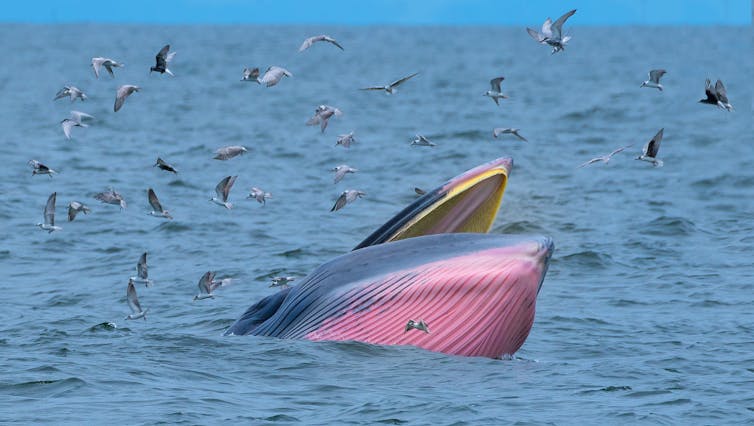
In 2011, researchers observed a previously unknown feeding strategy in whales, now called tread-water feeding or trap-feeding. It was thought to be a new technique developed by specific whale communities.
Trap-feeding is one of several whale feeding strategies first recorded in recent decades, including lunge feeding, lobtail feeding and the dramatic bubble-net feeding, when whales create a fence of bubbles to herd krill or fish together.
In trap-feeding, whales lie at the surface of the water with their mouths open. This allows shelter-seeking prey species such as herring and krill – which do not perceive a stationary object as a threat – to shoal into their open mouths. The whale then heaves its mouth closed, trapping hundreds of prey in a single gulp. This behaviour has been observed in the Gulf of Thailand in Bryde’s or Eden’s whales, and in Canada in humpback whales.
But it appears parallels to this behaviour were also documented in medieval literature, as we describe in a new paper published today in Marine Mammal Science.
The Hafgufa
There are striking parallels between trap-feeding and the hunting strategy of a monstrous sea creature called the “hafgufa”, described in medieval Scandinavian manuscripts.
The mid-13th-century Old Norse text Konungs Skuggsjá (the King’s Mirror) says of this creature:
‘when it goes to feed, it gives a great belch out of its throat, along with which comes a great deal of food. All sorts of nearby fish gather, both small and large, seeking there to acquire food and good sustenance. But the big fish keeps its mouth open for a time, no more or less wide than a large sound or fjord, and unknowing and unheeding, the fish rush in in their numbers. And when its belly and mouth are full, [the hafgufa] closes its mouth, thus catching and hiding inside it all the prey that had come seeking food‘ (M. Firth, Trans.).
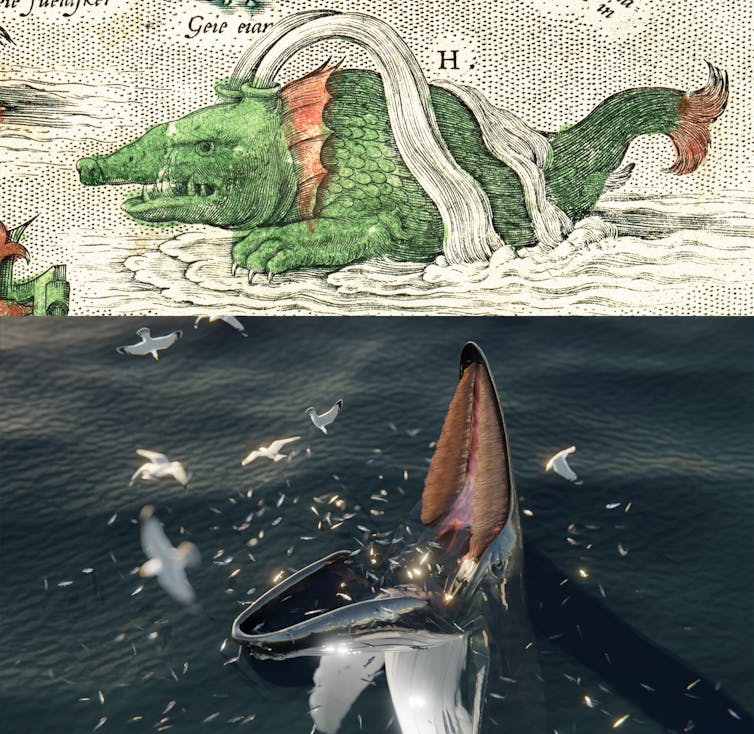
Although this text exaggerates the creature’s size, the other details match trap-feeding surprisingly closely. Even the hafgufa’s belch may correspond to reports of rorqual whales expelling a surplus slurry of water and food particles as they filter and swallow their prey.
Interestingly, the creature is not described as a fantastical monster, but as a fish, a term often used interchangeably with whales in medieval sources.
Ancient Parallels
If these medieval Scandinavian texts really are describing trap-feeding, it demonstrates the technique is much older than previously thought. So, we examined other pre-modern descriptions of sea creatures looking for parallels.
Many of the texts had been adapted or translated directly from earlier texts, so it was impossible to know if the community which produced them had first-hand experience of trap-feeding. However, in some texts new accurate details had been added, suggesting an eye-witness connection.
The earliest of these, an ancient work on natural history called the Physiologus, was compiled in Egypt and dates back nearly two millennia.
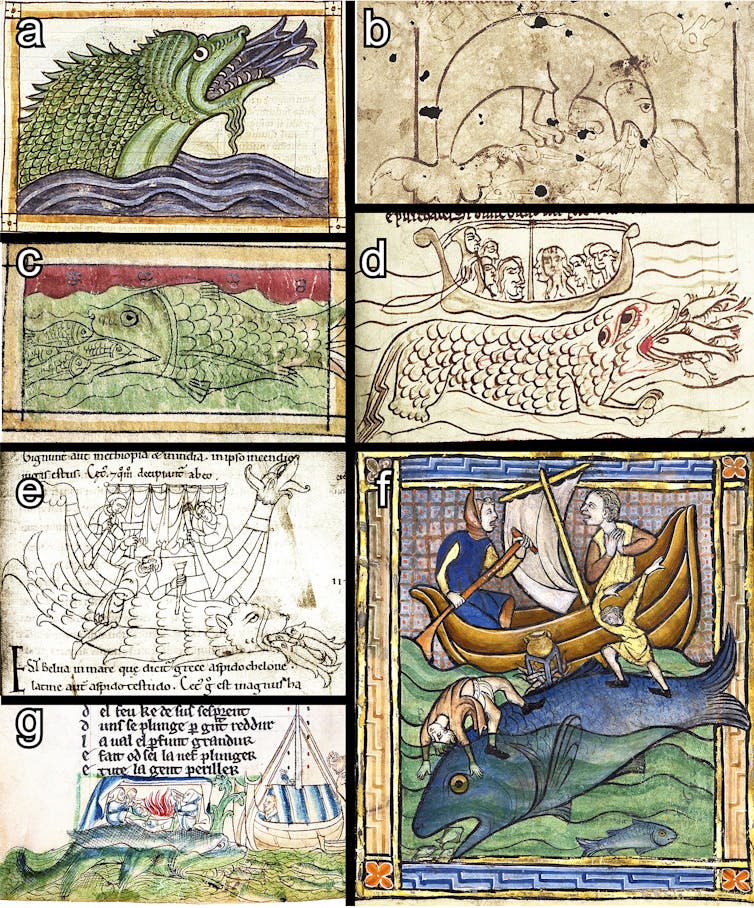
How Did We Not Notice This Before?
But if trap-feeding was first recorded 2,000 years ago, why has it not been reported in modern times until 2011?
One possible explanation is that the devastating effect of historical whaling has caused whale numbers to remain much lower than they were in medieval and ancient times. North Atlantic humpback numbers are estimated to be only a fifth of their pre-industrial whaling levels.
Trap-feeding may be a response to higher population density. Just this month, new research on Australian humpbacks showed that whalesongs are becoming less frequent as populations recover from whaling and competition for mating becomes more intense.
The rise in whaling in the 17th and 18th centuries was accompanied by developments in technology and a corresponding prejudice against medieval society, which was increasingly seen as backwards, unscientific, and superstitious.
However, the most fantastical descriptions of the hafgufa are actually from 17th- and 18th-century writers, who conflated the creature with all kinds of other sea monsters, such as the kraken, resulting in a general confusion about the nature of this creature in modern times. One notable recent depiction of the hafgufa in the popular PlayStation game God of War Ragnarök even depicts it as a giant jellyfish!
In conducting our research, we spoke to marine biologists who assumed it would simply be impossible to determine how long whales had been trap-feeding. So, this multidisciplinary research provides evidence from an unexpected quarter, and may highlight new avenues for researching our marine past.
It also shows that although medieval and ancient people did not have modern scientific frameworks to interpret the natural world, their observations can contain unique evidence of natural phenomena and may be more accurate than we realise.![]()
John McCarthy, ARC DECRA Fellow, Flinders University; Erin Sebo, Associate Professor in Medieval Literature and Language, Flinders University, and Matthew Firth, Associate lecturer, Flinders University
This article is republished from The Conversation under a Creative Commons license. Read the original article.
Loneliness Is Central To Perinatal Depression
Wastewater Sector Emits Nearly Twice As Much Methane As Previously Thought
- Daniel P. Moore, Nathan P. Li, Lars P. Wendt, Sierra R. Castañeda, Mark M. Falinski, Jun-Jie Zhu, Cuihong Song, Zhiyong Jason Ren, Mark A. Zondlo. Underestimation of Sector-Wide Methane Emissions from United States Wastewater Treatment. Environmental Science & Technology, 2023; DOI: 10.1021/acs.est.2c05373
- Cuihong Song, Jun-Jie Zhu, John L. Willis, Daniel P. Moore, Mark A. Zondlo, Zhiyong Jason Ren. Methane Emissions from Municipal Wastewater Collection and Treatment Systems. Environmental Science & Technology, 2023; 57 (6): 2248 DOI: 10.1021/acs.est.2c04388
Albanese government to hike tax on earnings from big super balances – but not until 2025-26
Michelle Grattan, University of CanberraThe tax rate on earnings from superannuation balances above $3 million will double to 30% from 2025-26.
The pre-budget decision – approved by the government’s expenditure review committee on Monday and ticked by the cabinet on Tuesday morning – cuts off what was becoming a potentially damaging debate for the government.
The timing of its implementation – not until the next parliamentary term – also seeks to neutralise the “broken promise” argument. Prime Minister Anthony Albanese said before the 2022 election that Labor had no intention of changing superannuation arrangements.
“No superannuation tax change proposed by the government will take effect this term of parliament,” Treasurer Jim Chalmers said on Tuesday.
But the government will introduce legislation for the measure “as soon as practicable”.
The decision was announced by Albanese and Chalmers at a news conference.
At present earnings from superannuation in the accumulation phase are taxed at up to 15%.
The Treasury’s statement of “tax expenditures”, also released on Tuesday, shows super tax breaks make up a third of the more than $150 billion annual total of the top ten tax expenditures.
Chalmers pointed out the majority of the about $50 billion in super tax breaks go to high income earners.
The tax change will bring $900 million over the forward estimates, $2.3 billion in its first full year, and $3.2 billion over five years.
What the government terms “a modest adjustment” is not retrospective – it applies to future earnings.
The government said the change would only affect 0.5% of those with superannuation accounts – some 80,000 people. These people will continue to have the current 15% rate on earnings from the $3 million below the threshold. The change does not limit the size of account balances.
Chalmers said the threshold would not be indexed, meaning that in time, more super accounts would be drawn into paying the 30% rate.
The treasurer said the measure was to improve “the structural position of the budget” – it was not about using the money for another purpose.
Chalmers said the “Tax Expenditures and Insights Statement” showed more than 55% of the benefit of superannuation tax breaks on earnings went “to the top 20% of income earners, with 39% going to the top 10% of income earners”.
A “tax expenditure” is where certain taxpayers or activities receive special treatment. They include, for example, concessional rates, discounts, exemptions and rebates.
The statement is required under the Charter of Budget Honesty, which dates from the days of then treasurer Peter Costello.
The latest statement includes a distributional analysis of large tax expenditures which shows a breakdown by income, gender and age.
In 2019-20 91% of the benefit of the concessional tax on superannuation contributions went to people with above median income, and 30% to those in the top income decile, the statement said.
“People in higher taxable income deciles receive a larger share of the benefit due to making larger contributions and paying higher marginal rates of tax, which makes the flat 15% rate of tax on superannuation contributions more concessional.”
Men received an average benefit of $1950; women an average benefit of $1390. This reflected men on average having higher incomes, making larger contributions, and facing higher income tax rates.
People with above median income received 82% of the benefit from the concessional tax on superannuation earnings; those in the top income decile received 39%. Men received an average benefit of $1100, and women $750.
Shadow treasurer Angus Taylor said the super decision broke a promise. “This is the Labor party that says one thing before an election and does something very different afterwards,” he said.
“When the Labor party runs out of money, it comes after yours.”![]()
Michelle Grattan, Professorial Fellow, University of Canberra
This article is republished from The Conversation under a Creative Commons license. Read the original article.
Tiny Environmental Plastic Particles In Mum's Food Reach Unborn Children
Disclaimer: These articles are not intended to provide medical advice, diagnosis or treatment. Views expressed here do not necessarily reflect those of Pittwater Online News or its staff.
